









Shearon Harris Station remains crucial, 38 years after it opened. Now, state and federal leaders envision a much bigger role for nuclear energy.




UNC System CFO Jennifer Haygood discusses how understanding the money offers insights into where the Tar Heel State puts its higher education priorities.
N.C. has spent millions to get highspeed internet service to its small towns with varying levels of success.
N.C.’s private colleges and universities struggle with enrollment; Sen. Sydney Batch brings a new leadership style for minority party; Savannah Bananas’ Gaston County roots.
Photos from the NC Manufacturing Conference, Power List reception and NC Leadership Conference.















Demand for reliable power in the age of climate concerns has brought renewed interest in nuclear energy and questions about how utilities will cover the cost.
BY MIKE MACMILLAN






























26
Growth remains steady in an industry changing with automation, AI and tariffs, plus a shift in attitude about factory work.
A spotlight on how research programs across the state are tackling world problems.
Ten months after Hurricane Helene caused billions of dollars in damages, the region is opening back up to both visitors and new businesses.

Big U.S. companies dominate our annual ranking of the state’s top job-creating projects.
BY LAWRENCE BIVINS






Behind-the-scenes work by these seven economic development leaders have brought jobs and investments to Tar Heel communities.
BY KEVIN ELLIS
JetZero’s pledge to create 14,500 jobs in Greensboro helps cement Piedmont Triad Airport’s reputation as the region’s economic engine.
BY CHRIS BURRITT















N.C. businesses that announced the biggest layoffs over the past 12 months. BY KEVIN ELLIS



The ride’s a bit bumpy in the cage built in the bed of a 2024 Chevrolet Silverado 2500 Z71 off-road model traveling along the sandy beach that is N.C. 12. The truck loaded with a dozen passengers is headed toward the Virginia state line in search of the elusive Corolla wild horses.
“Are any of you afraid of roller coasters?” tour guide Emory Andrews shouts through the open back window of the truck’s cab. “Well, you’re going to have the most fun.”

The ups and downs over the dunes felt like a Tilt-a-Whirl at the N.C. State Fair. “I drive this road four times a day. I’m a true professional,” Andrews, 23, says in a reassuring response to one particularly bumpy stretch of a two-hour tour. The ride produced enough jerks to record more than 4,000 steps on one passenger’s Fitbit, without her leaving the vehicle.
Andrews has worked for about two years for Back Country Safari Tours, one of seven businesses offering wild-horse tours on the northernmost section of North Carolina’s Outer Banks.
“I figure it’s so expensive to live on the Outer Banks, this is one way I can be on the beach every day,” he says. Along with horses, Andrews often sees porpoises and, occasionally, whales and coyotes.
The paved portion of N.C. 12 ends in Currituck County. It continues unpaved along a narrow path of dunes to the west and the ocean to the east for another 11 miles
until reaching Virginia. Here, about 100 or so feral horses, descendants of colonial Spanish mustangs brought by explorers more than 400 years ago, roam freely on 7,500 acres of sandy land. They are joined by about 700 residents in nearby beachfront homes.
Travelers with an appropriate vehicle can travel the road to look for horses or just enjoy the secluded beach. Possibly getting stuck is part of the danger, says Andrews. “For a lot of people, this is their first time driving on the sand when they come out here, and they make some questionable decisions.”
A 1950s-era car draws the attention of passengers for its ability to travel through the sand. “A lot of the people who live down here will buy the stupidest vehicle they can find on Facebook Marketplace and then turn it into a beach vehicle,” Andrews notes. “The moral of the story is, there’s always a bigger redneck.”
Today’s a good day for the tour. Within a half-mile of the pavement turning to sand, four horses are gathered at the water’s edge. Groups see horses on most trips. “If we know it’s going to be one of those days, we’ll drive around the entire area searching for them. Sometimes there’s a chance where you just don’t find one,” the guide says.
The horses and majestic beaches reign, but Currituck is also known for its lighthouse and Whalehead, a restored 1920s-era mansion that is now a museum. In 2023, tourists spent more than $573 million in the county, which has about 32,000 year-round residents.
North Carolina’s official state horses are a unique Outer Banks experience.
A sign on the company truck says Andrews works for tips, and he’s earned something extra today. Our group saw about 20 horses in six different groups, including two foals, both less than 8 weeks old.
“I really enjoy it and being able to show it to other people,” he says. “It’s one of the most touristy things to do, but not in a bad way.”

PUBLISHER Ben Kinney bkinney@businessnc.com
EDITOR David Mildenberg dmildenberg@businessnc.com
MANAGING EDITOR Kevin Ellis kellis@businessnc.com
ASSOCIATE EDITORS Ray Gronberg rgronberg@businessnc.com
Cathy Martin cmartin@businessnc.com
EDITORIAL INTERN Robert Speir
CONTRIBUTING WRITERS
Pete M. Anderson, Lawrence Bivins, Dan Barkin, Chris Burritt, Bill Horner III, Mike MacMillan
CREATIVE DIRECTOR Cathy Swaney cswaney@businessnc.com
GRAPHIC DESIGNER Lauren Ellis
MARKETING COORDINATOR Jennifer Ware jware@businessnc.com
EVENT DIRECTOR Norwood Teague nteague@businessnc.com
ADVERTISING SALES
ACCOUNT DIRECTOR Melanie Weaver Lynch, eastern N.C. 919-855-9380 mweaver@businessnc.com
ACCOUNT MANAGER Anne Brundage, western N.C. abrundage@businessnc.com
CIRCULATION: 818-286-3106
EDITORIAL: 704-523-6987
REPRINTS: circulation@businessnc.com
OWNERS
Jack Andrews, Frank Daniels III, David Woronoff, in memoriam Frank Daniels Jr.
PUBLISHED BY Old North State Magazines LLC
PRESIDENT David Woronoff BUSINESSNC.COM








UNC System CFO Jennifer Haygood joined High Point University President Nido Qubein in the Power List interview, a partnership for discussions with influential leaders. The interview was edited for clarity.
You started as a teacher and somehow ended up in public finance. What is it that you did along the pathway that brought you to this point?
I’ve had a very unconventional path. It was actually in my classroom in New Orleans that I got interested in public policy. An example is when I arrived at my school, the state of Louisiana had recently enacted a number of curriculum changes, and I discovered that I was the only teacher who knew anything about it, because of my Teach for America orientation and training.
Also, during my time as a teacher, the state made a change intended to increase the instructional time. But what I experienced was that my school essentially modi ed how the day was designated, and they cut recess. I would argue we had probably poorer educational outcomes because the students needed that time to release some energy. Adults were implementing a policy in a way that worked best for them, rather than in the spirit of how politicians had intended.
A er I graduated with my master’s in public policy, I originally got a job in juvenile justice and delinquency. I worked for the [state government] section that provided educational services to those who have
Jennifer Haygood, who oversees $12 billion of annual UNC System spending, has deep N.C. roots. The Goldsboro native is a first-generation college graduate who earned a bachelor’s degree at Rice University in Houston, and later, a master’s of public affairs at Duke University. After working for Teach For America in New Orleans, she has had a strong career in public finance, including working for the N.C. General Assembly’s Fiscal Research Division. Since 2020, she has been the chief financial officer of the 17-campus, 250,000-student UNC System, following 12 years at the N.C. Community College System. She has been a director of the $53 billion State Employees’ Credit Union since 2019.
been incarcerated, which was a very eye-opening experience. I later joined the research division of the General Assembly, which is a nonpartisan sta that advises legislators on budget matters. I ended up on the education team. It was in my work in the scal research division that I really began my path speci cally related to public budgeting and public nance.
How does your role integrate with the different UNC schools?
So I work directly for President Peter Hans and work closely with the UNC Board of Governors, which has the role of governing the system. So part of what me and my team does is support that budget development process and identify what are the budget priorities that we then advocate for with the General Assembly.
e majority of the funds appropriated to our system actually comes to our Board of Governors, and therefore, we support them in the process of allocating their money to our various institutions. Another key role is policymaking, because there are a number of policies that govern how the funds are used. We also have a strong role in monitoring the nancial health of our institutions. ere are a number of actions, particularly when it comes to capital, investments and debt management, that must come to our board.
When I talk to chancellors of various UNC System universities, they say that they get less and less of the budget from the legislature. What is that percentage, or does each school have an allocation that varies?
Support from state funds varies pretty widely in our system, and that is because of the di erent missions of our institutions. Our small baccalaureate institutions tend to be much more heavily funded through the state funds. Our larger research institutions are funded on a smaller proportion because of the diversi ed revenue stream, particularly related to federal research and institutions that have medical centers. Systemwide, about 31% of our institutions’ revenue come from state appropriations.
What about capital expenditures? Is that a special allocation?
We work very closely with the institutions on capital investments, which are received through a variety of funds and sources. We’ve been very fortunate over the last four years to receive signi cant public investments in our capital facilities thanks to the generosity of the
General Assembly through the state capital and infrastructure fund. Our state has made an intentional shift away from bond financing for capital improvements to a pay-as-you-you go cash approach. Over the last four years, we have received billions of dollars.
We are primarily focused on repairs, renovation and modernization of our existing footprints, and that will continue to be an emphasis. That is for the core academic student support buildings.
What’s the most complicated part of your job?
When you look at everything from our research-intensive institutions all the way to our small, niche institutions, it is challenging to try and make sure that you are trying to serve our institutions equitably. They’re so different.
How do you approach the efficiency and productivity issue that is a big issue in higher education these days?
We want to ensure that every dollar that is committed in the $12 billion is in fact needed as presented. This is an area that we’re constantly trying to evaluate and improve upon. The UNC system benefits from being a system where we have the opportunity to implement various shared services. We have the opportunity to more efficiently provide particularly back office services.
From a policy perspective, we have really begun to set clear expectations. Recently, our Board of Governors adopted a policy on faculty workloads, expecting that institutions have more robust policies locally that conform to that statewide policy. That’s a perfect example where one size doesn’t fit all. Given your research intensity, you are going to have naturally different loads across our institutions, but we wanted to set a consistent baseline expectation.
There’s a lot of focus on incentives on improving graduation rates, reducing debt, moving students through their programs on time. How do you get involved in that or is that left individually to each campus?
No, this is definitely part of our work. In the incentive structure implemented by our Board of Governors, for both President Hans and our chancellors, part of their compensation is explicitly determined based on campus performance. There are a variety of metrics, and we have been working to connect our funding model with these metrics.
I’ve been deeply involved in that work, to determine a portion of an institution’s state funding is based on how they are performing on a set of metrics as compared to their baseline and what we have set as a stretch.
How do you do that when each institution has its own differences?
We assess each institution as compared to their baseline, so we are judging their progress in the performance period. For each institution, we have set a customized goal that is based on their baseline and how much growth we would expect given benchmarks from national data. We’re looking at what type of progress we could expect from high-achieving institutions, which helps determine our goals.
Do you think there are misconceptions about government budgeting and higher education budgeting? And if so, what troubles you the most about the misconception.
I fully understand why this is so frustrating to the average lay person. But not all money is fungible. In a private setting for the most part, money is fungible, you can pretty much use it typically for any purpose that the CEO wants. But in the public sector, we have to follow what’s called fund accounting. We have to track all these different pots of money. Oftentimes, it can be very frustrating.
You may have to cut in one area, while something else is going on in a different area that is supported by a different revenue source that is dedicated to that activity.
When I was working at community colleges, there were certainly times where a school’s position was tight. We had to make some cutbacks that resulted in perhaps individuals being laid off, which obviously always is very challenging for the organizations.
But that organization may still have money to make capital investments.You can’t necessarily always use the funds for any purpose you want.
In spite of all those complexities, you’ve done some great things in the UNC System. We are the envy of many systems around the country. People admire North Carolina for its educational assets that are used to create a workforce. People want to come here. What accomplishments are you very proud of?
Many people may not be aware of the fact that we have kept undergraduate resident tuition flat for nine years. The national media obviously talks a lot about skyrocketing costs of college, and a lot of people don’t realize that the UNC System is bucking that trend.
At the same time, our investment from the state has grown 32% since 2020. We really feel like we’ve strengthened that basic compact around public support and public access to our institutions. I’m also very proud of the investment that has been made in our capital facilities and we are beginning to have that stable investment and repair and renovation budget so that we can be better stewards of our existing physical footprint.
I’m also proud that a couple years ago, we implemented a system requiring all of our institutions to have an all-funds budget. As I mentioned before, the state appropriation is about 31% of our total revenue, and so there is a much bigger picture that we need to ensure that we have our eye on. The implementation of the all-fund budget was a big step forward to ensuring that there was transparency about the comprehensive nature of those decisions.
If someone says to you, what makes for good government, what would you say?
Something that’s very important to me is the concept of stewardship. Particularly when you’re in the public sector, you are obviously spending other people’s money. It’s really important from my perspective that you approach your decision-making with that spirit of stewardship. How can I make the best value with these limited resources? I think that it’s really important that we make decisions in a transparent manner. And with that transparency comes accountability, a responsibility that my team and I take very seriously.
Would you recommend to future students at Duke or Rice that they go into this field that you’re in? Or do you say to them, heavens no, there are lots of other ways you can make a living?
I certainly would recommend that any young person consider public budgeting and public finance. I believe public budgeting is where policy meets reality. A lot of people may see a budget as a set of numbers, but I would argue that if you take a little time and learn what those numbers represent, you will really better understand the values and the strategy of an institution or a system like ours.
I have a front row seat to almost every important policy and social issue that our society is facing. I think it is extremely challenging and very interesting, but it is also where you really can have some influence. If you actually want to try making a difference and influence decisions, understanding the money, it’s a great way you can have some impact.
It is increasingly complex and there are fewer and fewer people, quite frankly, who understand how all of these revenue funds come together. I had the privilege last spring of being able to co-teach a class on public budgeting at Duke’s Sanford School. I hope that at least a few of my students were persuaded that this may be an area that they want to consider for a career. It’s a great opportunity to have substantive input and do work that really matters. ■












Everything’s online, but not everyone, especially in rural N.C. Funds for universal access are plentiful, but expertise and results differ by county.

BROADBAND: WHO’S PAYING?
Federal and state funding are helping close North Carolina’s digital divide. Here’s how large potions of the money is flowing.
$987 million
ARPA (AMERICAN RESCUE PLAN ACT) FUNDING
For Infrastructure ($937 million):
GREAT Grant ($350 million) The Growing Rural Economies with Access to Technology Grant pays privatesector broadband providers to deploy “last-mile” broadband infrastructure to unserved areas of North Carolina. It is part of the NCDIT Broadband Infrastructure Office.
CAB ($400 million) The Completing Access to Broadband Program utilizes ARPA funds to create partnerships between counties and the state.
Stop-Gap Solutions ($86 million) Provides funding for households unserved or underserved.
Broadband Pole Replacement ($100 million) Funding to broadband providers for eligible pole replacement costs.
Broadband Mapping ($1 million)
Other: BAND-NC Building a New Digital Economy funding provides mini-grants to N.C. communities. It’a partnership between the NCDIT Broadband Infrastructure Office and NC State’s Institute for Emerging Issues, with principal support from the John M. Belk Endowment.
For Awareness and Digital Literacy ($50 million):
Includes $44 million in grants awarded to 74 organizations/state government entities to serve almost all counties.
$1.53 billion
For BEAD - Broadband Equity, Access and Deployment ($1.53 billion):
To make sure all North Carolinians can access reliable high-speed internet by 2030. The state is now focused on ensuring accuracy of service maps and a sub-grant program.
Source: N.C. Department of Information Technology

BY BILL HORNER III



Althea Riddick and Erna Bright helped make Gates County a rural broadband success story.


When it comes to broadband, the line of demarcation between North Carolina’s haves and have-nots is nearly always a function of population density and geography.
Money also helps, so let’s start there. Since former Gov. Roy Cooper allocated $10 million from 2018’s GREAT grant program, broadband-dedicated funding has increasingly flowed fast and free. With 91% of North Carolina’s households now connected to reliable high-speed internet, our state is among the leaders in closing the gap between the served and unserved. That is the result of an amalgamation of acronymic projects — BAND-NC, CAB, and BEAD, followed GREAT, with $987 million in ARPA funds as the primary war chest. It’s crowned by an additional $1.53 billion (from the federal 2021 Bipartisan Infrastructure Law) to ensure all residents can access reliable high-speed internet by 2030.
Gatekeepers and bean counters in Raleigh now mostly agree there’s enough money to make it happen.
In the rural parts of N.C., though, cashing in on grants and executing a plan are exercises riddled with complexity.
“You can’t just say, ‘Here’s a million dollars — turn on a router.’ Right?” says Nate Denny, the former deputy secretary for Broadband and Digital Opportunity in the N.C. Department of Information Technology. “These are two- to three-year construction projects. Someone’s got to dig a ditch. Someone’s got to hang a line on a pole.”
It doesn’t help that the BEAD grant, for example, has been described as “a Frankenstein monster” with an overwhelming application process that leaves too many applicants at the trough.
Most of us treat a high-speed connection like a birthright. We’ve also felt the pain and helplessness of disconnection. That’s an anguish that more than 380,000 N.C. households might like to experience, even just once. First, though, they need access.
We’re getting there. The pandemic and subsequent school shutdowns led to an embrace of a strong internet connection as a utility. Growing healthcare and workforce applications make broadband more than just a shopping or gaming or streaming cheat code.
Everything’s online, but not everyone. Dave Kaiser, the senior director of Policy, Advocacy and Innovation for the N.C. Rural Center, says in the state’s 78 rural counties, closing service gaps and making “last mile” connections requires more than just effective utilization of funds.
Kaiser has worked in 33 rural counties. He celebrates the local champions who have strategically accessed and deployed funding, but bemoans it when “overstretched and under-capacitated counties” fumble opportunities.
“They say, ‘Oh my gosh, I’ve got to run a $10 million broadband internet program, and I don’t even have broadband myself,’” he says. “We called up a county manager who’s got their name all over these documents, and asked, ‘What programs are you referring to again?’
This individual doesn’t even live in the county, but serves that county, and they had no idea what I was talking about. That’s the problem.”
It’s exacerbated because the lower population density in rural N.C. means a lower ROI for providers who are awarded funding. Geographic impediments — think mountains, swamps, dense forests — multiply the difficulties of isolation, as do comically inaccurate service maps (some manipulated by contractors) and installers who doggedly, but incorrectly, insist that this grain bin or that abandoned hog house should be wired.
“Broadband kind of works like water,” Kaiser says. “You know, it goes toward the path with the least resistance.”
If they handed out a blue ribbon for connecting broadband in rural North Carolina, it’d go to Gates County. The stubborn resolve of thenCounty Commissioner Althea Riddick and the legwork of Erna Bright Jr., a Gates resident with 40 years of telecommunications experience, gave the county’s 10,343 residents a formidable one-two punch.
Riddick, a Gates native, retired in 2020 as Elizabeth City State University’s registrar and associate vice chancellor for Continuing Education. Around that time, as a new commissioner, she began hearing about struggles students faced finishing classroom assignments because of a lack of internet, and about funding programs designed as a fix.
She enlisted Bright to work as the county’s liaison with internet service providers, or ISPs, focusing on service maps and the finer technical points of deployment. Meanwhile, Riddick watched the dollars, particularly ARPA funds, and worked the phones, tracked policies, pushed administrators and legislators, and smoothed out snags. In time, she became a trusted, insightful voice in northeast N.C. And, out of necessity, a patient one.
“Some people, because they have a cell phone, they think they know fiber,” she says. “Because they get internet at their house, they think they understand how it works.”
Beginning in 2021, Riddick and Bright helped drive the accessibility rate in Gates from 25% to 97% by early 2024. It now sits at 99%, eons ahead of surrounding counties. Chowan County is a distant second at 48%.
“It wasn’t for the faint of heart,” Riddick says. That’s truer than you might imagine. A year ago, sitting in the county manager’s office, Riddick suffered a heart attack. After open-heart surgery, she’s recovering and still consulting on the regional and state level, despite losing her re-election bid after limited campaigning.
Delivering broadband in a lightly populated county such as Gates might seem an easier proposition, but the county’s ancient and often inaccurate utility maps proved especially problematic. As did the Great Dismal Swamp, low utility poles, and potential ISP contractors who were no-shows.
Riddick is fond of saying that in the old Gates County, you could click on “download,” cook a full meal, and then, if you’re lucky, have the file in hand by the time the dishes were cleared.
Now it’s lightning fast. She and Bright earned “Community Advocate of the Year” awards at this year’s N.C. Rural Summit. They were lauded for painstakingly navigating the choppy seas of deployment. The pair had regular Zoom update meetings and frequent late-night brainstorming calls. That is, while Bright wasn’t driving endless miles on county roads he’d not seen before (and to neighboring counties, as a favor) and while Riddick wasn’t dealing with angry constituents who’d had water lines accidentally cut by ISP contractors.
Most of all, their work was about paying attention.
Legislation, Riddick says, was “all over the place. Gov. Cooper was saying one thing, but the federal government was saying something else.” With attention, it was possible to know what questions to ask.
“You need boots on the ground, right?” Riddick says. “Because if you don’t, then you get what you get. And if you only have so many dollars, you’ve got to make every dollar count. And if you know your county and know where people need service, you need to get somebody there — to say, ‘This is where the fiber needs to go,’ and then work with them to see how best to get it there.”
Hurdles remain. Most broadband is fiber, and until satellite technology gets more reliable and affordable, last mile connections — the high-cost, low-ROI proposition ISPs face reaching end-of-the-road customers — means that 100% coverage is a big ask, especially in rural N.C. But 99% is eminently feasible. There’s also help. In addition to the N.C. Rural Center, the state’s Department of Information Technology focuses on policy development, grants and compliance, deploying its own assets to track money and hold providers accountable. They assist when local perspective, local engagement and local expertise aren’t enough to crack broadband’s byzantine framework.
Still, Angie Bailey, director of NCDIT’s Broadband Infrastructure Office, says broadband providers are under huge pressure to move quickly.
“I think we’re kind of moving as fast as the state can absorb,” she says. “And it’s really important that, as this service is built out, people do choose to adopt it — because utilizing it is the key to the kind of transformation that can happen. Broadband providers can only continue to build if people are adopting the service too.”
Denny, the former NCDIT leader who now works as a consultant, is confident that N.C. can get the job done.
“Someone will get in big trouble,” he says, “if there’s anyone who doesn’t have the internet in five, six years, as a result of all this funding.” ■
Bill Horner III is a third-generation newspaper publisher who was an owner and editor of The Sanford Herald and the Chatham News + Record. He and his wife Lee Ann live in Sanford. Reach him at bhorner@businessnc.com.

Most of North Carolina’s private colleges are struggling to grow their enrollments.



By Robert Speir and David Mildenberg
Attracting students to North Carolina’s private colleges is an increasing challenge, a study of recent enrollment trends indicates.
Twenty-eight of the state’s 38 private institutions of higher education with at least 500 students reported enrollment declines over the past four years, according to statistics compiled by the National Center for Education Statistics. Overall, 13 schools reported declines of at least 15%.
High Point University and Cabarrus College of Health and Sciences reported some of the strongest enrollment growth. High Point gained 8% over four years to more than 6,000 students. In September, it said enrollment totaled 6,335.
e fastest grower was Concord’s Cabarrus College of Health and Sciences, which added 227 students, a 43% increase. e college focuses on producing nurses, medical assistants, respiratory therapists, surgical technologists, occupational therapy assistants, and more. Started in 1942, it operates on the Cabarrus County campus of its partner, Charlottebased Atrium Health, which is North Carolina’s largest hospital operator.
“When people ask me how we have done it, and they hear about this renewal, I say there is no magic formula,” says President Damián Fernández, who is in his third year leading the campus. “We promised better outcomes and we reduced the price.”
Last year, Warren Wilson cut its stated tuition from $41,500 to $25,500. e college formed in 1894 has had a balanced budget in the past two years, a er posting several annual losses, Fernández says. It also reports record fundraising, including a $10 million gi in December from an anonymous donor that boosted its endowment by nearly 20%.

Another school bucking the enrollment trend was Warren Wilson College in Swannanoa, where enrollment gained 13% to 797. O cials credit an emphasis on experiential education, including internships and careerrelated experiences that are required for each student.
But those are the exceptions. Most N.C. private colleges are encountering enrollment challenges, both in small towns and big cities. Factors include the waning number of U.S. high school graduates and more students opting for trades-related education.
Among the institutions with the largest percentage declines in recent years were for-pro t Strayer University, which o ers classes in Charlotte, Greensboro and Raleigh; Chowan College in Murfreesboro; North Carolina Wesleyan University in Rocky Mount; and Shaw and Saint Augustine’s universities in Raleigh. e private schools face tough competition from the UNC System, which has reported a 10% increase in enrollment since 2021. e 16 campuses enrolled about 248,000 students last fall. at was about 23,000 more students than a decade earlier.
e UNC System hasn’t raised instate tuition rates for nine years, which is unmatched nationally, o cials say. Tuition for out-of-state students has increased, along with fees for parking, housing, food and other services that have risen over the past decade.
Only one private college in North Carolina has closed in the past decade: St. Andrews University in Laurinburg announced it would end operations as of May 5. e school “reached a point where nancial sustainability is no longer attainable,” President Tarun Malik says. Once a liated with the Presbyterian church, St. Andrews formed in 1958 a er the merger of two other schools.

Another college, John Wesley University of High Point, merged into Piedmont International University in Winston-Salem in 2018.
Other schools face tough decisions. Saint Augustine’s University said it enrolled 200 students in the 2024-25 academic year, down from more than 900 a year earlier. e historically Black college lost its accreditation earlier this year.
In May, Guilford College Provost Kami Rowan wrote to faculty of the Greensboro institution: “Without signi cant changes to our nancial model, we simply do not have the cash ow or revenue to continue operating.” e school pledged to raise $5 million by its scal year ending on June 30.
Many N.C. private colleges remain robust nancially because of strong alumni support and solid endowments. For example, Catawba College in Salisbury has received more than $200 million in recent years from an anonymous backer. Salisbury businessman Fred Stanback, a college roommate of Warren

Bu ett, is believed to be the donor, but that has not been veri ed. Catawba enrolled 1,241 students last fall, about 9% fewer than three years earlier.
N.C. private colleges include Duke University, which has an endowment of about $12 billion; Wake Forest University, with an endowment of $1.8 billion, and Davidson College, with a $1.3 billion endowment. e trio remains highly selective and have annual tuition in the $70,000 range. Each campus provides substantive nancial aid to many students, reducing their out-ofpocket cost by tens of thousands of dollars.
Keeping college a ordable and relevant is a daily challenge for colleges, with potential students from families with household incomes of $75,000 to $110,000 opting out of college at the fastest pace of income groups, says Warren Wilson’s Fernández. “We want to tell those middle-class families that Warren Wilson is an option for you,” he says. “Private colleges are important for many reasons, including the democratic vitality of our nation.” ■







Sydney Batch toppled a legendary leader to take charge of N.C. Senate Democrats. Can she make her party relevant on Jones Street?




TBy Ray Gronberg
he internal geography of the state Senate within the capitol is telling. President Pro Tem Phil Berger and his double-digit sta command a six-o ce secondoor suite overlooking Jones Street, with over ow space downstairs.
His Democratic counterpart, Wake County Sen. Sydney Batch, gets a three-room o ce on the rst oor that looks out into one of the building’s internal courtyards — and directly up at the Berger operation. She has three aides.

Time will tell if Batch, who became leader of her party’s Senate caucus can somehow ip that script. A start would be cracking the supermajority that Berger has enjoyed for much of his tenure.
So far, Batch’s signature moment was convincing her Senate peers to install her as the Democratic leader in place of fellow Wake County Sen. Dan Blue. He’s a family friend she has known since she was 5 or 6 years old.
“I’m a rm believer that we at this time and in this political space need to be more bullish,” Batch says of the decision to challenge Blue for caucus leader a er last fall’s general election.
“We are two very di erent types of leaders. ere’s no one way to do it right; I just do it very di erently. And so I’ve told my caucus time and time again that I don’t promise to do it better. I promise to do it di erently. And in doing it di erently, I hope that we have some better outcomes.”
At 76, Blue is the legislature’s longest-serving member, having racked up 22 House or Senate terms in a career that stretches back to 1981. at includes a stint as the House Speaker. Batch, by contrast, is in her third Senate term and fourth legislative term overall a er losing re-election to a House seat in 2020. She is 46.
Batch is a family law lawyer who co-founded her Raleigh rm,

Batch Poore & Williams. It now has ve other lawyers, including her husband, Patrick Williams. She entered politics in 2018 a er having fended o a couple of previous recruitment e orts.
e timing was right in part because her two children were entering kindergarten. She also says she was increasingly frustrated by issues facing her clients.
One, for example, was going to lose her insurance a er a divorce. Another had been a stay-at-home spouse who needed job training to get back into the workforce. en there was what Batch calls “a very broken and fractured” foster care system.
“I kept on confronting issues that were state-level policy issues, things that my clients were having a really hard time trying to address,” Batch says. “So I nally woke up one day and said, if I am in a situation where I have the ideas, I have the experience because of my work within communities and within the court system to change it, then why not me?”
Batch won a House seat in her rst campaign, but lost two years later in 2020 to Republican Erin Paré in a district that covered much of southern Wake County. She wound up returning to the capitol anyway, as Wake County Democratic Party leaders had her appointed in January 2021 to replace former Sen. Sam Searcy, who unexpectedly resigned.
Her current Senate district covers much of western Wake County, including Apex, Morrisville and parts of Cary and Holly Springs. Wake is home to “a lot of transplants,” as Batch puts it, which she says informs her thinking about how to reduce the GOP’s current 30-20 margin in the Senate.
Democrats on the campaign trail have to address their message delivery, branding and candidate recruitment if they’re to make inroads within the gerrymandered districts that Berger and his team have created, Batch says.
When campaigning, she says, she’d run into people who’d tell her “‘I was a New York Republican, but I don’t know what this North Carolina Republican is like. It’s a di erent brand of Republican.’”
“So we have the opportunity to be able to speak to voters in a way … that looks more like what they’re used to,” she says.
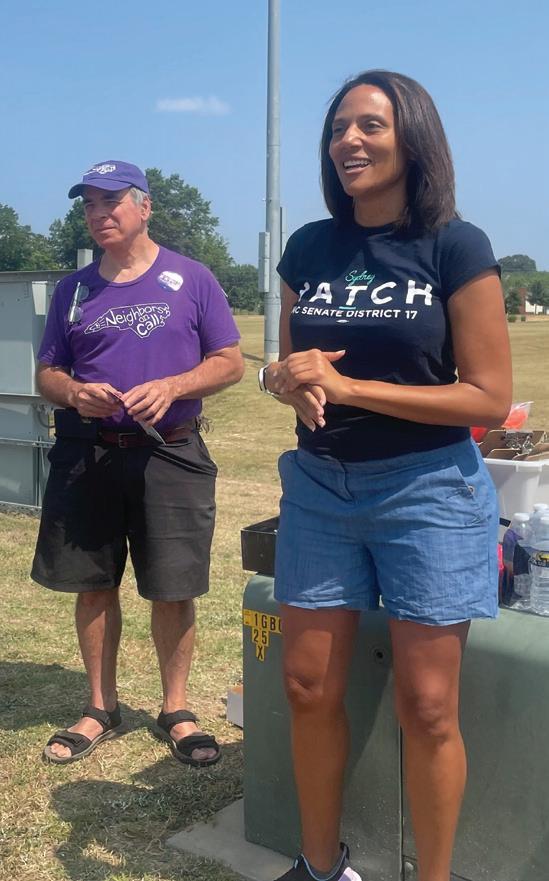


Message-wise, Batch took an immediate step to raise her party’s pro le by making herself or other Democratic senators available to talk with reporters a er legislative voting sessions. e practical e ect is to make sure that Berger’s regular 10-minute confabs with the press corps don’t give him the day’s only or last word.
Batch has also made sure that each member of the Senate Democratic caucus takes point on a policy area, and gets some exposure.
“What I said is, ‘I want to make sure that I elevate you all and allow for you guys to shine in the ways in which you are experts in your area,’” she says. “I believe knowledge is power. I believe it should be shared by many.”
On the communications front, Batch is “very willing to be more aggressive in oor debate, and she has a more clear strategy for public communications than what we’ve had in the caucus before,” says Sen. Graig Meyer, who is from Orange County. at translates into “probably a more aggressive attempt to use amendments and the rules” to make political points, he says. at’s played out in a trio of high-pro le debates, involving the Senate’s budget bill, a proposed loosening of concealed-weapons laws and on Berger’s “DAVE Act” that would encourage State Auditor Dave Boliek to go a er state government ine ciency in the manner of the federal DOGE e ort.
Batch’s approach, House Democratic leader Robert Reives says, is about “trying to make sure that a lot of what happens in the building is something that can be absorbed by the average voter.”
e real test — the 2026 election — is still more than a year o .
Batch says the N.C. Democratic Party, under State Chair Anderson Clayton, is working more on building strength at the municipal level. Finding would-be senators is up to the incumbent leaders.
“I believe it is my job as leader of this caucus to go ahead and recruit some of the best candidates that we possibly have that t their district, that can win seats,” she says. “ at is our job. at’s our responsibility. We have to do the heavy li ing of raising the money and resources in order to put them on television. And that comes
HOMETOWN – Chapel Hill
EMPLOYER – Attorney with Batch, Poore & Williams
EDUCATION – Bachelor’s, master’s and J.D., UNC Chapel Hill
FAMILY – Husband and two sons
FAVORITE TRIANGLE HANGOUT –
Jaguar Bolera, a Raleigh restaurant with duckpin bowling lanes
FAVORITE MUSICIANS – Meghan
Trainor and Kendrick Lamar
at a high price for many of our caucus members who give money to competitive races.”
Indeed, Berger’s secret sauce during his 14-year tenure as the Senate leader is that he’s a champion fundraiser. His campaign committee collected $3.2 million in donations in the last cycle and sent more than $2.5 million to party and caucus groups.
at helped fuel the successful re-election campaigns of Republican Sens. Michael Lee of Wilmington and Lisa Barnes of Nash County, who won in fairly competitive districts. ey received $2.3 million and nearly $1.8 million in caucus funding, respectively, according to TransparencyUSA.com.
With the Senate GOP holding the exact two-thirds margin to maintain a veto-proof supermajority, a loss in either race would have changed the political dynamic signi cantly.
e minority party is always at a disadvantage when it comes to fundraising, and Democratic Senate leader Blue raised only $478,907 in 2024, with $360,900 going to caucus or party groups. Batch, who was one of Blue’s key deputies, raised $443,712 and sent $327,500 of that to the party.
Reives, for comparison, raised $764,253 and dispatched $365,569 to the party. e rst nance reports from the new election cycle are due in July.
“What the di erence is, in my opinion, that you see with us and Republicans right now is at the end of the day, Republicans understand the assignment,” Reives says. “And the assignment is they’ve got to win seats. e assignment isn’t that they’ve got to, you know, like each other and make everybody happy. ey’ve got to win seats. And so they tend to have less wasted motion.”
For his part, Meyer says the Democratic caucus picked Batch speci cally to shake things up.
“ ere de nitely were people who supported Sydney for leader because they express things along the lines of, ‘We just have to do something di erent,’” he says. “ ey wanted to be more aggressive, or they wanted to try di erent things. I think that those folks felt like we were at risk of a level of complacency that leaves Democrats being in a permanent minority.” ■

Gaston County’s Jesse Cole is hitting it out of the park by putting fans first.





By Kevin Ellis




The Savannah Bananas do play baseball, even if they have evolved the game beyond what Abner Doubleday envisioned in 1839. ere are still four bases, points out Jesse Cole, the genius behind Savannah Banana Ball.
But the phenomenon, which has deep roots in North Carolina, has taken the country by storm by o ering plenty of family-fun tweaks to the Grand Old Game.
Now in their h year, the Bananas have 10.2 million followers on TikTok, compared with the New York Yankees’ 1.7 million. eir videos get tens of millions of views. Television’s top-rated news show, “60 Minutes,” pro led the team in April. In June, the Bananas sold out the 75,000-seat Bank of America Stadium on two consecutive nights.

At the home of the NFL’s Carolina Panthers, the Bananas competed against the Party Animals, who won one of the games.
Among the Bananas’ rules: teams earn 1 point for winning an inning, so the total number of runs doesn’t matter; hitters are declared out if a fan catches a foul ball; a hitter who draws a walk can run the bases until each defensive player touches the ball.
But the real show involves the players – and umpires – singing, dancing and turning routine plays into theater with back ips and hotdoggery. ere’s even more pizzazz o the eld, too.
“What people don’t understand is, the name of our company is Fans First Entertainment,” says Cole, who serves as master of ceremonies in a trademark yellow tuxedo and top hat. “Everyone sees all the social media, all the highlights, but they don’t always see the time that we spent in the upper deck creating fans’ rst moments and how we deliver roses to little girls throughout the crowd and how we spent hours before and a er the game signing autographs. at’s how you build fans.”
Cole grew up in a small town about 25 miles south of Boston. His Bananas journey started when he arrived in Gastonia in 2008 at age 23, having su ered some heartbreak. His dreams of a major

league baseball career were dashed with a shoulder injury as a pitcher at Wo ord College in Spartanburg, South Carolina.
So he took a job as general manager of the Gastonia Grizzlies collegiate summer league baseball team. He wasn’t dreaming yet of selling out stadiums from Anaheim, California, to Miami.
“ at would’ve been impossible,” he says, two days before the Charlotte games. “ e Gastonia team was failing. ere were only a couple of hundred fans coming to the games. I had $268 in my bank account, so it was just about trying to nd a way to make it successful and to get people to come to the games.”
He started studying P.T. Barnum and Walt Disney and found inspiration. “We saw a better way,” he says, donning the bright yellow tuxedo for the games.
e college guys played it straight on the eld, but between innings had permission from Cole to bust a move. In the stands, fans took part in blindfolded pillow ghts, kids smashed pies in their dads’ faces and toddlers raced turtles between innings while munching on “garbage lid nachos.”
Soon, the Gastonia team was averaging more than 2,300 fans per game. Cole bought the team in 2014 and, a year later, received approval for a new collegiate team in Savannah in the Coastal Plain League. e Bananas started play in 2016.
ings started slow in the Peach State. Cole and his new wife, Emily, nearly ran out of money. ey missed payroll and had to sell their Gaston County house and move to Savannah to keep the team a oat. “We were sleeping on an air bed in 2016. We were grocery shopping on $30 a week.”

With antics like “Banana Babies” and “Banana in the Pants,” word spread. “After the failure in the beginning, we started selling out games. In 2017, we sold out every game, in 2018 we sold out every game,” says Cole.
He noticed, however, that no matter how much excitement occurred in the stands, fans were still leaving early at games following traditional rules. In 2018, he sold the Grizzlies. (They have since folded). And he started to think of what his team was doing in Savannah.
His answer was to found Banana Ball in 2021, and get out of the college-ball league. “You start small and dream big,” says Cole. “We started with a one-city world tour [in] Mobile, Alabama.” Then the Bananas did seven cities, followed by 33 cities around the nation.
Now, the team is selling out massive college and pro sports stadiums.
Overnight success? Hardly, says Cole. All of his mistakes have led to the sellouts at this season’s 100-plus-game schedule. He tells of how the team misspelled “banana” with an extra “n” in its first merchandise order.
“When you’re trying to do something new every day, you realize failure is not a scary thing,” says Cole. “Those failures help us get to the next step. We’re not afraid to come back up swinging.”
Cole still calls Belmont home. He and his wife, Emily, became foster parents in Gaston County in 2020 during the pandemic, eventually adopting two children they fostered. They continue to provide respite foster services, part of what keeps them in Gaston County.
Their passion for the 400,000 children in the U.S. without a permanent home has led to their Bananas Foster nonprofit, which raises awareness and money for foster programs at every Bananas event. “It’s about bringing people together and bringing families together,” he says.
As for scaling his business, the Coles plan to start a Bananas’ League next year. He declines to discuss financials, saying that’s not his focus.
“We’re not interested in being a billion-dollar company, we want to create a billion fans,” he says. “I mean, we’re serving 2.2 million fans this year, so literally 2.2 million fans are buying tickets.(They started at about $40 for the Charlotte games.) How can we serve 3 million next year?
“If we take care of the fans, the revenue takes care of itself.”
In Gastonia, the Grizzlies played at Sims Legion Park, a 1950-era ballpark where fans sometimes had to avoid pigeon droppings that often covered the bleachers.
“I don’t remember anything like that,” Cole shoots back. “I remember the Flatulent Fun Night. I remember the Dig to China Night. I remember Midnight Madness. I remember the Grandma Beauty Pageant.
“I don’t remember anything with the pigeon poop. That must’ve been before my time.” ■


































When PNC Regional Presidents Weston Andress and Jim Hansen reflect on the sectors fueling North Carolina’s success in business, the state’s robust higher education system and banking industry rank among the most prominent, with significant connectivity and collaboration between the two.
“As a business leader and native North Carolinian, I have always recognized and appreciated the clear correlation between an educated workforce and a vibrant, sustainable landscape for our state’s financial services industry,” says Raleigh-based Hansen, who leads PNC’s Eastern Carolinas market. “There is little question North Carolina’s banks and businesses benefit from the many efforts of North Carolina’s schools, colleges and universities to equip students for successful careers.”
Just as North Carolina’s higher education ecosystem is cultivating a veritable talent pipeline for finance and business, banks are investing in programs, resources and infrastructure to help bolster and enrich the student experience at local academic institutions.
“As one of North Carolina’s largest banks, PNC is actively engaged with colleges and universities throughout the state in a variety of meaningful ways,” says Charlotte-based Andress, who leads PNC’s Western Carolinas market. “Delivering banking services and financial education to students, funding academic programs and resources, and helping finance essential infrastructure assets are some of the ways we help support the continued excellence of higher education in North Carolina.”
While the college years represent a formative time for students to develop and refine smart money habits, they are unlikely to find Financial Literacy 101 among their schools’ course offerings. To help prepare students for financially secure futures, PNC and its dedicated University Banking team collaborate with institutions to deliver tools and resources, including PNC My Finance Academy, to help students learn how to budget, manage credit and build financial knowledge and confidence.


This is the thirty-eighth in a series of informative monthly articles for North Carolina businesses from PNC in collaboration with BUSINESS NORTH CAROLINA magazine.





“Money management is a core life skill that can help today’s students achieve their future financial goals,” says Jim Redilla, vice president and University Banking relationship manager. “Financial literacy is like any other form of education: It’s meant to help students improve themselves, make better decisions, and succeed in whichever paths they choose.”
PNC maintains University Banking relationships with more than 500 higher education institutions nationwide. In North Carolina, PNC is the Official Bank of North Carolina State University and enjoys University Banking relationships with Fayetteville State University and North Carolina Central University.
“These alliances have created meaningful opportunities for PNC to engage with students, while also supporting institutions that contribute significantly to the state’s economy and talent pipeline,” says Redilla. “For today’s students and tomorrow’s workforce, establishing a foundation for financial education is crucial for future success, and PNC is committed to providing resources and tools to help build that foundation.”









Jim Hansen (left) and Weston Andress (right) outside the PNC Capital Markets Lab at UNC Kenan-Flagler.



















In addition to helping students create a foundation for financial wellness, PNC’s North Carolina-based team has played a role in building the physical foundation for campus resources, including student housing, to meet the needs of students and campus communities.
“PNC’s Public Finance Group is committed to serving the financial needs of the public sector, including institutions of higher education,” says Kyle Huber, senior vice president and relationship manager for PNC’s Public Finance group.
“For example, as regions throughout North Carolina see their populations grow and demand for housing increases, we recognize an institution’s ability to grow enrollment is dependent on a supply of high-quality affordable student housing. And we are doing our part to help finance the development of this necessary infrastructure.”
As colleges and universities evolve to address the unique needs of today’s students and employers, opportunities to create interdisciplinary learning environments abound, and PNC is among the companies investing in resources designed to help develop future bankers and business leaders.
Weston Andress, Western Carolinas: (704) 643-5581
Jim Hansen, Eastern Carolinas: (919) 835-0135









“As students prepare for careers in finance, experiential learning opportunities represent an increasingly important element of academic rigor,” says Hansen, who in January 2025 joined Andress and UNC Kenan-Flagler Business School faculty, students and alumni to commemorate the naming of the PNC Capital Markets Lab.
The PNC Capital Markets Lab, named in recognition of a grant from the PNC Foundation, enables students to leverage sophisticated research and analytics tools, including Bloomberg terminals, to explore financial markets in real time and manage real funds in equity and fixed-income portfolios.
Faculty members describe the lab as a bridge between the theoretical and the practical – where academia and real-world business meet.
Outside the lab, an electronic stock ticker board visually displays the dynamics of the market, bringing both timeliness and relevance to the instruction and learning taking place within the lab’s four walls.
“Banking and higher education are both sectors that have flourished in North Carolina thanks to a legacy of innovation and a vision for the future,” says Andress. “Collaborating with higher ed institutions provides an opportunity for PNC to honor this legacy and contribute to the future success of a state that means so much to us.”








Daimler Truck Financial Services, which provides financing, leasing and insurance options for Daimler Truck North America’s commercial vehicles, will invest $7.8 million for a headquarters that may add 276 jobs with average annual pay of $133,940. The Germany-based company employs about 6,500 N.C. workers making Freightliner trucks and Thomas Built Buses.
Ontario-based AVL Manufacturing, which builds enclosures for industrial power generators, plans to invest $56 million to establish a plant that is expected to create up to 325 jobs. Its products supply backup power to large and hyper-scale data centers, automotive, automation, construction and emergency management sectors.
Atrium Health opened The Pearl, a $1.5 billion innovation district created in partnership with Baltimore-based Wexford Science and Technology. The inaugural class


of Wake Forest School of Medicine will begin classes in the 14-story structure this month, while an adjacent 10-story tower will be home to research and Francebased IRCAD, a surgical training facility expected to attract physicians from across the world.
NASCAR Hall of Fame leaders pitched a $25 million renovation plan to City Council, aiming to expand event space, improve security, and create a dedicated education area. Funded by hospitality taxes, the project would mark the venue’s first major upgrade since opening in 2010.
Walmart is expanding drone delivery here through a partnership with Wing, an Alphabet subsidiary. Three other U.S. cities are part of the rollout, with 30-minute deliveries of groceries and essentials expected within a year. Wing started offering drone deliveries via DoorDash in Charlotte earlier this year.
A federal lawsuit filed in North Carolina accuses Krispy Kreme of misleading investors about its financial performance tied to its McDonald’s partnership. The suit names CEO Joshua Charlesworth and CFO Jeremiah Ashukian as defendants.

Krispy Kreme declines to comment on pending litigation.
American Airlines’ Charlotte hub generates $30.8 billion in annual economic activity, supporting 147,500 jobs and $12.5 billion in wages statewide, according to an NC State study. The airline accounts for 90% of CLT traffic and 70% of all seats across North Carolina. American employs about 15,500 at CLT and 18,500 statewide.
Trimont and DeRiva Energy signed separate leases for more than 100,000 square feet at One South, a 40-story office tower in uptown Charlotte. They are One South’s largest leases to date at the building formerly called Bank of America Plaza. Deriva Energy is owned by Toronto investment company Brookfield. Trimont bought Wells Fargo’s commercial mortgage servicing business earlier this year.
Germany’s BHS Corrugated added 50 jobs at a 25,000-square-foot “experience center” at Ballantyne Corporate Place. The jobs include leadership, service, training, sales, parts, information technology, human resources and finance. German companies employ more than 19,000 people in the metro area.
Pittsburgh-based PNC Bank will acquire Aqueduct Capital Group to strengthen its global capital advisory offerings, particularly in private equity and real assets. Aqueduct will complement PNC subsidiary Harris Williams The deal is expected to close by mid-summer. Terms were not disclosed.
Honeywell will buy Johnson Matthey’s Catalyst Technologies business for $2.4 billion, adding key energy technology. The deal boosts Honeywell’s push into lowemission fuels and continues CEO Vimal Kapur’s $11 billion acquisition spree since late 2023. The company also appointed Marc Steinberg of Elliott Management to its board amid plans to split into three companies. Elliott holds a $5 billion-plus stake and pushed for the breakup.
Charlotte Symphony raised a record $50.1 million in a three-year campaign led by Bank of America leaders. About $40 million will bolster the endowment, with
$10.1 million supporting operations. The symphony has expanded its community reach and programming under new music director Kwamé Ryan.

Billionaire California investor David
Murdock, who changed North Carolina history by buying Cannon Mills in the early 1980s, died at the age of 102. Murdock owned various businesses, including Dole Foods. After selling Cannon, he developed the N.C. Research Center here, and signed annual leases with N.C. universities that provide millions of dollars in funding.
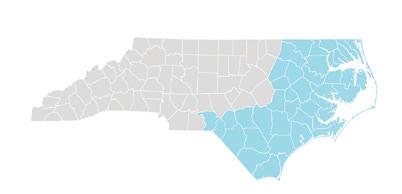
The Trump administration approved a $110 million Biden-era grant to help replace the aging Alligator River bridge on U.S. 64 in eastern North Carolina. Construction began earlier this year and is expected to finish in 2029. Language related to diversity, equity and inclusion, along with climate issues, has been removed from the project.
The UNC Board of Governors named S. Keith Hargrove, a veteran HBCU leader and former Tuskegee University provost, as chancellor of Elizabeth City State University. The university has about 2,100 students and 90 full-time faculty members.

Alpek Polyester will close its plastic resin operations here at the end of July, resulting in the loss of 180 jobs. Mexicobased Alpek acquired the site in 2001 and says the decision will lead to $20 million in annualized savings by 2026. The company recycles plastic bottles.
Cumberland County Commissioners voted 5-2 to cancel the $131 million downtown Crown Event Center project, just seven months after its groundbreaking. The board will now explore renovating the existing Crown Arena and Theatre instead.
Martin General Hospital, closed since 2023, will reopen in several months as North Carolina’s first Rural Emergency Hospital through a $35 million allocation from the state’s $150 million “NC Care” initiative. Run by ECU Health, the facility will offer essential services without full inpatient care. It is 30 miles northeast of ECU Health’s flagship hospital in Greenville.
Software firm nCino plans to cut 7% of its global workforce, mostly in the U.S. The fintech firm has about 700 local employees. It had 1,833 employees worldwide as of
Jan. 31, according to an SEC filing. Live Oak Bank spun off its tech unit as nCino in 2011. It went public in July 2020 and had a market value of $3.2 billion in midJune, nearly twice as much as Live Oak.
Wilmington International Airport approved $78 million for its road, curb and parking garage projects. Capital spending includes $64 million for parking and access roads, plus $7 million for runway upgrades. A terminal expansion will add a fourth gate.
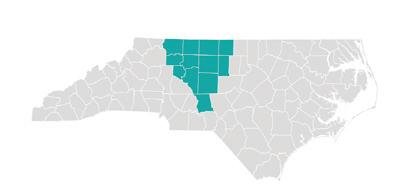
Jon Mercer was named president of Novant Health Clemmons Medical Center, a 36-bed hospital west of WinstonSalem. He had been chief operations officer at UNC Health Blue Ridge Healthcare since 2021. In Clemmons, he succeeds Alisha Hutchens, who now heads Novant Health’s acute care operations in the Triad.
A former resident of the Well-Spring retirement community made a $24 million bequest that will support care for residents

who outlive their assets. Florence Phillips died in August at age 100 and was one of Well-Spring’s first residents. Her bequest is believed to be one of the largest bequests nationally to a retirement community.
Accounting firm DMJPS merged with Potter & Company, a CPA firm with offices in Concord, Monroe and Mooresville. The move leaves DMJPS with more than 200 employees, 25 partners and 10 North Carolina office locations stretching from Wilmington to Asheville.
Culp reached a multi-year agreement with Seattle investor 22NW LP, which holds a 14.8% stake. As part of the deal, Culp will modify its board of directors.
Pioneer Square Brands, a manufacturer of cases for electronic products, scaled back its planned $1.3 million expansion, citing tariffrelated challenges. The company moved its headquarters here from Seattle in 2023 and consolidated operations into one facility. The city had approved $54,752 in incentives for the project.
WhiteFiber will invest about $1 billion and create 60 jobs for an AI data center in a recently closed, nearly 1 million-squarefoot textile mill formerly operated by Unifi.
Kontoor Brands completed its $900 million acquisition of Norwegian outdoor apparel maker Helly Hansen. It’s Kontoor’s first major deal since spinning off from VF Corp. in 2019, expanding its portfolio beyond denim into premium outdoor and ski wear. Helly Hansen had revenue of $630 million in 2024. It had been owned by Canadian Tire since 2018. Its production occurs mainly in China, Vietnam, Bangladesh and Cambodia.
e new jobs will pay an average wage of $67,000. Uni announced in February it would close the plant, putting about 250 people out of work.
Italian company Farmina Pet Foods opened its rst U.S. factory, a $115 million, 150,000-square-foot facility. e company has lled 75 of 200 planned jobs and is hiring for roles including machine operators, veterinarians, and technicians. e project was announced in 2020.
Krispy Kreme sold a former production plant for $9.65 million. e 106,615-square-foot facility sits on 20.5 acres near Interstate 74. e buyer is AIC Industrial, an investment fund based in Austin, Texas.
Hispanic grocery distributor Purple Crow relocated to the former R.J. Reynolds plant at Whitaker Park, investing $61 million in purchase and renovations. e family-run company plans to add more than 250 jobs at the 850,000-square-foot facility.

Land near SAS Institute headquarters is a top contender as the site of North Carolina’s rst freestanding children’s hospital, a $2 billion-plus billion, 500-bed project proposed by UNC Health and Duke Health. Lawmakers are debating the state’s allocation for the project, which is also relying on private funding. A location decision is expected this summer.
Duke Health began construction on a 110,000-square-foot hospital here, featuring an ER, surgical center, infusion space and 40 beds. e project is expected to be completed in 2027, as part of an 85-acre campus that may lead to 1,600 jobs.
e UNC System put a cap on administrative headcount and spending on permanent salaries at April levels, President Peter Hans said in a memo to chancellors. New faculty and sta hires now need to be approved by a chancellor or a designated manager. Potential federal cuts to university spending makes the new policy necessary, Hans said.
RTI International announced a third round of job reductions. e research nonpro t has reduced its workforce by about 35% this year a er cuts in federal




























Norfolk Southern resumed freight rail service here after an eight-month outage caused by Tropical Storm Helene. The restoration boosts key manufacturers and could revive plans for passenger rail. Major repairs, including the Old Fort Loops, remain. Lines operated by the CSX railroad await a $600 million rebuild.
funding under the Trump administration. The new layoffs will involve 170 U.S.-based staff members, including 76 in North Carolina, bringing the total job losses to about 740 and 360, respectively. RTI is spending as much as $2 million for an employee fund to help former and current workers with “financial hardship” grants of up to $10,000.
Fortrea Holdings named Anshul Thakral as president and CEO, effective Aug. 4. Thakral succeeds interim leader Peter Neupert. Former CEO Thomas Pike stepped down in May after leading the clinicalresearch organization since its spinoff from Labcorp in June 2023.
Liquidia received final FDA approval for Yutrepia, a treatment for pulmonary hypertension, unlocking a potential $4 billion market. The firm may expand in the Triangle, where its technology was developed at UNC Chapel Hill.
PlayMetrics merged with Stack Sports to form a new youth sports tech platform backed by Genstar Capital. PlayMetrics, led by CEO Michael Doernberg, will headquarter the combined 400-employee
firm serving 15,000 leagues.
A Wake County judge ordered Saint Augustine’s University to pay $20.2 million to SBA Connect, a Boca Raton, Floridabased telecommunications company, after the school failed to respond to a lawsuit over unpaid bills. Alumni are voicing concern as financial and legal troubles escalate at the HBCU started in 1867.
Pinewild Country Club is planning a 77-home neighborhood called Azalea Place, with sales set to begin in September. The homes will range from 2,600 to 3,800 square feet with prices starting at more than $1 million. It’s the first major housing expansion within a gated country club in Moore County in a decade.
Firearms maker OA Defense is moving its headquarters and manufacturing operations from Nevada to Moore County. The company will open a 25,000-square-foot facility by August, hiring 22 new workers. President Paul Ross cited the region’s skilled
labor pool, family values and workforce pipeline as key reasons for relocating.
Rockingham Speedway was listed for sale by Rockingham Properties, less than two months after NASCAR held a race at the historic track in April. Don Lovenheim bought the track for $2.8 million in 2018. A new owner is expected to be selected by July 1.
FirstCarolinaCare will begin permanent layoffs of 50 employees starting July 8 as it winds down operations, according to a state filing. The health insurer is jointly owned by FirstHealth of the Carolinas and Urbana, Illinois -based Carle Health. Separations will occur in waves through October 2026.
Durham-based Wolfspeed announced it would lay off 73 workers in August at its $5 billion chip manufacturing plant. That is about a third of the employees working at the site, which is under construction. Wolfspeed cited business challenges related to “near-term customer demand.” Wolfspeed expects to eventually employ 1,800 workers there. The company is relying on large federal subsidies, which were favored by the Biden Administration but have drawn criticism from President Donald Trump.

Asheville Regional Airport unveiled an improved ticket lobby, part of its continuing $400 million expansion. The upgrade adds better lighting, more space and a faster baggage system, addressing rapid passenger growth over the past five years. ■







We’ve been working on some other ways to provide North Carolina’s decision-makers content in a variety of ways. One of these is a new monthly video series we are pretty excited about.


Business North Carolina and Bclip Productions Inc. are proud to present "On the Ground: The Grit That Drives Carolina Business," a behind-the-scenes video series filmed on location with the entrepreneurs, risk-takers and innovators shaping North Carolina's economy. Each episode offers an unfiltered look at the bold decisions and daily grit required to build impactful businesses.
Over the past few months, we’ve covered two impressive innovators. Riverbend Malt House is a Buncombe County-based business that has been serving the craft beer industry since 2011.
Durham-based custom carwash services group Spiffy has transformed traditional car care in more than 30 cities with a fleet of mobile technicians, backed by custombuilt vans and powerful cloud-based technology.
We’ll be uploading a video each month on our YouTube Channel. You can scan the QR code and check out these cool companies, with more to come.






















North Carolina’s manufacturing line runs long. It started with busy hands building furniture, weaving textiles and creating needed products. Today, those outputs are joined by others for a range of customers, from aerospace to clean energy and healthcare. That growing list, along with a rapidly changing business environment, has altered manufacturing’s inputs. Not only have wrenches been replaced with multimeters and adding machines exchanged for artificial intelligence, but workers need the latest fine-tuned skills. Business North Carolina recently hosted a group of manufacturing leaders to discuss the industry’s current state, what it needs and where it’s headed. Their conversation was moderated by Publisher Ben Kinney. The transcript was edited for brevity and clarity.


president and CEO


senior director of operations projects
The discussion was sponsored by:
•Pitt County EDC
•Reynolds American Inc.
•The Rise Companies


general manager
MINTZ: Manufacturing continues to be a growth industry. Economic developers are engaging companies that want to relocate or expand here. People want to come to our state.
You’re living under a rock if you don’t see current supply chain expenses and challenges, including those related to tariffs enacted by the Trump administration. Smaller companies are struggling to make it work, because many import a lot of supplies. We’ve created a global economy, and that can’t be changed overnight.
The people we talk to are trying to navigate tariffs. They’re developing innovative ways to understand their costs. Manufacturers are under pressure to be successful. The business is there. Everyone is moving along, trying to do their business.
SMITH: The private sector is better off than the public sector. We buy companies in bread-and-butter spaces, outside one venture capital play. Business is really good for us. Our companies have strong backlogs.

Tariffs have probably impacted retailers more than manufacturers. I could see manufacturers of household goods, such as appliances, being impacted more than we are. We use a lot of wire and raw metals, and we’re not having issues. We’ve controlled our costs.
If your business is in a good core space, especially one with a labor shortage, margins are good. Backlogs are great if you can supply. Things are good for you right now.
MARQUES: Manufacturers are attracted to North Carolina for many reasons. Its strategic location offers access to ports. There is infrastructure. The partnerships with local and state entities are focused, driven and supportive. The community colleges and workforce training programs are strong. All of those play huge roles when companies are making decisions in terms of business and positioning.
Our work is technical, and workers’ skills need to match that. The community must bring that skill set or be able to upgrade those skills in conjunction with us. Creating those workers isn’t the sole responsibility of local economic development teams or the N.C. Community College System. Manufacturers must be involved, too.

Phil Mintz executive director
NC State University Industry Expansion Solutions and
director
of North Carolina Manufacturing Extension Partnership

That will make North Carolina even more attractive.
Stability and certainty within federal policies is important to our business, and we don’t have that right now. It’s crucial to attracting and returning long-term investments in manufacturing stateside.
SHULL: BE&K is bullish on North Carolina and its potential. Labor is the biggest challenge. The state’s unemployment rate was 3.7% in April, which was below the national rate of 4.2%. Its population continues to grow. There are many good projects underway. Life sciences may be in a bit of a lull, but it has been busy the past few years. Its growth in North Carolina is exciting.
Many people question how tariffs will affect North Carolina. It’s on the East Coast, so it’s an easy beachhead for businesses setting up shop within our borders. It’s a day’s drive or a short flight from half the country, making it easy to reach customers and suppliers.
CRISP: Every day I work with talented welders, machinists, industrial mechanics and mechanical engineers. About half of our product line serves industry in North Carolina. The other part serves the naval defense industry, repairing and

David Shull senior design manager
BE&K Building Group


Harry Smith founder
The Rise Companies



overhauling large capital equipment for aircraft carriers and build-to-print subcomponents of components such as missile-defense systems. We have a strong backlog.
Labor is at a premium, which works in our favor. Tariffs are creating confusion and affecting business in a negative way. Maintaining prices for more than a day is a challenge sometimes. But I’m optimistic about Carver Machine Works and North Carolina.
North Carolina has the Southeast’s largest manufacturing workforce, according to Gov. Josh Stein. That’s the result of aligning industry and education. The community colleges train young folks. They offset our aging workforce, which is one reason behind our current labor constraints. Add in the state’s low tax rate and it being an incredible place to live, and there are many things working in North Carolina’s favor. The state’s outlook is bright.
GAGE: It’s quite strong. Reynolds added 500 jobs last year and 300 jobs this year. Many are in manufacturing. We’re growing our Tobaccoville factory, which is a welcome change from years past. Competition for skilled labor is getting hotter by the day. The average tenure of a production-floor worker was in the decades when I started with Reynolds. It’s less than 10 years now. We need to attract and retain workers.
MINTZ: Companies that create internal workforce development programs have been more successful than those that don’t. They’re putting their heads together, doing things instead of relying on outside sources to provide workers. An Asheville company, for example, buses in workers. Others bring in non-traditional workers to do some jobs. The companies complaining less about workforce issues are the ones doing something about it on their own.
CRISP: We’ve altered our recruitment and retention approaches to match our current needs. We’re investing earlier, including onboarding workers before they’re ready to help row the boat, so to speak.
We’ve found that hiring locally improves retention. Someone accustomed to living in eastern North Carolina and mentored by our employees is more likely to stay compared to an “expert” recruited from miles away. We look for the right fit, and that includes an employee’s hometown.
MARQUES: Local people bring retention, and partnerships with local entities can train them. We are new to the region, but we have great partnerships with local entities. We’re deeply engaged. We don’t rely solely on workforce development from schools and community colleges. We internalize that responsibility.
We look for people willing to do the job: Will they give their best effort? That’s No. 1. We look at leveraging experience to move us into the future. One of our tech team leaders is in his early 80s. We’re looking at everyone. We can’t make the future happen without everyone.
The need to upgrade and evolve workforce skills isn’t unique to North Carolina. It’s a worldwide issue. Often there seems to be a disconnect between what manufacturers need and how workers — current and future — are trained. Companies need to be more involved. Educational institutions need to adapt their curricula to real needs. Those jobs are the responsibility of both parties.
We need to move quickly. Production in our first phase is ramping up, and our second phase will create about 850 jobs, mostly tech to engineer level. We’re discussing with different entities how to fill those positions without going too far from our Pitt County location or outside the state.
SHULL: Industrialists are typically private. But bring up talent attraction and retention, and they start talking. North Carolina’s low unemployment rate is challenging; it puts pressure on pay. It motivates people who think they have a better opportunity elsewhere. It’s key to show people that you can train and develop them. The industry may be slow coming to that party. Industrialists seem to be better at finding



customers than employees. They need to sharpen those tools, creating a place where people want to be now and in the future. There’s a shift to high-tech labor from craft labor. Give people the opportunity for more education, whether on the job or in a classroom. That creates opportunities to improve, whether that’s self-esteem, responsibilities or pay. That benefits the industry rather than detracts from it.
SMITH: There has been a significant shift, thanks in part to a growing awareness of what’s happening to trade-school graduates versus those from four-year institutions. It’s the dichotomy of a fouryear degree’s cost and job opportunities versus working in the trades, whether
that’s as a plumber, welder, electrician, machinist or something else. Be a great machinist if you want to make a lot of money; we’ll be competing for you.
The state’s most important education resource is its community college system. If you want continued growth for North Carolina, then super fund community colleges. Create the workforce dynamics that we need to be successful.

A community college education is the best product you can get from a cost perspective. Don’t start at a four-year school. Start at a community college and get those two years of maturity, which are a big deal for 18-year-olds. Then decide what to do, because that low-cost platform creates opportunities.
It’s a “shiny candy mentality” with education; many people are enamored with football and basketball teams. College used to have a large social component. Technology has dramatically changed that. The world’s social dynamics have changed.
There are some neat programs out there. We were one of the first to do a signing day with kids. Instead of a picture with a jersey, athletic scholarship and their parents, they get one with a hard hat, job offer and their parents.
MINTZ: NC State’s engineering programs are welcoming more and more students from community college programs. Their knowledge and skills continue to grow as they gain experience on the factory floor. That pathway becomes more and more important as technology advances.
There’s a lot more focus on training engineers based on what they learn at tech schools. Engineers of the future will go through that trade school hands-on pathway. It’s an approach that other countries are probably already doing.
GAGE: It’s no longer your father’s factory. Advancements have come a long way. Our machines and processes lend themselves to electronics rather than mechanics. We invite local community college students into our plants and introduce them to modern manufacturing.

growpittcountync.com
We find a lot of traction when we meet students from community colleges.
MARQUES: Boviet uses a lot of technology to build its photovoltaic modules. We are highly automated and will be even more so in the future. Our state-of-the-art equipment is the best in the solar industry, and our Phase 2 will be the best in the country when it opens next year. AI is part of our present, and we’re preparing for it to be a bigger part of our future. We see many opportunities for it within our business, especially preventive maintenance. It won’t replace our technicians. It will support their day-to-day work. It will make our manufacturing better, faster, more predictable and more reliable.

Great things happen when we work together, and there are great things happening in the Greenville, NC MSA. Together, we are driving innovation, unleashing growth opportunities, and leading the way to a stronger future. Join us in the Greenville, NC MSA. The best location for strong collaboration.

We collect a lot of data. Human beings can only process so much of it. We must leverage technology to process all of it. Workforce development and training must support the understanding and use of new technology such as AI.
SHULL: The flourishing of the Internet of things — sensors and monitoring devices — has created a challenge. There’s a need to handle and assess the large amount of collected data in a meaningful way, whether that’s identifying emerging problems or opportunities to improve quality or productivity. AI can monitor and trawl that data in real time, highlighting trends or aberrations. Then a human being can determine if it needs to be acted on before it becomes a critical problem to production.
CRISP: We’re beginning to use AI for workflow processes such as proofing an email. But there will be a large expansion
of its use in scheduling and resource planning in the coming years. That’s a big deal for a high mix, low-volume manufacturer like us.
It’s tough for a manufacturer of our size to be on AI’s leading edge. But we are preparing for it, and we rely on partners such as NC State Industrial Expansion Service, which has provided training, for help. While there’s a lot to grapple with, including security of our data, it’s a huge opportunity for our industry. There’s a tremendous amount of variability and tremendous amount of useful data that could be captured.
GAGE: Automation is here. It’s in our factory. We squeeze out as much efficiency as we can. An interesting application for AI is from a machinelearning standpoint, analyzing the
best-performing complex in the factory, identifying what makes it great and applying our findings across the factory.
Our training department uses technology. Our Operation Skills Development team recently deployed HoloLens, an augmented reality headset. It allowed OEMs in Germany and Italy to watch our mechanics’ hands as they worked on their machines here, allowing direct feedback in real time.
MINTZ: We’re helping smaller manufacturers, who represent 90% of manufacturing in the state, to choose an approach to technology. They hear stories of what AI and automation can do. But many of those abilities come with a big price tag. The first thing small manufacturers say is they can’t afford to do it all. And they’re right.


BE&K Building Group interns have been digging into the construction industry, taking on various tasks and responsibilities. From job sites to office settings, they’re learning the ropes and applying their skills in real-world scenarios.
But technology doesn’t necessarily require a major investment. We point out lower cost options that can be as helpful, especially with data collection and analysis. Some monitoring equipment connects to existing machines. It’s still technology, and it’s still collecting information that can be applied on the factory floor. That will help you as a small manufacturer.
SMITH: There has been an awakening to the weakness of the supply chain. Tariffs and the response to them have exposed a significant riff — a manufacturer’s ability to ensure component flow into and product flow out of its factories.
I believe there will be a big manufacturing resurgence nationwide, especially in small parts, because you can put many in a shipping container. I think the small-parts

business is coming back to America. And it has as much to do with tariff costs as much as ensuring an intact supply chain.
SHULL: It started with the COVID pandemic, which disrupted supply chains. Many companies quickly shut down, because they were using just-in-time manufacturing. One source of supplies dried up, and everything stopped. After the pandemic, manufacturers began catching up on production while stockpiling materials. At this point, we’ve overcome all of that. People are happy with how their supply chain works.
Now tariffs have re-introduced uncertainty. If I source foreign parts, then I’m facing a second round of securing other means of ensuring a continuity of flow. The whole industry has gone from concerned with your own plant floor to being holistically focused on your entire supply chain. Even sending out your product for work before bringing it back for finishing can be affected.
It’s all vulnerable, whether from legislative interruptions or marketplace ebbs and flows. It’s one more place where technology may provide greater insight, improving planning and isolating you from disruption.
MARQUES: Tariffs’ long-term effects will solve supply chain issues. The current scenario needs to be restructured. Reshoring industry and suppliers requires time and clarity. That stability will help as the industry positions itself.
COVID caused a disruption, halting supply chains. Reshoring manufacturing is a solution that we are working on to keep them running. But we need clarity in terms of policies. They can mean many opportunities for the state, including developing logistics and infrastructure that can absorb and support more manufacturing. ■


By Lawrence Bivins
North Carolina notched another impressive series of economic development triumphs over the past 12 months, according to Business North Carolina’s annual report on the largest job-creation announcements.
at was before Amazon disclosed its plan in early June to invest $10 billion in a data center campus in rural Richmond County, marking the largest initial investment pledge in state history. Amazon says at least 500 jobs may be created at that project. We didn’t include it this year’s list, which is based on developments announced between June 1, 2024, and May 31, 2025. However, the Seattle-based e-commerce and logistics giant is already in the ranking because of a big ful llment center planned near Wilmington.
is year’s list has more of a domestic tone, with U.S. operators making up seven of the 10 biggest job-creating projects, versus only two last year. But foreign investment continues to ow into North Carolina as companies in Canada, Europe and Asia announced new and expanded facilities. Five North Carolina-based companies are also on the list.
Energy-related businesses led much of the activity, egged on by the push toward electric vehicles and an unquenchable thirst for power. North Carolina remained a go-to choice for global life sciences companies, especially for large biomanufacturing operations, and the state is luring more aerospace and aviation-related enterprises.
Project details are distilled from state reports, press releases and local media coverage. Some projects inevitably fail to hit their anticipated jobs and investment targets, while others will surpass their initial goals. For example, Toyota initially pledged 1,700 jobs and $1.3 billion in capital expense at its new battery manufacturing plant in Randolph County in 2021. Production launched in April with 1,400 workers and an investment of $14 billion, and sta ng could reach 5,000 by 2030.
source: Business North Carolina
16,555




Santa Clara, California
▪ NEW JOBS: 1,062
▪ COUNTY: Edgecombe
▪ PROJECTED INVESTMENT: $1.4 billion
▪ N.C. CASH INCENTIVES: $21.75 million
A er evaluating 70 sites across nine states, Natron Energy selected Edgecombe County’s Kingsboro megasite for a 1.2 million-square-foot factory to make sodium-ion batteries. e privately held company’s batteries, produced at an initial site in Holland, Michigan, are the only UL-listed batteries on the market and provide an alternative to lithium-ion batteries. Potential customers include data centers, EV charging stations, microgrids and telecom providers. Investors in Natron include ABB, Chevron and ND Capital. China’s Triangle Tyre claimed the Kingsboro site in late 2017, but terminated its venture there in 2022.
$14.58 billion









Seattle, Washington, and Arlington, Virginia
▪ NEW JOBS: 1,000
▪ COUNTIES: Pender/New Hanover
▪ PROJECTED INVESTMENT: $350 million
▪ N.C. CASH INCENTIVES: $0
At the March groundbreaking of the company’s 650,000-squarefoot ful llment center near Wilmington, Amazon Vice President Holly Sullivan called Pender Commerce Park a “unicorn” site and praised the region’s growing workforce. “ is facility represents not just a building, but a gateway of opportunity,” Sullivan said. e center is expected to open by early 2027. Amazon employs 27,000 in North Carolina and has 13 ful llment centers and 14 delivery stations.


Bagsværd, Denmark
▪ NEW JOBS: 1,000
▪ COUNTY: Johnston
▪ PROJECTED INVESTMENT: $4 billion
▪ N.C. CASH INCENTIVES: $0
e Danish maker of popular weight-loss drug Wegovy, diabetes treatment Ozempic and related therapies will expand its North Carolina operations on a 56-acre parcel adjacent to its plant in Clayton. e new 1.4 million-square-foot facility may be complete as early as 2027. e project follows completion of the company’s $2 billion Active Pharmaceutical Ingredients site announced in 2015. Novo Nordisk employs 2,500 North Carolina workers.
Havelock
▪ NEW JOBS: 444
▪ COUNTY: Lenoir
▪ PROJECTED INVESTMENT: $4.35 million
▪ N.C. CASH INCENTIVES: $0
FRC East is said to be North Carolina’s largest industrial employer east of I-95. But the military aviation maintenance depot has outgrown its longtime coastal campus in Havelock. In June, o cials gathered at the Global TransPark in Kinston to break ground on a 750,000-square-foot hangar complex that will house work on the U.S. Navy and Marine Corps’ C/KC-130 Hercules and Super Hercules refueling, cargo and tactical passenger planes. e new facility could boost the TransPark’s appeal to defense contractors and help solidify eastern North Carolina’s military bases as the Pentagon streamlines maintenance operations.




New Brunswick, New Jersey
▪ NEW JOBS: 420
▪ COUNTY: Wilson
▪ PROJECTED INVESTMENT: $2 billion
▪ N.C. CASH INCENTIVES: $15.2 million
Johnson & Johnson, maker of Tylenol and hundreds of other health and consumer products, aims to boost its global supply chains in a major way in North Carolina. Its 500,000-square-foot plant is focused on biologic medicines in oncology, immunology. neuroscience and other areas, as directed by subsidiary Janssen Biotech. It’s the rst of a round of $55 billion in U.S. capital investment expected over the next four years. e Wilson workforce will include analysts, engineers, microbiologists, scientists and management personnel, with an annual average compensation of $109,000. at’s more than twice Wilson County’s average.



South San Francisco, California
▪ NEW JOBS: 400
▪ COUNTY: Wake
▪ PROJECTED INVESTMENT: $700 million
▪ N.C. CASH INCENTIVES: $9.85 million
Founded in 1976, Genentech has been part of Switzerland’s Roche Group since 2009. e biotech pioneer will build a 700,000-square-foot ll- nish operation in Holly Springs. e company develops oncology, neuroscience and ophthalmology therapies, and its drugs include Avastin, Herceptin, Rituxan and Tami u. Genentech’s rst eastern U.S. plant joins Fuji lm Diosynth, CSL Seqirus and Amgen in establishing signi cant manufacturing sites in Holly Springs in recent years.


Thousand Oaks, California
▪ NEW JOBS: 370
▪ COUNTY: Wake
▪ PROJECTED INVESTMENT: $1.02 billion
▪ N.C. CASH INCENTIVES: $4.9 million
Barely three years a er unveiling plans for its rst North Carolina production site, Amgen is doubling down on its investment in Holly Springs. Founded in 1980, the company develops treatments for cancer, heart disease and other serious illnesses. At Amgen’s lateJanuary groundbreaking, state Senate President Pro Tem Phil Berger said. “It’s not every day a company decides to expand its operations before the initial facility is fully operational.”

Houston
▪ NEW JOBS: 333
▪ COUNTY: Chatham
▪ PROJECTED INVESTMENT: $193.8 million
▪ N.C. CASH INCENTIVES: $3.2 million
Pioneered in University of Houston materials labs, MetOx’s superconducting technology enables high-power transmission at lower voltages and greater e ciency. Established in 1998, the company and its energy solutions could be key in meeting the intensive electrical demands of AI-driven applications and hyperscale data centers. Houston billionaire John Arnold’s Centaurus Capital and climate-focused New System Ventures are among the private company’s backers.

East Hartford, Connecticut
▪ NEW JOBS: 325
▪ COUNTY: Buncombe
▪ PROJECTED INVESTMENT: $285 million
▪ N.C. CASH INCENTIVES: $4.1 million
Opened in 2022, Pratt & Whitney’s 1.2 million-square-foot plant at Asheville’s Biltmore Farms manufactures turbine airfoils, a key component of jet engines. e company is part of Virginiabased RTX, formerly Raytheon Technologies. Its current expansion, announced in January, was welcome news for the region’s hurricanebattered economy. Pratt & Whitney met its initial pledges for jobs and investment three years ahead of schedule, and estimates its workforce will reach 1,200 by 2029.

Waukesha, Wisconsin
▪ NEW JOBS: 330
▪ COUNTY: Wayne
▪ PROJECTED INVESTMENT: $140 million
▪ N.C. CASH INCENTIVES: $4.7 million
Prolec GE Waukesha will double its Goldsboro facility’s production of medium power transformers. e company designs, sells and supports transformers for electric utilities, which are striving to meet surging demand for power. e company is a joint venture between Mexico’s Xignux and GE Vernova, an energy equipment business based in Cambridge, Massachusetts.


Hamilton, Ontario Canada
▪ NEW JOBS: 325
▪ COUNTY: Mecklenburg
▪ PROJECTED INVESTMENT: $56 million
▪ N.C. CASH INCENTIVES: $100,000
Canada’s AVL Manufacturing makes customized enclosures for standby power generators used as backup systems for large data centers, as well as industrial buyers in the automotive, construction and emergency management sectors. Unveiled in May, AVL’s plans call for 232,310 square feet of industrial space in southwest Charlotte. It’s the companies rst U.S. plant. President Vince Dicristofaro said, “Charlotte’s spirit of collaboration and its talented workforce made it the clear choice for our American-based home.”



Fayetteville
▪ NEW JOBS: 304
▪ COUNTY: Cumberland
▪ PROJECTED INVESTMENT: $896 million
▪ N.C. CASH INCENTIVES: $8 million
e “First in Flight” state boasts 450 aerospace- and aviationrelated businesses, including manufacturers relying on high-grade titanium. American Titanium Metal, a startup that o cials have labeled “Project Aero,” has said it plans to eventually invest as much as $1.6 billion in a 500,000-square-foot titanium production operation near the intersection of I-295 and U.S. 401. It’s an e ort to reduce U.S. reliance on China as a mineral source. Average wages are expected to reach $123,476. Harrison County, West Virginia, also vied for the project.


Charlotte
▪ NEW JOBS: 300
▪ COUNTY: Cabarrus
▪ PROJECTED INVESTMENT: $140 million
▪ N.C. CASH INCENTIVES: $0
Motorsport IP Acquisition Company will build a design and testing facility on 10 acres at Hendrick Motorsports’ campus in Concord that will provide engines for Cadillac Formula One (F1) vehicles. e racing team, which is a partnership between General Motors and the TWG Global investment rm, plans to be ready to race by 2028. In 2026, GM’s Cadillac division is entering Formula One, the open-wheel racing events considered the pinnacle of motorsports. Concord City Council is supporting the venture with a performance-based incentive grant of $750,000.

Berkshire, U.K.
▪ NEW JOBS: 289
▪ COUNTY: Wilson
▪ PROJECTED INVESTMENT: $145.6 million
▪ N.C. CASH INCENTIVES: $4.6 million
Mucinex is America’s No. 1 doctor-recommended cold and u medication, and Reckitt intends to produce it at a 309,000-squarefoot building in Wilson previously owned by Swiss pharma company Sandoz Group. A Reckitt a liate reportedly paid nearly $18.9 million for the structure, which sits on about 29 acres. e plant will be U.K.-based Reckitt’s largest in the U.S. Founded in 1840, the company’s consumer brands include Lysol and Clearasil.


Redford Township, Michigan, and Fort Worth, Texas
▪ NEW JOBS: 276
▪ COUNTY: Mecklenburg
▪ PROJECTED INVESTMENT: $7.8 million
▪ N.C. CASH INCENTIVES: $4.2 million
Daimler Truck Financial will relocate its headquarters to Charlotte, consolidating administrative, HR and nancial operations from Michigan and Texas. e 50-year-old German company provides nancing, insurance and leasing solutions for Daimler Truck North America, which manufactures trucks under the Freightliner and Western Star brands, as well as omas Built Buses. DTFS plans to occupy 60,000 square feet of o ce space at Ballantyne Corporate Place. Daimler employs more than 6,500 people at Gaston and Rowan county plants.
Westbrook, Maine
▪ NEW JOBS: 275
▪ COUNTY: Wilson
▪ PROJECTED INVESTMENT: $147 million
▪ N.C. CASH INCENTIVES: $3.9 million
IDEXX provides veterinary diagnostic and so ware solutions, operating in 175 countries and employing 11,000. e company will establish a production facility in Wilson to produce veterinary diagnostics products. Shortly a er announcing the project last summer, IDEXX reportedly paid nearly $2 million for 50 acres of available land o Wilson’s International Boulevard. Annual wages at the plant will average $65,873, according to the N.C. Department of Commerce.


Vilnius, Lithuania
▪ NEW JOBS: 250
▪ COUNTY: Davie
▪ PROJECTED INVESTMENT: $70 million
▪ N.C. CASH INCENTIVES: $1.42 million
Recently established furniture maker SBA Home announced plans in late 2024 to build its rst North American plant in Mocksville. e company is a unit of SBA Grupe UAB, a Lithuanian conglomerate. SBA Home CEO Jurgita Radzevičė cited the state’s talent pool, infrastructure and logistics as factors in the company’s selection. “We are excited to launch our journey in the United States, starting in North Carolina — a state renowned for its dynamic business environment and exceptional opportunities for globally growing companies,” Radzevičė says.



Osaka, Japan
▪ NEW JOBS: 232
▪ COUNTY: Pitt
▪ PROJECTED INVESTMENT: $398 million
▪ N.C. CASH INCENTIVES: $2.5 million
Japan’s Nipro makes medical devices and healthcare solutions. Its 550,000-square-foot facility in Greenville, the company’s rst U.S. manufacturing presence, will produce advanced technologies that support patients a ected by diabetes, chronic kidney disease and other renal health issues. e 130-acre campus will house customer service operations and a training center for healthcare providers. e company anticipates the plant to open in 2026.


Kolhapur, India
▪ NEW JOBS: 232
▪ COUNTY: Guilford
▪ PROJECTED INVESTMENT: $14.4 million
▪ N.C. CASH INCENTIVES: $0
Kernersville’s Piedmont Commerce Center will be home to Indo Count Global’s newest manufacturing facility. Founded in 1988, the Indian-owned public company makes bed linens, pillowcases, comforters and quilts marketed through brands that include Atlas, Pure Earth and Boutique Living. “Indo Count’s commitment to quality and innovation aligns perfectly with the Triad’s legacy in textile manufacturing,” N.C. Commerce Secretary Lee Lilley says.

Canonsburg, Pennsylvania
▪ NEW JOBS: 217
▪ COUNTY: Hoke
▪ PROJECTED INVESTMENT: $102.5 million
▪ N.C. CASH INCENTIVES: $800,000
Pennsylvania Transformer has manufactured power transformers in Hoke County since 1992. The company provides equipment to utilities and other industrial buyers. Its expansion plans call for an additional 300,000 square feet of space across two new facilities in Raeford. Along with significant infrastructure upgrades from the N.C. Rural Infrastructure Authority and the N.C. Railroad Company, Pennsylvania Transformer will receive a performancebased grant of $800,000 from the One North Carolina program.

Charlotte
▪ NEW JOBS: 216
▪ COUNTY: Mecklenburg
▪ PROJECTED INVESTMENT: $13.7 million
▪ N.C. CASH INCENTIVES: $1.64 million
The Charlotte-based company is North America’s third-largest provider of brokered freight transportation and logistics. Its expansion adds more than 150,000 square feet of space to its Ballantyne operations and grows its 647-person local workforce. RXO last year bought Coyote Logistics from UPS for $1 billion. Charlotte’s competitive real estate costs, along with the state incentives and nearly $400,000 from local governments, helped prompt the company to remain in North Carolina.

Istanbul, Turkey
▪ NEW JOBS: 216
▪ COUNTY: Wayne
▪ PROJECTED INVESTMENT: $86 million
▪ N.C. CASH INCENTIVES: $2.1 million
A global maker of breathable films for hygiene, insulation and medical textile products, Pelsan considered 72 locations in six states for its first U.S. production outpost. Wayne County’s “strategic advantages, business-friendly environment and the welcoming spirit of its people” led the company to Goldsboro’s ParkEast Industrial Park, according to Pelsan Tekstil CEO Ali Sisman. Pelsan is part of Turkey’s Hassan Group, a company founded in 1939.

Irvine, California
▪ NEW JOBS: 204
▪ COUNTY: Orange
▪ PROJECTED INVESTMENT: $136 million
▪ N.C. CASH INCENTIVES: $100,000
Less than a decade after arriving in North Carolina, the U.S. unit of Japan’s oldest confectioner is expanding its operations in Mebane. Demand for Morinaga’s Hi-Chew candies has led to the need for more production space and workers. Since 2018, U.S. sales of HiChew have grown 20% annually, reaching $235 million in 2023. Morinaga is doubling its Mebane footprint to 200,000 square feet at its 21-acre property.

▪ NEW JOBS: 203
▪ COUNTY: Durham
▪ PROJECTED INVESTMENT: $10.05 million
▪ N.C. CASH INCENTIVES: $3.1 million
A developer of electric vehicle charging stations, Ionna is a joint venture among eight major automakers. The company’s headquarters facility near Research Triangle Park will include a research lab for software and hardware solutions. The ultimate objective is to create a network of more than 30,000 EV charging points. Founded in early 2024, Ionna also considered Austin, Texas, for the operation.

Kent, United Kingdom
▪ NEW JOBS: 200
▪ COUNTY: Johnston
▪ PROJECTED INVESTMENT: $$35.7 million
▪ N.C. CASH INCENTIVES: $1 million
Selma’s Eastfield Crossing, a mixed-use development at I-95 and U.S. 70, will be VeeTee Foods’ first U.S. location. Founded in 1987, the private British company processes and packages Asian-style rice varieties such as Basmati and Pilau for sale at supermarket chains such as Wegman’s, Harris Teeter and Publix. “Eastfield Crossing provides the ideal site, putting our growing company in close proximity to U.S. consumers, a great workforce and supportive local leaders,” says Moni Varma, chair of Veetee Foods, upon announcing the Johnston County investment.

▪ NEW JOBS: 200
▪ COUNTY: Wake
▪ PROJECTED INVESTMENT: $36 million ▪ N.C. CASH INCENTIVES: $0
The eastern Wake County town of Wendell has been home to Siemens’ U.S. medium-voltage business since the 1980s. The German company bases its Electrification and Automation operations there, adding hundreds of jobs in recent years. The latest expansion includes immersive customer demonstration spaces, as well as manufacturing areas. The move is the latest in a $500 million wave of investments Siemens is making in the U.S., including a 500-job advanced manufacturing and rail services center in Lexington announced in 2023.

Boise, Idaho
▪ NEW JOBS: 200
▪ COUNTY: Guilford
▪ PROJECTED INVESTMENT: $7 million
▪ N.C. CASH INCENTIVES: $0
Business process outsourcer PartnerHero provides quality assurance support for clients in the food, e-commerce and healthcare industries. Its Greensboro location is one of six global offices. “As we looked at locations across the country, it was clear that Greensboro could offer a winning combination of a thriving tech cluster, respected educational institutions and a welcoming community,” says Steve Chrabaszewski, chief operating officer.

Much work remains, but JetZero’s ambitious plans electrify the region and state.

By Chris Burritt

On an earlier visit to the Triad about 35 years ago, JetZero CEO Tom O’Leary was studying environmental policy at Furman University. He toured High Point’s solid waste disposal dumps, a much less glamorous task than his return in mid-June.
Amid all the fanfare that state and local o cials could muster, O’Leary and his West Coast colleagues gathered at Greensboro’s Piedmont Triad International Airport for the biggest job announcement in state history.
e Long Beach, California-based aviation startup said it expects to invest $4.7 billion and eventually employ 14,564 workers in an assembly factory on several hundred acres at the airport. e site is near two other aviation companies with optimistic plans, Boom Supersonic and Marshall USA.
“ is is not my rst rodeo here,” O’Leary told local and state dignitaries during a late-a ernoon reception. It followed an o cial announcement and meetings in Greensboro, Raleigh and Rocky Mount that pledged more than $2 billion in state and local economic development incentives — if JetZero follows through.
Along with cookies emblazoned with “JetZero” was a realization that the Triad is emerging as a major national aerospace hub. It also cements the airport’s role as the Triad’s economic engine, led by FedEx, Honda Aircra , HAECO and others.
“It is Greensboro’s time; it is the Triad’s time,” Greensboro Councilman Zack Matheny said as the council approved economic incentives for as much as $1,000 for each JetZero job.
A er considering sites in 17 states, JetZero picked Greensboro as one of three nalists. (Huntsville, Alabama, was also a nalist.) e selection is tied to a $1.157 billion state incentive package that pays o over 37 years, hinged on hitting job and investment targets. e company could score $784.7 million in local incentives from Greensboro and Guilford County, mostly property taxes that the company could skip.
e Golden Leaf Foundation, a public-private group that backs economic development in the state, is providing $60 million.
e jobs pledged in North Carolina will pay an average wage of $89,340, which is 48% more than Guilford County’s current average of $60,195. e jobs start at $18.75 an hour, or $39,000 a year. JetZero will need to invest a minimum of $3.8 billion and employ 10,000 workers to max out the state incentives over the next 37 years.
Dubbed Project Atlas, the JetZero project involved more than a year of negotiations among local and state leaders and company o cials. JetZero was founded in 2021 by aircra designer Mark Page and O’Leary, a startup veteran. O’Leary described the Triad as “the epicenter of the next era of ight.”
“For more than 100 years now, a place called Wichita has been known as the air capital of the world,” Greensboro Chamber of Commerce CEO Brent Christensen told the audience. “A er today and with a nod to the Wizard of Oz, it’s not in Kansas anymore. Everyone here will be shaping the future of aviation for the next 100 years, and it’s going to be a great ride.”
To be sure, JetZero has raised about $300 million of the estimated $2 billion that industry o cials will be needed to launch. e U.S. Air Force and United Airlines are among groups showing support, hoping a new rival can spur competition in an industry dominated by Boeing and Airbus.
At full run-rate, the JetZero factory plans to produce about 20 airplanes a month, spokeswoman Jenny Dervin says.
e plane’s design shows a blending of the jet’s wings and body, creating a broader appearance that resembles the at body of a stingray sh. e design allows the airplane to produce li and reduce drag, resulting in as much as 50% better fuel e ciency, according to Dervin.
Earlier this year, United Airlines indicated interest in ordering as many as 100 airplanes, and secured an option for an additional 100. e agreement is based on JetZero achieving development milestones, including ight of a full-scale demonstrator in 2027. ■
NEW JOBS: 14,564 (over 10 years / 2027-2036)
AVERAGE WAGE: $89,340 (Guilford County current average is $60,125)
JETZERO INVESTMENT: $4.724 billion
SPECIAL CONDITION: 10,000 jobs and $3.779 billion investment would trigger grant payment
STATE INCENTIVES: $1.570 billion over 37 years
LOCAL INCENTIVES: $784.7 million
ROI: 274% (For every dollar of cost, the state expects to receive $3.74 in state revenue)


The N.C. Economic Development Association awards its annual honors to top achievers. $ $
By Kevin Ellis
Elected o cials traditionally make the job announcements a er the economic developers across the Tar Heel State have done the heavy li ing. ey collaborate with consultants, companies, property owners and local governments to deliver investments and jobs to communities. In addition to the number of potential jobs, they consider how much workers can earn as they strive to improve the quality of life for North Carolina residents with increasingly better opportunities. ese seven men and women worked behind the scenes to bring about some of the state’s biggest job announcements in the past year.



Oppie Jordan retired vice president, Carolinas Gateway Partnership
In 28 years as Edgecombe County’s economic developer, Oppie Jordan had seen her share of nearmisses for the eastern North Carolina county of about 49,000 residents. “I used to tell everybody, I’m tired of being the bridesmaid, I want to be the bride.”
So when the Economic Development Partnership of North Carolina approached Edgecombe o cials in October 2023 about “Project Neptune” for its Kingsboro megasite, Jordan and other leaders were primed.
“We were very prepared because we’d only been working on this Kingsboro site for about 15 years,” she says. at included advocating for infrastructure investment across the 2,100-acre site, which attracted a Chinese tire manufacturing plant that never materialized.
In August, Santa Clara, California-based Natron Energy announced it would invest $1.4 billion to build the rst sodium-ion gigafactory in the United States about nine miles east of downtown Rocky Mount. Its batteries can reduce dependence on rival lithium-ion products, which typically rely on foreign sourcing, o cials say.


Natron projects it will employ 1,062 people at the site, with an average wage of $64,071, a 48% increase over Edgecombe’s average of $43,183. “ is will have a big draw to bring people to eastern North Carolina, but also for the young people that are graduating from high school or community college, they’ll now have a place that they feel like they can come back to and have a job with great pay that will o er them a better quality of life,” she says.
Jordan retired in September as vice president of the Carolinas Gateway Partnership. She has bought a home in the coastal town of Beaufort, the county seat of Carteret County, and now does consulting work for Rocky Mount-based Appian Consulting Engineers.
She grew up in Fayetteville, and lived in Raleigh while working in Edgecombe, making the approximately 60-mile, one-way commute daily. People in eastern North Carolina believe in themselves and have always been ready to pick themselves up, even from natural disasters like Hurricanes Fran and Floyd, she says.
“I loved working with a company and telling them all about eastern North Carolina and helping make a di erence in the rural part of North Carolina, which I love dearly.”

Jennifer Lantz can keep a secret. A consultant she’s known for 30 years told her a company was considering a $2 billion investment in Wilson, promising 420 jobs that would pay more than twice the county’s current average wage.
“We didn’t know it was Johnson & Johnson until almost the end, but we worked on it for almost three years to bring it to fruition,” says Lantz, the executive director of Wilson Economic Development Council since 1989. “People who work in economic development are so used to not saying anything. We’re probably the most reticent people around.”
In October, Johnson & Johnson announced its subsidiary, Janssen Biotech, would build a pharmaceutical manufacturing campus in Wilson. e average annual wage is $108,823, more than double Wilson’s average private-sector wage of $52,619.
It’s the biggest win of Lantz’s 36-plus-year career in the county, capping o Wilson’s best year in industrial recruitment. In September, Reckitt announced it would invest $146 million and create 289 jobs to make the cold medicine Mucinex in Wilson. In July, IDEXX Laboratories said it would invest $147 million

and create 275 jobs to produce veterinary diagnostics products.
Average annual wages at those companies are $80,182 and $65,873, respectively. e average wage for North Carolina is $67,474. “It’s not enough to go get jobs, you have to get jobs that raise people up. Jobs that pay a living wage,” says Lantz.
Wilson’s success is a team e ort, she says. It took elected o cials, the Economic Development Partnership of North Carolina, NC BioTech, Wilson Community College and others to land Johnson & Johnson. e company will receive $15.2 million from the state, and $54.2 million in local incentives paid over the next 12 years if it hits investment and job creation targets.
Lantz grew up in Richmond, Virginia, where her father located industrial plants around the world for several large companies. Dinner table conversations o en included those doing business with her father. “He didn’t have a son, so he took me along,” she says.
She considers herself fortunate. “Some people have a job. I get to go out and do something I love every single day. It’s a breeze.”

Josh Hallingse vice president, small business development and business retention, Greater Wilmington Chamber of Commerce



FedUp Foods decision to expand in Wilmington last year is an example of the entrepreneurial spirit existing in North Carolina, says Hallingse, who helped guide the Asheville-based manufacturer of kombucha, cold brew co ee and other products from the mountains to the coast.
“I’m amazed every day that you can do business with about anything here,” says Hallingse, who came to Wilmington in 2021 a er previous economic development positions in Henderson and Transylvania counties. “I really like working with small business owners because you get to work with smart, talented people who are really passionate about something.”
Sarah Mullins and Jeannine Buscher founded FedUp Foods in 2008. ey began homebrewing kombucha, a fermented tea, at home in ve-gallon jars. ey are now the largest U.S. private label manufacturer of fermented beverages. Costco is among the retailers selling their products under private labels.
FedUp outgrew its manufacturing facility in the Madison County town of Marshall, and opened a second site near Johnson City, Tennessee, in 2023. ey announced a $34 million investment in Wilmington in May 2024 with a plan to hire 104 workers.
eir New Hanover County site is at a former brewery located in a distressed neighborhood known for its public housing and social services entities like the Good Shepherd homeless shelter and Nourish regional food bank. Wilmington has a mix of large employers such as Corning, GE Aerospace and nCino, and smaller companies like FedUp, says Hallingse.
FedUp held an opening at its Wilmington site in April and already has more than 70 employees there.
“Wilmington is one of the best places to start a business or scale a business,” he says. “ e city has gured out a way to be innovative and entrepreneurial.”
e attraction of coastal living brings smart and talented people to Wilmington, while it helps to have all four modes of transportation nearby. e Port of Wilmington was key to landing FedUp, says Hallingse, as was the recent opening of a cold-storage facility by RL Cold.
“It’s great to work with people who have awesome ideas who are willing to bet on themselves,” says Hallingse.
Trey Cash remembers sitting down with his Greene Central High yearbook (Class of ‘08) when he took the job as director of economic development in his home county. He wanted to see which classmates were still around a er 15 years. A er one page, he found it easier to see who had le . ere were doctors, lawyers and nurses, most of them living elsewhere. at memory is now part of his motivation.
“I have a 4-year-old little girl, raised right here in Snow Hill in Greene County, and I want her when she grows up to say, ‘ ere’s opportunity for me here,’” says Cash. “We’re trying to shi this perspective that kids, when they graduate, say, ‘ ere’s no job opportunity for me here.’”
Cash grew up on a 100-acre farm, but jokes he prefers air conditioning. At 16, he joined the local re department and went to Wilson Community College with dreams of becoming a re ghter. He started working for Greene County in 2012 as a re inspector and a er about six years, joined the N.C. Department of Public Safety. In 2018, he became Greene County’s elections director, moving to economic development in 2022. He lled in as interim economic development director for neighboring Lenoir County, and added that to his job duties in 2023.
He does the job, he says, because he loves Greene and Lenoir counties and all of eastern

STEVE YOST president, North Carolina’s Southeast
North Carolina. He was Snow Hill’s re ghter of the year in 2024, and an elder at Snow Hill Presbyterian Church. Since 2023, he and Stanly County Economic Development Director Elizabeth Underwood Kazimer have done a podcast geared toward young people in industrial recruitment.
Successes include having both Greene and Lenoir counties form public-private economic development groups, securing a ve-year land option on 630 acres of land in Greene County and securing a $2.3 million, zero-interest rural economic development loan for Lenoir County to construct a shell building.
He describes his job as being a “chief relationship o cer” and “driving around making buddies.”
He also keeps two numbers on his walls — $39,698 and $48,863, representing the average private sector annual wage for the two counties, respectively. e state average is $67,474.
“Every year, I put those numbers on my wall and every year my goal is to raise that number because if we raise that number we’re putting more money in people’s pockets right here in our rural area so people can spend it in a small business, they can spend it on educating their children or buy a new car or buy a bigger house.”




CRYSTAL GETTYS
business recruitment director, Randolph County Economic Development Corp.


TREY CASH director, Economic Development for Greene and Lenoir counties

Steve Yost o en likens economic development activities to “God’s work,” says Gary Lanier, president of the Columbus County Economic Development Commission, because it brings jobs and investments to communities.
As this year’s president of the N.C. Economic Development Association, Lanier selects the recipient of the 900-plus member organization’s President’s Award. He chose Yost, who completed his 20th year with North Carolina’s Southeast in April.
“Steve Yost never seeks the spotlight, but is always moving mountains behind the scenes,” says Lanier.
NC Southeast represents a 20-county, mostly rural region of the state that has 1.9 million residents and a labor force of about 124,000. Since 2014, the organization has helped recruit 88 companies and bring more than 11,000 jobs to the region. More than 30 Fortune 500 companies have facilities in the region, while pork, poultry and various other products make it among the top agricultural regions in the nation.
“ ere’s no place in the world better than southeastern North Carolina,” says Yost. He particularly enjoys driving around the region, showing clients potential sites, or working with the individual counties on development of an industrial site or building.
Yost was talking about his work just two days before Amazon announced it would invest $10 billion in the region. e plan is expected to include 500 jobs at a data center campus in Richmond County, 80 miles southeast of Charlotte. Announcements are a lot of fun, he says, but he prefers to see steel coming out of the ground, followed by a parking lot full of employees’ cars.
Since starting work as a business recruitment director for Randolph County Economic Development almost six years ago, Crystal Gettys has helped the rural county secure about $530 million in investments expected to create more than 1,300 jobs.
e numbers tell only part of the story, says Kevin Franklin, president of the county’s economic development group.
“Crystal’s approach to economic development has always gone beyond numbers,” says Franklin. “She’s prioritized improving the quality of life through job creation, business diversi cation, and community inclusion.”
Gettys’ peers in the N.C. Economic Development Association chose her as the economic developer of the year.
“It’s an honor to be recognized,” says Gettys. “I just did what I thought I was supposed to be doing. I just did my job.”
Gettys says she enjoys the behindthe-scenes work it takes to build relationships between consultants, companies, property owners and local governments before a big job announcement is made.
Gettys e orts paid o in May 2024 when California-based Ross Dress for Less announced it would invest more than $450 million to build a 1.7 million-square-foot distribution center in Randlemen that’s expected to create 852 jobs. As that deal moved forward, Gettys had to work with six additional property owners to secure the 330 acres needed for the project.
A woman and her two sons at rst said they weren’t interested in selling the land where they had lived for decades, she says. ey changed their minds as discussions progressed with the company.
“ at particular lady came up and hugged me at the announcement,” says Gettys. “She was someone I never knew before, and we have become friends.”
Construction on the Ross Stores distribution site, located about 20 miles south of Greensboro, is about at the halfway point. By 2027, workers will start lling the massive building.
“Especially in a rural community, it is gratifying to know you had a small part in helping the community grow and o ering residents better opportunities. It’s very satisfying.”
“We got this one,” Gettys adds, “but now let’s get to work on the next one.”
“ e reward is seeing new jobs created in southeastern North Carolina,” says Yost. “On the back side of each of those new jobs is a citizen that needs one of those jobs.” Yost earned a degree in public administration from Appalachian State University and a master’s in public administration from UNC Chapel Hill before he realized exactly the role of economic development. A Lenoir County internship while earning his master’s degree opened his eyes to the strategic and collaborative nature of business recruitment.
“You have to know the technical stu like developing industrial sites and building industrial buildings, but all of that also takes money,” he says. “You’ve got to really bring folks to the table and be uni ed to do that.”
Yost previously was economic development director of Columbus County and an N.C. Department of Commerce sta er before joining North Carolina’s Southeast in 2000. He became president of the veperson sta in 2019.
“We exist to serve the counties. To me, that’s what makes us a strong regional economic development organization,” he says. “We just want our 20 counties to win. If it’s one that wins a project, it’s going to help the whole region. And if we can’t get them in the southeast, then we want to at least keep them in the state of North Carolina.”

Creative financing helped the Surry County Economic Development Foundation acquire approximately 30 acres of land last year, which is expected to pay dividends for the small town of Dobson in future commercial or light industrial development.
County property records indicate the sales price at more than $1.3 million, but by using an “equity participation arrangement,” the county’s economic development group was able to complete the deal in December with little public investment.
“Technically, we bought the property for $1 and some closing costs,” says Blake Moyer, president of the county’s Economic Development Partnership since March 2023.
The Foundation acquired the land from The Shelton Companies, a Charlotte-based private investment firm founded by Mount Airy natives Charlie and Ed Shelton. The construction and real estate developers founded the Shelco construction firm, which they sold to a group of employees in 2004. They also founded Shelton Vineyards, helping establish the Yadkin Valley wine industry.
The Sheltons took a long view on the property, putting it in public hands to develop, says Moyer. They won’t see a return until a third party decides to locate there. The property is less than a quarter-mile from an Interstate 77 exit ramp and has utilities, so he doubts the wait will be long.
“They’re putting some trust in us that we’re going to do things that are going to make the property more valuable and in the end, they’re going to make more money off of it than they would have by just selling it,” says Moyer. The Sheltons will get a base selling price and have a percentage stake in its increased value.
Raleigh attorney Ernie Pearson of Maynard Nexsen deserves much of the credit, says Moyer. Pearson, a former N.C. Commerce Department leader, has helped with similar deals across the state. He says he starts off by asking the landowner if they would like to make more money than the land’s current value. “The essence of any good deal is that it’s a benefit to both parties,” says Pearson.
Dobson is the county seat, but with less than 1,500 residents, it is smaller than Mount Airy or Elkin, which have about 10,000 and 4,500 residents, respectively. Twin Oaks Business Park is Dobson’s first intentional commercial development park.
“We talk a lot about product here, but also I think the spreading the love factor in terms of not all the product being in Mount Airy and Elkin is a big thing in our community,” says Moyer. ■

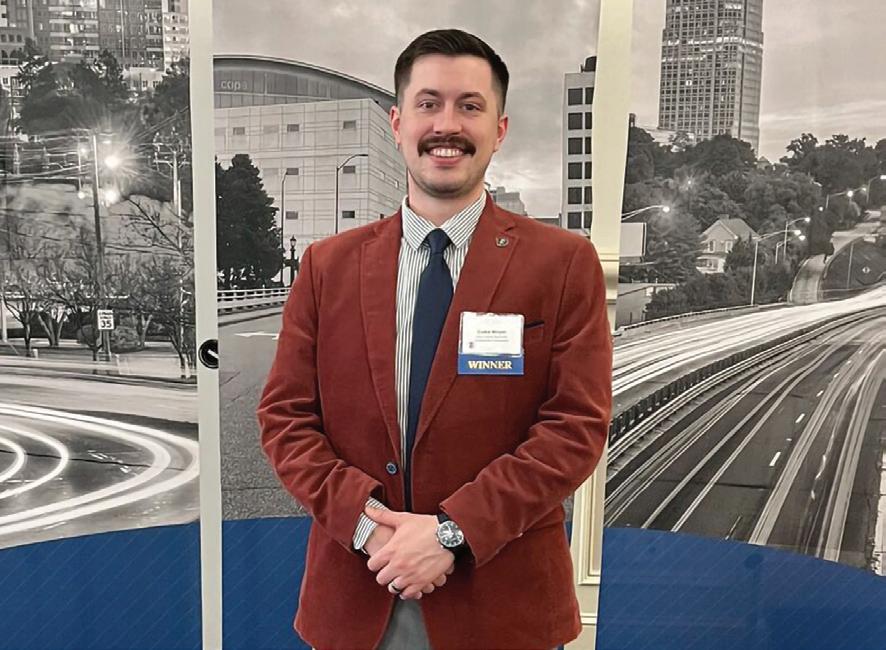
BLAKE MOYER president, Surry County Economic Development


By Kevin Ellis
State o cials have announced $2.6 billion in investments expected to create more than 5,200 jobs in the rst ve months of this year. But in a changing economy, other businesses are closing.
According to the N.C. Department of Commerce, 27 businesses announced layo s, resulting in the loss of 2,678 jobs in the rst ve months of this year. Only four of the layo s topped 300 workers.

e following list shows the layo s of at least 90 workers since June 1, 2024. It is topped by two of the largest employers in the nation, Walmart and FedEx. Walmart laid o 356 workers in two layo s as it closed a regional o ce in Charlotte. Some of those workers were o ered jobs at other Walmart locations, including its headquarters in Bentonville, Arkansas.
A federal law, the Worker Adjustment Retraining Notice (WARN), requires companies to report plans to close a plant that


Source:
a ects at least 50 employees or conduct a mass layo of at least 500 employees, or a layo impacting between 50-499 employees when that number represents at least one-third of the employer’s workforce.
Overall, North Carolina had slightly more than 5.1 million employed workers in April, a decrease of 10,602 from the year before. e number of unemployed at the end of April was 180,760, an increase of 14,194 from the year before. However, the unemployment rate has remained less than 4% since December 2021, ending April at 3.4%.
Memphis-based logistics company Federal Express closed a site in Durham and reduced sta in Raleigh. FedEx also announced in September 2024 it would close an o ce in Concord, resulting in the loss of 69 jobs. FedEx has slashed jobs across the country. e company employed 506,897 full- and part-time workers in 2024, down more than 58,000 from the previous year.
Another package delivery company, UPS, laid o 99 people in Charlotte a er laying o 490 workers last year in the cities of Charlotte, Greensboro and Raleigh. ■




Momentum is building for a nuclear energy revival as power demand and climate concerns soar. Can the industry overcome its long-term pitfalls?

By Mike MacMillan

If a “foolish consistency is the hobgoblin of little minds,” as Ralph Waldo Emerson wrote, then ecologist Stewart Brand must be considered an unusually expansive thinker. Once a vocal opponent of nuclear power, the 86-year-old creator of the Whole Earth Catalog experienced an intellectual volte face with his 2009 book in which he argued for “ecopragmatism,” including the use of nuclear power to replace coal and address climate change.
It’s further evidence of the complexity of the politics around nuclear power. On one hand, there is an inchoate fear of radiation and nuclear waste among the public, not helped by the Chernobyl, Fukushima and Three Mile Island catastrophes. For those of a certain age, the Jane Fonda movie, “The China Syndrome,” which depicted a nearnuclear plant meltdown, didn’t help, either.
For investors, the fear stems from projects like the V.C. Summer nuclear plant near Jenkinsville, South Carolina, which burned through $9 billion and was never nished. South Carolina rate payers will be helping pay o the project for many years.
Now, however, concerns over global warming burn brighter than fear of nuclear for many leaders desperate to meet surging demand for power. “The vast majority of (environmental groups) see climate as having changed the game,” says Brian Murray, who heads Duke University’s Nicholas Institute for Energy, Environment & Sustainability in Durham. “We’re going through round two of expectations for a nuclear renaissance. Climate is becoming a core issue, accentuated by anticipated load growth.”
Because of that shift, Duke Energy has included more production from nuclear operations in its latest “all of the above” energy resource plan. It also calls for adding increased renewable capacity (wind, solar, and battery storage), along with more production from natural gas. New sources are needed partly because the company says it will close its remaining coal- red plants by 2038, eliminating a source that accounted for 9.8% of customer energy use in North Carolina and South Carolina last year.
Duke has led to extend the life of its nuclear plants, which now provide half of its Carolinas customer’s energy use. In March, it was granted a 20-year extension for its Oconee facility in South Carolina by the Nuclear Regulatory Commission.
“We strongly believe nuclear energy has and will continue to play an essential role in meeting the energy needs in the Carolinas,” says Kendal Bowman, president of Duke Energy’s utility operations in North Carolina. “As we continue to see strong economic growth, it’s important that we ensure we have the power to meet this growing demand. A lot of these new economic opportunities require energy 24/7. e best resource to meet these needs is nuclear energy.”
Duke says it is looking at all types of nuclear projects, including 1,000-megawatt facilities like the Westinghouse AP 1000. One megawatt is enough to power around 650-1,000 homes, depending on usage.
But the more interesting development may be the utility’s plans to roll out Small Modular Reactors (SMRs) over the coming decade. With a generating capacity of around 300 megawatts of electric power, SMRs are all the rage in the nuclear industry these days. According to advocates, advantages include factory built components which can be mass-produced, theoretically reducing





costs with a shorter construction time, and potentially lower security and land costs as a result of a smaller footprint.
All this remains to be seen, however, as there are no commercial SMRs up and running.
“ e problem (with SMRs) is you can’t get the economies of scale unless someone builds the rst one. And the rst ones are very expensive,” says Murray of the Nicholas School.
Duke Energy built its last nuclear power plant, Shearon Harris, 30 miles south of Durham, in 1987. Now, it’s dusting o the nuclear playbook, motivated by both forecasts for future demand and planning requests from the North Carolina Utilities Commission. Duke’s plans call for having two SMRs generating electricity by 2035, one at Belews Creek north of Winston-Salem at the site of an existing coal and natural gas plant, and a second at an undetermined location. Together, they are expected to generate around 600 megawatts of power.
Kelvin Henderson, chief nuclear o cer at Duke Energy, suggests that as many as six SMRs could be located at Belews Creek. “It makes sense to continue to build [there],” he says.
At the same time, Duke is working to spread the development risk. In January it joined a public-private partnership led by the Tennessee Valley Authority (TVA) to apply for a grant from the U.S. Department of Energy to fund research into SMRs.
“Somebody besides the rst companies have to be willing to share in the risk,” Murray says. “If we’re doing it for public policy reasons, then the government has a role (to play).”
Some doubt the advantages ascribed to these smaller reactors are likely to materialize. “Everyone and their brother is selling one (SMRs), but unfortunately none of them actually exist,” says Allison Macfarlane, director of the School of Public Policy and Global A airs at the University of British Columbia, and the

















former chair of the Nuclear Regulatory Commission. “You know how much they cost? You’ve never built one. They don’t have economies of scale. In fact, it’s the opposite. It’s cheaper to build one large one than 10 small ones. I would like this to be a solution, but I just don’t see it as one.”
Duke’s Henderson has a different view. He notes that while the BWRX 300, under development by GE Hitachi, is a new design, its fuel and a lot of the components are used in conventional units now. Another model, the Westinghouse AP 300 “is a smaller version of the AP 1000. It’s never been constructed but if you think about the supply chain, the fuel, it already exists,” he says.
The Shippingport Atomic Power Station was the first commercial nuclear power plant to open in the U.S. in 1958. Most of the existing facilities were built in the 1970s and 1980s, in the “golden age” of the industry. Duke Energy was a key force, gaining a global reputation for engineering and operations prowess.
As of last year, the 94 reactors operating in the U.S. were 42 years old, on average. The latest to enter service was Vogtle Unit 4 in Georgia, which began commercial operation on April 29, 2024.
Meanwhile, China has 31 reactors under construction, which is half the total globally, and plans to add 40 more in the next decade or so, according to the World Nuclear Association.
40% is engineering and procurement. That’s why Vogtle 4 went down the cost curve (lower construction costs).”
Of the possible sources of new electrical generation, nuclear power is by far the most expensive. But once it is running, it’s also the most efficient. The capacity factor – how much energy a plant generates relative to how much it can generate at its maximum potential – is around 90-95% for nuclear, 60-85% for natural gas, and 25% for solar, according to Arbogast.
A project getting underway in Ontario, Canada, should provide a first look at the cost of SMRs. The builders have estimated the first one will cost $4.3 billion, with subsequent reactors expected to be less. In comparison, the cost for a similar 300-megawatt solar facility would be about $650 million, according to David Neal, senior attorney with the Southern Environmental Law Center.

Construction of Vogtle 4 and its sister unit, Vogtle Unit 3, was not without its problems, however. As a 2023 story from The Associated Press put it, “Georgia Nuclear Rebirth Arrives 7 Years Late and $17 Billion over Cost.” Westinghouse Electric, which provided the reactor technology, went bankrupt along the way.
“What happened at Vogtle and Summer traumatized the nuclear industry,” says Stephen Arbogast, an energy industry veteran who teaches finance at UNC’s Kenan-Flagler School of Business.” It showed that “a major nuclear plant is a ‘bet the company’ proposition.’”
Duke Energy’s Henderson says, “You can look at Vogtle one of two ways – the time and cost to get them online or as a significant opportunity to learn. They learned so much on Vogtle 3 that Vogtle 4 was 30-40% less (expensive).”
Either way, SMRs should represent less of a financial risk. “The whole idea of an SMR is you get away from the massive construction project in the field,” says Arbogast. “You bring it out from the factory and you hook it up.”
History has shown that nothing in nuclear energy is that simple. Duke Energy’s Henderson concedes that some skepticism is warranted when it comes to vendor pricing “because they really don’t know. You have to get the design further along and then bring in a constructor (to determine the cost). Sixty percent of the cost is the construction. The other
Given the difference in the capacity factors, this is not an apples to apples comparison, however. To get the same total energy from a utility-scale solar array as you would from a 300-megawatt SMR operating at 90% capacity, you’d need about 1,125 megawatts of solar (at a 24% capacity factor). At 2025 estimated prices, that would be about $1.677 billion, a lot less than an SMR (not including lower operating expense and no fuel costs for solar), though battery storage would add to the cost, Neal says.
Of course there are other issues besides price. The biggest may be 24-hour a day reliability, often cited by Duke.
After decades of modest growth, utilities around the country are now facing new capacity demands driven by artificial intelligence applications, the corresponding need for massive data centers, vehicle electrification, and manufacturing expansion, among other factors. Data center construction alone added 1% to US GDP growth in the first quarter of the year, according to Apollo Global Management economist Torsten Slok.
Duke Energy estimates demand rising 2% year over year in the Carolinas for 2025-26, rising to 4-5% from 2027-29. That’s the fastest pace in decades. The company describes its projections as conservative and based on potential customers taking one or more concrete steps to show their interest.
“We’re having customers come and ask us for 500 megawatts or even a gigawatt of energy,” Bowman says. “One gigawatt is about the size of Shearon Harris. We also have phenomenal population growth (in North Carolina). We’re adding 340 new residents a day.”
Estimating load growth can be an inexact science, however. Neal agrees that the flat demand growth experienced since 20062007 is likely over, but he doesn’t think “we’ve hit an emergency yet. A lot of the load growth projections that Duke presented to the Utilities Commission were based on an econometric model on what they can expect. But there are a lot of unknowns there.”

Neal isn’t sure that SMRs are the answer. “Our biggest concern with SMRs is that it’s not clear they can be built fast enough to meet the load growth demand, it’s not clear they can be built affordably, and it’s not clear they are what is required to meet the moment.”
Instead, his group favors expansion of renewables, which can be added to the grid more quickly. Solar and batteries made up about 81% of the new utility-scale resources added to the grid nationally in 2024, with wind contributing another 13%, according to the U.S. Energy Information Administration. While cost projections for SMRs are steadily rising, Neal adds, there’s a clear downward trajectory for renewable resources.
A recent study from Duke University’s Nicholas School argued that more efficient management could “add nearly 100 gigawatts of large loads to the grid with minimal impact” by using onsite generators, shifting workload to other facilities or reducing operations.
“Whatever is being consumed has to be generated or injected (into the grid) in real time,” says Dalia Patino-Echeverri, a Nicholas School professor and coauthor of the study. “The more responsive the load, the lower the need for new generation and transmission capacity.”
While acknowledging that the variable availability of wind and solar can be a problem (some have blamed Spain’s April nationwide blackout on an over-reliance on renewables), Neal argues that can be managed. “Match the intermittency of the resource with the intermittency of the demand,” he says. “We have the technology to do that. It’s a matter of deploying it.”
Duke Energy is considering “ways to get creative with curtailment and interruptability,” Bowman says. But, she adds, “Some of our customers don’t want that. We still need to invest. That (Nicholas School) report made a lot of different assumptions. I don’t know that they’re all correct.”
The long interregnum in nuclear plant construction was driven by safety concerns, but more so by the failure of any major project to come close to finishing on time and on budget. That may be a similar problem for SMRs, Murray says. “Safety is not the issue,” he says. “Cost is the issue,” noting that while “nuclear is safe, it’s not safe for free.”
Enter North Carolina Senate Bill 261, introduced in March as a way to facilitate more power generation and give Duke more flexibility. The first section of the bill provides for the elimination of the carbon reduction mandate that would require Duke to reduce CO2 emissions to 70% of 2005 levels by 2035. Section Two allows “an increase in the base rates of an electric public utility for costs of construction work in progress for baseload electric generating facilities … if the Utilities Commission determines there is an overall cost savings for customers over the life of the generating facility.”
There are further conditions, but essentially what is proposed is a kind of pay-as-you-go billing, also known as “construction work in progress,” or CWIP. This type of financing contrasts with
traditional “rate of return” policies that pay off for the utility after a project is completed.
CWIP shifts some risk from the company and its stockholders to customers. It was part of the financing for the Summer plant, which is proving costly for ratepayers, Neal says. The South Carolina “experience is a good reason to be skeptical about relying on construction work in progress. It exposes customers to a lot of risk.”
Duke’s Bowman says that there are differences between the North Carolina bill and South Carolina’s Baseline Recovery Act. “There is a strong review and prudency process in North Carolina and heavy consequences (for missing milestones) that I do not believe were present in South Carolina,” she says. Duke Energy says SB261 will save customers billions of dollars over time, while providing more predictable energy prices.
In this new world of growing load demand, providing easy access to power can critical to attracting tech companies and manufacturing jobs. Arbogast says North Carolina “has a significant advantage – the combination of reliability and power prices.” Another positive: more than half of the kilowatt hours of electricity consumed in North Carolina comes from carbon-free nuclear power. Duke has about 26,000 megawatts of generating capacity in the state.
Bowman cites another piece of legislation that has been helpful to the state in attracting new businesses. “The passage of House Bill 951 that set North Carolina on the path for net zero by 2050 has been very helpful in attracting customers and new development. A lot of the companies looking at the state have their own sustainability goals and the fact that North Carolina has that out there has helped from an economic development standpoint.”
Nuclear power has cycled in and out of favor since the days of “energy too cheap to meter,” as Lewis Strauss, then chairman of the U.S. Atomic Energy Commission, called it in 1954. More recently, it has been tarred by a reputation as too risky to build. But concerns over climate change have scrambled the equation, and nuclear is now the least-bad option in the minds of many.
There may not be a groundswell of excitement about a revived nuclear future, but there is a resigned acceptance that some nuclear is necessary to meet the growing demand for electricity and reduce the state’s carbon footprint. This is clearly in line with policy goals emanating from the White House. In late May, President Donald Trump said “it’s time for nuclear” and declared a goal of 300 gigawatts of new generation by 2050 and 10 large nuclear reactors under construction by then.
As the nation’s second-biggest operator of nuclear plants by generating capacity, Duke Energy likely has a major role to play in any such expansion. Still, meeting these goals will be a heavy lift. Whether it’s finding a home for nuclear waste or land for utility-scale solar or windmill installation, tradeoffs will have to be made. As the Nicolas School’s Murray says, “Any form of energy produced at scale has an environmental impact.” That’s one truth that is unlikely to change. ■
June 2, 2025

Dr. John Hardin EXECUTIVE DIRECTOR
Welcome to the annual installment of Research North Carolina , a forum for North Carolina institutions and companies to showcase their research programs, innovations, and achievements
Research is the creative and systematic process of gathering, analyzing, and interpreting data and information to increase understanding and advance knowledge We live in a dynamic and unpredictable world, and research enables us to keep up with change, reduce uncertainty, and solve problems. Research also enables us to be innovative to create and adopt new products, services, and business models to yield value, both economically and socially.
Economists have long documented the central role of science, technology, and innovation in long-term productivity, job growth, output growth, and higher incomes. Economic studies have valued the return on research, development, and innovation to be four times the return on investment in physical capital. Put another way, between one-third to one-half of economic growth in the United States can be attributed to innovation. A high-productivity, high-employment, high-income, growing economy must be a high-technology, innovation-driven economy.
Throughout history, science, technology, and innovation have brought about the development of tools, products, processes, and services to improve our lives. Each generation of civilization has built on the technological achievements of prior generations and used them to create new possibilities and wealth, health, and security. Science and technology, and their practical advancement via innovation, are what has enabled humans to get on an ongoing basis more value out of the earth’s natural resources.
One of our state’s strongest research and innovation assets remains its research universities. North Carolina’s academic R&D expenditures relative to the size of its economy consistently rank in the top tier nationally, according to the North Carolina Board of Science, Technology & Innovation’s periodic Tracking Innovation report. The transfer of technology and knowledge from universities to industry and society is vital for realizing their economic and social potential.
Another catalyst are small businesses, who, according to the U.S. Census Bureau’s Business Dynamics Statistics, are responsible for nearly the entirety of net job creation nationwide across the past two decades. The Tracking Innovation report shows that, the number of net business formations in Knowledge- and Technology-Intensive (KTI) employment industries as a percentage of the total number of business establishments in North Carolina is higher than the U.S. average and has been increasing at a rate faster than the U.S. average rate for more than 20 years.
This special section, Research North Carolina , is a great way to learn in more detail about the types of research and innovation-based activities that underlie these statistics and are helping to grow our economy and improve our quality of life in North Carolina.
The Office of Science, Technology & Innovation commends Business North Carolina on this important initiative to spotlight the state’s critically important research activities. I invite you to read Research North Carolina in detail and to support and join these efforts.
Sincerely,

John W. Hardin




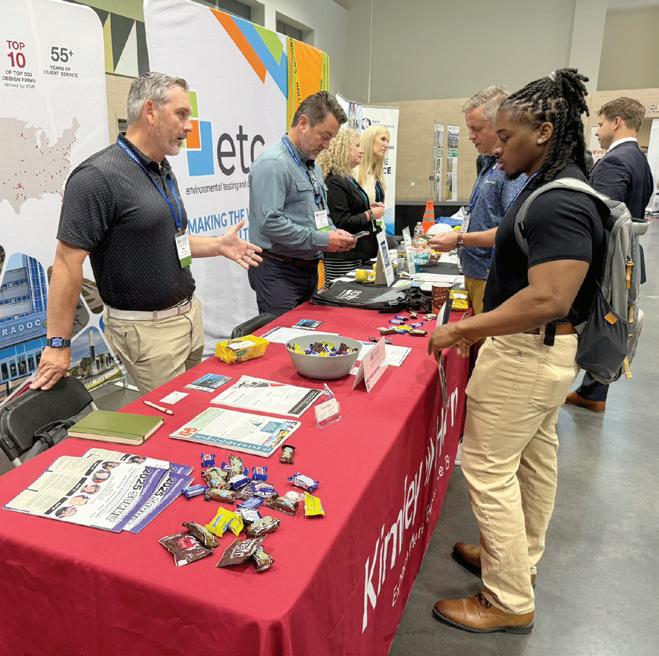
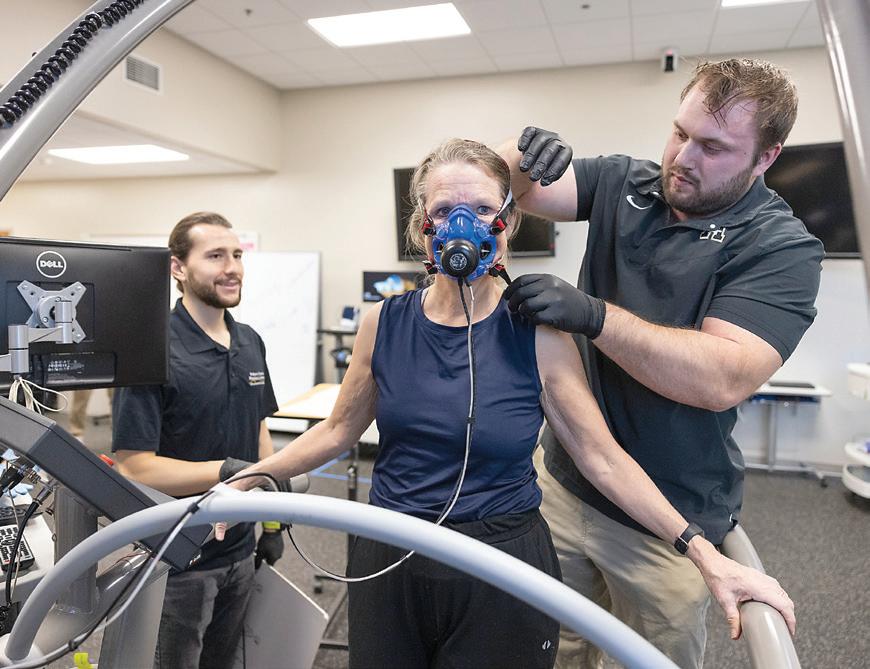



App State research fuels progress in rural health, energy and agriculture
Appalachian State University’s recent designation as one of five R2 universities in North Carolina recognizes the steady growth in research investments and expanding graduate programs at the public, rural-serving institution, which offers programs in Boone, Hickory and online. Rooted in a strong connection to place and people and a commitment to meeting industry and workforce needs in the communities it serves, App State’s research brings faculty, staff and students together to advance applied solutions — from documenting and preserving the unique cultural and natural aspects of our rural areas and strengthening community resilience to addressing challenges in health, energy, agriculture and the environment.
“At App State, our undergraduate students have opportunities to work directly alongside dedicated faculty mentors on research that addresses real-world challenges — with the potential to change industries and communities with breakthrough discoveries and innovations,” said App State Chancellor Heather Norris.
App State is fusing research with experiential learning, industry collaboration, regional partnerships and transdisciplinary efforts that connect and strengthen work across academic departments. With a base of expertise that spans many branches of knowledge and builds deep and innovative connections across them, the university is positioned to drive meaningful local impact with the potential for global reach — meeting today’s challenges through adaptive approaches in technology, business and society while honoring the region’s cultures and traditions.
Research and creative activities play a vital role in achieving the highest caliber educational experience, expanding knowledge and serving the citizens of North Carolina. These efforts contribute to:
• Deepening learning experiences, preparing students for successful careers and advanced study
• Preparing students to make meaningful contributions to their workplaces, communities and society at large
• Building partnerships that positively impact communities and develop students’ practical skills
• Supporting the region in meeting both short- and longterm needs and goals
App State faculty work to address rural health needs through numerous partnerships throughout the region. In nutrition labs at the Beaver College of Health Sciences, researchers analyze the composition of foods and create dietary plans addressing a wide range of needs, while studying the effects of these interventions. Faculty with the Healthy Outdoor Play and Exercise Lab delve into the benefits of outdoor play and exercise for young and old, while the Human Performance Laboratory pushes the frontiers of our understanding of how various nutrition measures can counter common ailments like inflammation and oxidative stress. With support from the National Institutes of Health, faculty are investigating suicide risk among youth subpopulations, and the Aging and Adult Health Interdisciplinary Research Group works with community partners to understand and address healthy aging and age-related diseases.
AppDocs, a documentary program at App State, is a regional leader in finding, documenting and sharing important stories from the Appalachian region — connecting students and communities to the mountains’ history while challenging myths and misconceptions. The program has produced award-winning films that have been screened on television programs, at film festivals, in museums and internationally. Recent work spotlights the community spirit and resilience in the small town of Todd, N.C., as it rallied in the wake of Hurricane Helene.
App State’s Team Sunergy is an award winner in designing, building and racing solar vehicles in the American Solar Challenge and the Formula Sun Grand Prix. The program engages students across engineering physics, technology and other STEM fields, as well as in business and communications. Students also show their innovative strength creating solutions for real-world challenges in the U.S. Department of Energy-sponsored Solar District Cup competition and Solar Decathlon Design Challenge, focusing on distributed energy systems for districts and high-performance buildings, respectively.
App State’s Teaching and Research Farm is one of the nation’s largest of its kind — a living laboratory where students immerse themselves in practical crop and livestock research, integrated farming systems and forest management. In another area of research, a team of App State researchers — including a student cohort — is developing a novel AI-enhanced robotic microscope that aims to dramatically streamline parasite identification, supporting our state’s farmers and strengthening food production systems worldwide. And students roll up their sleeves alongside faculty researchers in App State’s Department of Chemistry and Fermentation Sciences, where research applying modern chemistry to traditional fermentation practices aims to enhance flavor, health benefits, efficiencies and product quality across food production, brewing, and biofuel industries.
Serving the community has always been a bedrock principle of App State. When Hurricane Helene struck, App State responded swiftly and with purpose to provide much-needed resources and support, and the university remains committed to this promise. This spring, as recovery efforts continued across the region, App State’s Office of Research and Innovation convened nearly 100 stakeholders — including state and federal officials, nongovernmental organizations, civic and philanthropic organizations and educational institutions — to help drive discussions on how App State research and community partnerships can help the region build back stronger and more resilient against future events. The Western North Carolina Research for Recovery and Resilience Workshop represented, in the words of Chancellor Norris, “the beginning of a next step we will take together.” A forthcoming white paper resulting from the workshop will support the mobilization of multiple research projects to address resilience needs in the region.



East Carolina University has officially joined the ranks of the nation’s top research institutions, earning the prestigious R1 designation from the Carnegie Foundation and the American Council on Education. But this milestone is more than a label — it’s a turning point. Rooted in eastern North Carolina, ECU has emerged as a national research engine, helping reshape what a future-focused research university can be: hands-on, community-engaged and mission-driven.
“This is the university that is creating the model for what the American research university will be in the future. Period. End,” said Ted Mitchell, president of the American Council on Education, during a Spring campuswide celebratory event.
ECU’s research enterprise has long delivered measurable public value. From strengthening rural health systems and accelerating small town revitalization to equipping the state’s workforce with tools to face the challenges ahead, the university is aligned with the priorities of the region and the state and focused on tangible outcomes. Now, with the R1 banner flying high, ECU is poised to amplify the impact of its research.
Chancellor Philip Rogers sees this designation as a springboard.
“Our rise to R1 is not an endpoint,” said Rogers. “It’s a launchpad for deeper partnerships and bigger solutions. ECU is positioned to serve as a hub for interdisciplinary research and applied innovation that reaches far beyond our region.”
ECU’s commitment to meaningful discovery is woven into the very fabric of its research ecosystem. Faculty collaborate across fields, and with local, regional, and national partners, to develop solutions that address rural health care gaps, drive innovation in advanced manufacturing, and strengthen economic resilience. The work is grounded in one goal: making a difference with lasting results.
“Our research is about impact,” said Dr. Sharon Paynter, ECU’s chief innovation and engagement officer and interim chief research officer. “Our work improves lives and strengthens communities.”
With a spirit of co-creation, ECU’s innovation and research activities extend beyond the lab bench through partnerships with pharmaceutical and manufacturing industries, military agencies, municipalities, and community organizations.
According to Mark Phillips, executive director of the NC Biotechnology Center’s eastern office, “ECU has long been a driver of economic growth in life sciences. As more companies


learn about the University’s capabilities and R1 status, its impact on innovation and business development will only accelerate.”
The university’s collaborative spirit is evident in its faculty and student engagement. ECU research teams work across disciplines to develop solutions that reach people where they live and work. Kinesiology professor Dr. Bhibha Das and music therapist Dr. Adrienne Steiner-Brett, for example, teamed up on a virtual clinic project that integrates health science and the arts to support caregivers by reducing stress and enhancing overall well-being.
Meanwhile, faculty members Dr. Jo Anne Balanay from health education and promotion and Dr. Sinan Sousan in public health have launched a heat stress monitoring app, developed with support from the American Industrial Hygiene Association. Available through major app stores, the platform helps outdoor workers, such as farmers and construction crews, assess the risk of heat-related illness while on the job.
Dr. Jessica Cooke Bailey said she was drawn to the university because of ECU’s mission. “There’s space to innovate, build partnerships, and do research that matters,” the geneticist said. “Now, with R1, those opportunities are multiplying.”
The university’s service-focused commitment extends to students, who—from the start of their academic journey — are integrated into projects that address needs. By investing in student research, the university fosters
a mindset of impact early on, preparing students to be not just scholars, but to become problem-solvers and changemakers. For fourth-year doctoral student Maddi Craney, this means developing and licensing cancer therapeutics with direct clinical potential. “It’s a blend of science and entrepreneurship,” she said, “and it’s directly tied to patient outcomes.”
Industry leaders recognize the value of ECU’s model. Hyster-Yale Group located its emerging technologies division on ECU’s research and innovation campus to take advantage of the collaboration potential. Steven LaFevers, vice president of emerging technology, praised ECU’s academic preparation with real-world problemsolving: “What ECU is doing — aligning education with innovation — is exactly what companies like ours need.”
This alignment is further demonstrated through ECU’s integrative approach. “We don’t research in a vacuum,” Paynter said. “We work side by side with communities, clinicians, entrepreneurs and educators. If you have a challenge, we want to solve it together.”
ECU’s rise redefines what a research university can be and what it can do. At a time when higher education faces increasing pressure to demonstrate relevance and return on investment, ECU’s answer is simple: collaborate, innovate and deliver impact.
“If you’re looking to pilot a technology, expand a study, launch a joint center or test an idea in the field, ECU offers the infrastructure, the talent and the mission alignment to make it happen,” said Paynter.
“In the future, every R1 is going to aspire to be ECU,” Mitchell said. That future is here — and ECU is ready to make way.






Fayetteville State University has undergone a dramatic transformation in its research landscape, with investment tripling and earning recognition as a research institution by the Carnegie Classification. This historically black university is making significant contributions across diverse fields, from developing non-toxic pesticides to advancing artificial intelligence for national security applications.
REVOLUTIONARY PESTICIDE RESEARCH PROTECTS
AGRICULTURE AND ENVIRONMENT
Dr. Shirley Chao’s groundbreaking work in the Department of Biological and Forensic Sciences exemplifies FSU’s commitment to solving real-world problems. Her team has developed a revolutionary, non-toxic pesticide derived from hemp that effectively controls agricultural pests.
The discovery began serendipitously when a graduate student in Chao’s entomology course chose to feed hemp to darkling beetles. While the insects initially thrived, they eventually died without reaching full maturity. This “happy accident” led to years of research refining the formulation into what could become a game-changing agricultural product.
The impact potential is enormous. Pests destroy 20-40% of global crop production annually, with invasive insects alone costing the global economy an estimated $70 billion per year. Traditional pesticides, while effective, pose significant risks to non-target organisms, including birds, fish, bees, and humans. DDT, banned in 1972, exemplifies the environmental and health consequences of toxic pest control methods.
“We want to develop pesticides that are safe but effective against the pest,” explains Chao, whose hemp-based compound has proven effective against darkling beetles, flies, cockroaches, and other insect pests while showing no adverse effects on chickens or fish during testing.
For North Carolina’s poultry industry, which contributes $39.7 billion to the state’s economy and creates nearly 150,000 jobs, this innovation addresses a critical need. Darkling beetles infest commercial poultry facilities, with females laying up to 2,000 eggs over five days, rendering traditional cleaning methods insufficient. Current pesticides are too toxic to use inside livestock facilities while poultry is present, creating a perfect application for Chao’s non-toxic alternative.
The research has attracted the attention of NCInnovation, which recently designated FSU as a regional hub. Chao’s project has recently been funded with over one million dollars to help navigate the EPA’s registration process and bring the product to market through partnerships with North Carolina companies.
FSU’s Intelligent Systems Laboratory (ISL), directed by Dr. Sambit Bhattacharya, represents another pillar of the university’s research excellence. This cutting-edge facility within the Department of Mathematics and Computer Science explores use-inspired data science, artificial intelligence, machine learning, and cybersecurity through collaborations with national research laboratories and government agencies, including NASA and agencies within the US Intelligence Community (IC).
The ISL’s 12-faculty team works on projects with significant national security implications. In partnership with the Laboratory for Analytic Sciences at NC State University, researchers are developing synthetic data to help computers detect rare and unique objects, with support from IC researchers. Another critical project focuses on making AI and machine learning more efficient on edge computing devices operating in constrained networks with limited battery power—essential for collecting data from autonomous devices in contested environments, where standard computing equipment and everyday wireless communication can expose operators to risk.
ISL has partnered with NASA’s Jet Propulsion Laboratory (JPL) to develop AI software designed for edge computing applications in space environments. This collaboration has yielded multiple innovations, including AI software, which is likely to be scheduled for orbital testing aboard a satellite mission. The partnership has also produced advanced AI systems capable of analyzing planetary data from across our solar system.
These joint research initiatives demonstrate ISL’s commitment to pushing the boundaries of AI in extreme environments, where traditional computing approaches face unique challenges, including power constraints, radiation exposure, communication risks and delays, and the scarcity of data for training AI.

FSU’s research expansion extends across multiple disciplines, demonstrating institutional commitment to innovation:
Advanced Materials: Faculty members are developing two-dimensional MXene nanoparticles with broad electronic applications and nanosensors capable of detecting PFAS and enzyme-based disease markers, supported by funding from the Department of Energy and the NSF.
Biotechnology: Beyond Chao’s pesticide work, teams are developing testing kits for periodontal disease and investigating the effects of environmental stressors on soil bacteria, thanks to funding from the NC Biotech Center and VentureWell.
Cryptography: Researchers are developing efficient access control systems for implantable medical devices and studying linear feedback shift registers with NSF support.
Geospatial Intelligence: NASA-Funded Partnerships Advance Electron Probe Microanalyzer Applications.
FSU’s research transformation represents more than academic achievement—it’s a catalyst for economic development in North Carolina. The university’s designation as an NCInnovation regional hub positions it to translate research discoveries into commercial applications, supporting the state’s innovation economy.
The institution’s success demonstrates how strategic investment in research infrastructure and faculty can rapidly elevate a university’s profile and impact. From accidental discoveries in biology labs to sophisticated AI algorithms serving national security, FSU exemplifies North Carolina’s commitment to research excellence across its diverse higher education landscape.
As FSU continues to build research capacity, its contributions to agriculture, technology, and national security are likely to expand, reinforcing North Carolina’s position as a leader in applied research and innovation.
Collaborate with us. Learn more at uncfsu.edu/research.




Dr. Ganesh Bora Associate Vice
Chancellor
for Research and Technology Innovation
(910) 672-1442
gbora@uncfsu.edu




The Piedmont Triad is experiencing unprecedented growth in advanced manufacturing, with Guilford Technical Community College (GTCC) at the center. JetZero’s landmark decision to establish their Z4 factory at Piedmont Triad International Airport underscores GTCC’s critical role as North Carolina’s premier workforce development partner.
JetZero’s selection of the Triad for its revolutionary blended wing body aircraft manufacturing facility represents a pivotal moment for North Carolina’s aviation industry. As an economic development partner with the Airport Authority, Greensboro Chamber of Commerce, and NC Department of Commerce, GTCC helped secure JetZero’s choice of PTI.
GTCC will serve as a premier training partner for JetZero’s technical and production workforce, working closely with the company to develop manufacturing processes and define workforce requirements. JetZero’s Z4 aircraft, designed to transform commercial aviation through fuel efficiency and enhanced passenger experience, relies heavily on composite materials—an area where GTCC has built expertise.
As the lead community college for the NC Edge customized training project, GTCC will partner with colleges across the Triad and throughout North Carolina to provide the skilled workforce essential for JetZero’s success.
GTCC’s commitment to aviation excellence drives an ambitious, two-phase infrastructure expansion. Phase one is the construction of a $34.6 million, 70,000-square-foot aviation training building on the Cameron campus in Colfax, North Carolina, supported by state and county funding. The new facility will expand capacity to prepare over 700 students annually for high-wage aviation jobs and is slated to open spring 2027. The building also enhances GTCC’s capabilities in aircraft manufacturing, avionics, and composite technologies— critical for JetZero’s operations. Phase two, which is still in the planning phase and not yet funded, includes a second 70,000-squarefoot facility increasing capacity to over 1,000 students annually.
GTCC’s aviation programs span aviation electronics to systems technology and aerospace manufacturing. Through hands-on training with industry-standard equipment and curriculum developed with aviation industry leaders, students graduate workforce-ready.
Beyond aviation, GTCC impacts North Carolina’s manufacturing landscape through its NC FAME program. The North Carolina Federation for Advanced Manufacturing Education, First in Flight Chapter, recently graduated its inaugural class of 12 students— demonstrating immediate workforce development impact.
Guilford Technical Community College is the third largest of 58 institutions in the North Carolina Community College System. Serving more than 30,000 students annually from five campuses and a Small Business Center, GTCC offers over 80 programs of study, including flexible, low-cost options for earning associate degrees, diplomas, and certifications. GTCC is rooted in innovative education, training, and partnerships.

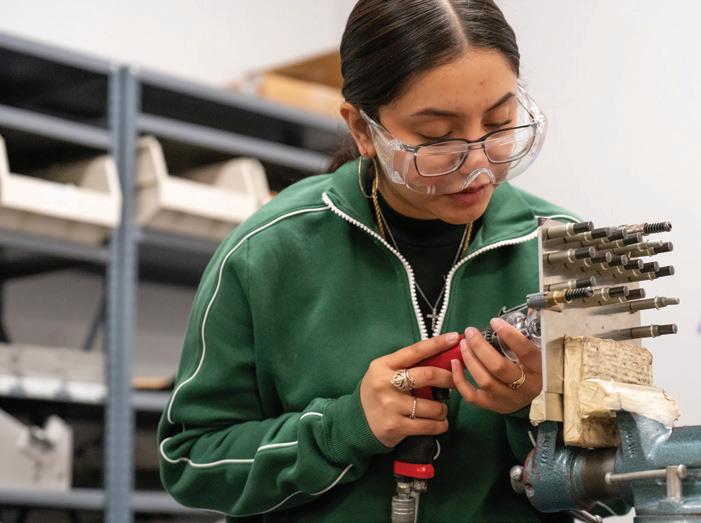

NC FAME provides an innovative approach: a two-year, debt-free associate degree while building skills for today’s manufacturing landscape. Students work paid positions three days weekly with sponsor employers while attending GTCC classes two days.
Four partnering manufacturers sponsored the 2025 graduating class: Jowat Corporation (two students), MasterBrand Cabinets and Proctor & Gamble (one each), and Toyota Battery Manufacturing North Carolina (eight). After earning 1,800 hours of experience, approximately 85% of graduates secure direct employment with sponsors.
The First in Flight FAME Chapter includes nine employers: ABCO Automation, Cascade Die Casting Group, Daimler Truck North America, Jowat Corporation, MasterBrand Cabinets, Proctor & Gamble, Toyota Battery Manufacturing North Carolina, WestRock, and ZIEHL-ABEGG. These partnerships demonstrate versatility across manufacturing sectors.
This success reflects GTCC’s broader approach to industry collaboration. By working directly with employers to develop curriculum aligned with specific needs, GTCC ensures graduates possess skills demanded by today’s manufacturing environment.
As North Carolina attracts major manufacturing investments, GTCC stands ready to train a skilled workforce. The college’s focus on aviation excellence and advanced manufacturing innovation positions the Piedmont Triad as a premier destination for companies seeking worldclass facilities and trained technicians.
Through NC FAME and expanded aviation training, GTCC shapes North Carolina’s manufacturing future, ensuring state competitiveness while providing exceptional career opportunities across the region.

GTCC’s planned phase one of $34.6 million, 70,000-square-foot aviation training facility on the Cameron campus in Colfax will break ground this fall.

GUILFORD TECHNICAL COMMUNITY COLLEGE 601 E. Main Street Jamestown, NC 27282 336-334-4822 info@gtcc.edu
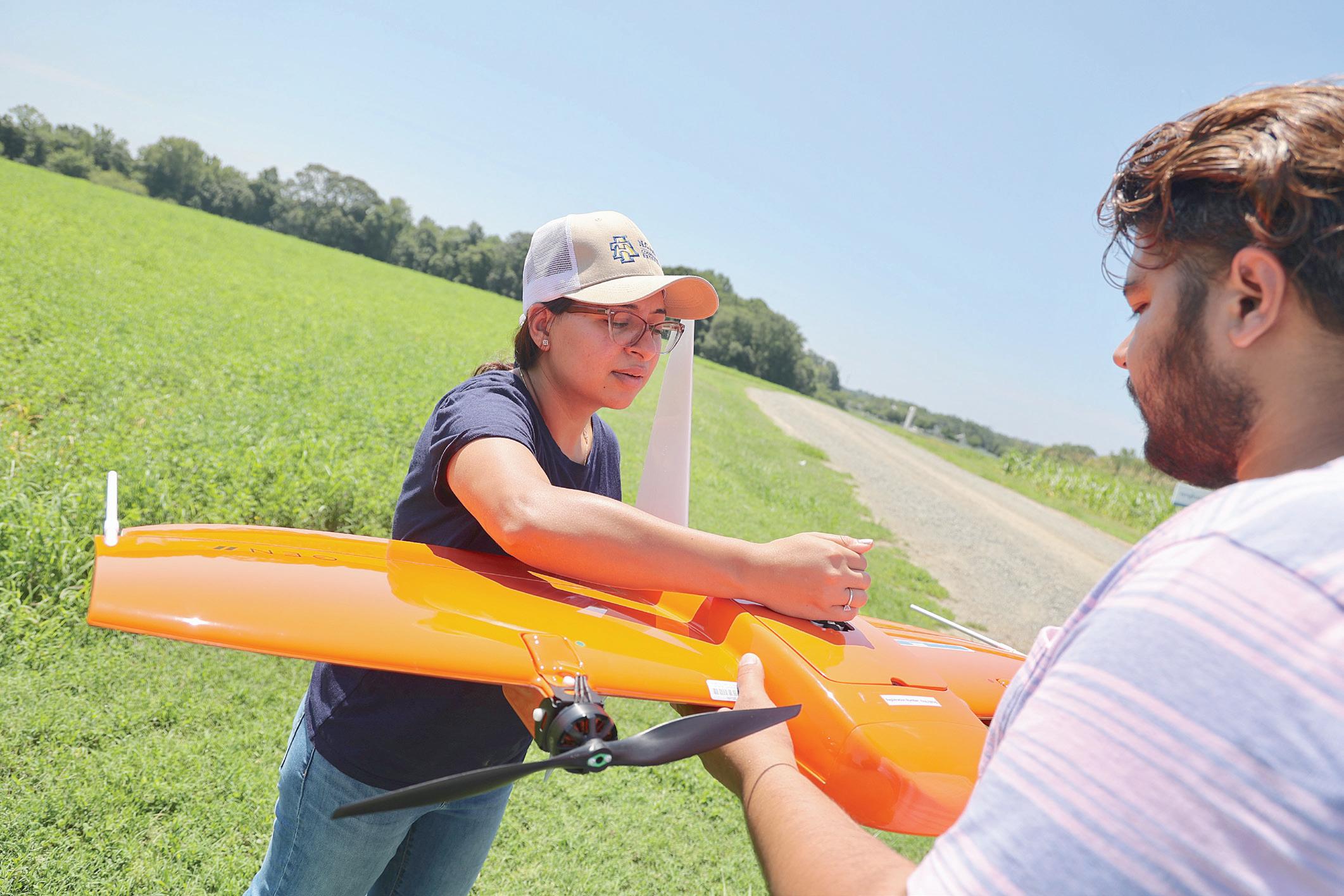
FROM CROP ROTATION AND MACHINERY TO CHEMISTRY AND GENETIC MODIFICATION, FARMERS HAVE RELIED ON TECHNOLOGY TO IMPROVE THEIR HARVESTS.
The latest advance is data-driven agriculture. By collecting and analyzing more information about plants than ever before, N.C.
A&T State University faculty member Harmandeep Sharma, Ph.D., is helping small farmers make smarter data-driven decisions.
“Farming is moving very quickly toward data-driven digital agriculture. It gives us the capacity to use multiple sensors to collect a massive amount of data and then use those data sets to plan how we’re going to grow crops sustainability and efficiently and anticipate possible yields,” said Sharma, a research assistant professor in crop science.
“Big commercial farmers are already using sensors, drones and digital technologies to improve their output,” Sharma added. “Some of this technology is actually very affordable, and the challenge now is to make sure that small, limited-resource
and minority farmers have access to it. Through my work and the work of the College of Agriculture and Environmental Sciences, we want to show that even small-scale farmers can benefit from these latest technologies.”
Sharma joined the Department of Natural Resources and Environmental Design in 2019 after earning her doctorate in biology from Idaho State University. In 2022, she established a digital agriculture research lab now known as the SENSE (Sensors for Sustainable and Efficient Plant Production) Lab. With support from a research associate and graduate and undergraduate students, Sharma deploys ground and aerial sensors — drones equipped with thermal and multispectral imaging cameras — to gather more precise real-time information about plant health, soil fertility and water usage and point out crop distress before farmers can see it.
Data collection is only the first step in digital agriculture. Sharma uses the high-performance SAS Viya data and artificial intelligence platform to store and analyze enormous data sets and produce predictive models more quickly than ever. SAS, the software company based in Cary, made this cloud-based platform available in 2024 to researchers at N.C. A&T and N.C. State through a $1 million allocation from the N.C. General Assembly.
Sharma said this data allows farmers to practice site-specific management using variable-rate technology. Rather than cover an entire field with uniform amounts of water and fertilizer, in other words, farmers can deliver these inputs exactly when and where they’re needed based on the spatial variability throughout the farm.
“SAS Viya is a great tool,” Sharma said. “I’m collecting so much data, and I’m able to analyze those data sets to translate into actionable information I can share with farmers.”
Sharma is deploying ground sensors in her own research to improve yields of different cultivars of hot peppers and industrial hemp — two high-value specialty crops that can generate strong profits for small farmers. Soil sensors continuously monitor the amount of moisture in the soil. Plant sensors track the amount of sap flowing through the stems and the photosynthesis rate in the leaves. Weather stations collect data on air temperature, relative humidity, soil irradiation and other conditions. These sensors are connected to an irrigation system so plants get the exact amount of water they need at the proper time. The data collected by these sensors ultimately will be used to build algorithms to predict the precise demand for irrigation.

down costs for farmers.”
Her sensor project is supported by a $767,401 Evans-Allen program grant over three years from the U.S. Department of Agriculture’s National Institute of Food and Agriculture.
“We are tracking every drop of water — from how it’s moving from the soil through the plant to the leaves,” Sharma said. “It’s important not to add extra water that’s not utilized by the plants because it will evaporate or it will lead to soil leaching that contributes to pollution. By using precision irrigation, we’re able to apply the right amount of water at the right time. That will help improve environmental sustainability and hold
Sharma is bringing data analytical skills using artificial intelligence to students in her graduate-level courses, Experimental Methods in Research and Crop Ecology. As an SAS+ HBCU Fellow — she was one of four educators nationally at historically Black colleges and universities to receive this honor in 2024 — Sharma receives assistance from SAS team members on integrating the SAS Viya platform into her curriculum.
For more information visit ncat.edu

“Being able to work with data is a critical skill set that my students need to develop because it will help them when they go into the job market,” Sharma said. “It’s also important to train the next generation of scientists to conduct data-driven experiments in their labs and then share that information with farmers. Agriculture is changing rapidly, and small-scale farmers need to be able to use this data to help them make a profit and grow their crops efficiently and sustainably.” North

By Mary Hecht-Kissell, Vice President of Corporate Communications, North Carolina Biotechnology Center
North Carolina’s life sciences ecosystem is richly diverse. Of the 840 life sciences companies in the state, did you know that 470 companies have research and development as their primary business function? Forty of those companies currently have ongoing clinical trials.
Since 1984, the North Carolina Biotechnology Center has led life sciences technology-based economic development for the state, accelerating the progression of ideas from the research lab to the marketplace. NCBiotech’s Emerging Company Development (ECD) team champions a variety of programs to foster innovation statewide.
NCBiotech’s loans program fills gaps in technology development, helping North Carolina-based startups reach development milestones while positioning them to attract follow-on funding. Small Business Research Loans, ranging from $150,000 to $350,000, support early-stage product development to help companies be better positioned for successful fundraising and partnering activities. Strategic Growth Loans, capped at $650,000, are matched by investment from angel or venture capital groups and help companies achieve critical, value-
inflection milestones to position them for advanced development and commercialization.
To date, $63M in loans have been provided to 280+ life sciences startups statewide. These companies have raised more than $8B in follow-on funding. Since the inception of the loan program, 53 companies have had exits, either through an initial public offering or a merger/acquisition, providing a clear testament to the impact of the program.
NCBiotech’s Entrepreneurs in Residence Program connects startups with successful business leaders who provide coaching, strategic support and connections to resources.
“I’ve thoroughly enjoyed helping young companies in many of the same ways we were helped in the early days of Humacyte,” said Juliana Blum, Ph.D., an NCBiotech Entrepreneur in Residence, who formerly co-founded and grew Humacyte to a valuation of over $1B. “Think about how hard it is to bring an innovation to life and make it commercially viable. This is when you need people you can count on.”

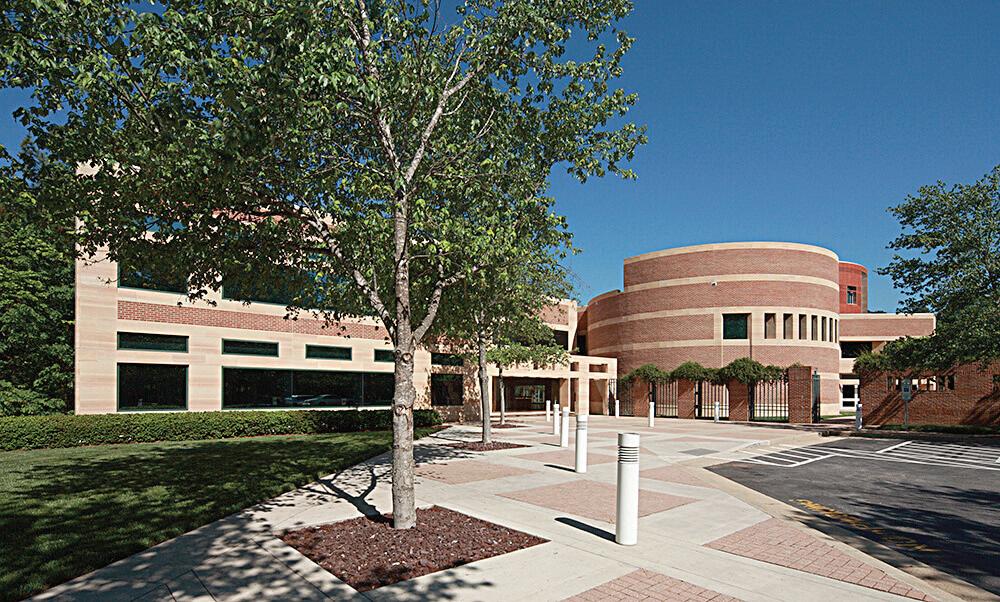
In addition to the Entrepreneurs in Residence, the ECD staff provides coaching and mentoring to companies within the NCBiotech loan portfolio, advising on everything from product development and fundraising to business plans and investor presentations.
ECD also fosters deep relationships with investors, as well as tech scouts from global pharmaceutical companies, to facilitate matchmaking between these groups and promising startups.

Investors and big pharmaceutical companies are taking note of startups and cutting-edge technologies coming from the Tar Heel state. With five R-1 research universities, North Carolina has the scientific talent and capacity to develop next-generation technologies. AskBio, G1 Therapeutics and Locus Biosciences are examples of successful companies spun out of North Carolina universities.
• Atsena Therapeutics, a clinical-stage gene therapy company, raised $150M in April 2025, to advance its lead investigational treatment of X-linked retinoschisis, a genetic retinal disorder that leads to blindness.
• Tune Therapeutics, a clinical-stage company, raised $175M in January 2025, to advance its pioneering
gene-tuning platform.
• Pathalys Pharma, a late-stage company, raised $105M in August 2024, to advance its NDA submission and pre-commercialization efforts for its late-stage clinical treatment, upacicalcet, for patients with end-stage kidney disease.
In addition to landing large investments, North Carolina life sciences startups continue to secure significant partnerships with global pharmaceutical companies:
• In September 2024, Lindy Biosciences, entered into an exclusive global licensing agreement and strategic collaboration with Novartis Pharma AG, a subsidiary of the Swiss medicines giant Novartis AG. The collaboration, worth up to $934M, focuses on converting certain Novartis medicines into convenient, self-administered, subcutaneous injections using Lindy’s proprietary “microglassification” technology for drug delivery.
“North Carolina has excellent opportunities for investors,” said Mike Carnes, vice president of Emerging Company Development at NCBiotech. “Investors can find early-stage companies with advanced technologies and products that address unmet market needs and offer the opportunity for significant value creation. Given our state’s highly collaborative ecosystem, startups have access to the resources, connections and C-level talent they need to be successful.”
To learn more about

• In January 2025, IMMvention Therapeutix, Inc., an earlystage company, entered into a strategic collaboration with Novo Nordisk A/S to co-develop oral therapies for sickle cell disease (SCD). Under the agreement, Novo Nordisk will gain an exclusive worldwide license to IMMvention’s investigational small-molecule Bach1 inhibitors, thought to be a key regulator of cellular responses, oxidative stress, and inflammation in multiple disease states.
North Carolina continues to attract strong C-level talent, which is pivotal in building resilient, high-performing startups. An additional 2,500 support organizations, including IP attorneys, regulatory specialists, and clinical trials experts, round out the ecosystem. From early-stage funding and mentorship to clinical trial and manufacturing infrastructure, North Carolina delivers the support that startups need to thrive and scale.
North Carolina Biotechnology Center 15 T.W. Alexander Drive Durham, NC 27713 919-541-9366 ncbiotech.org
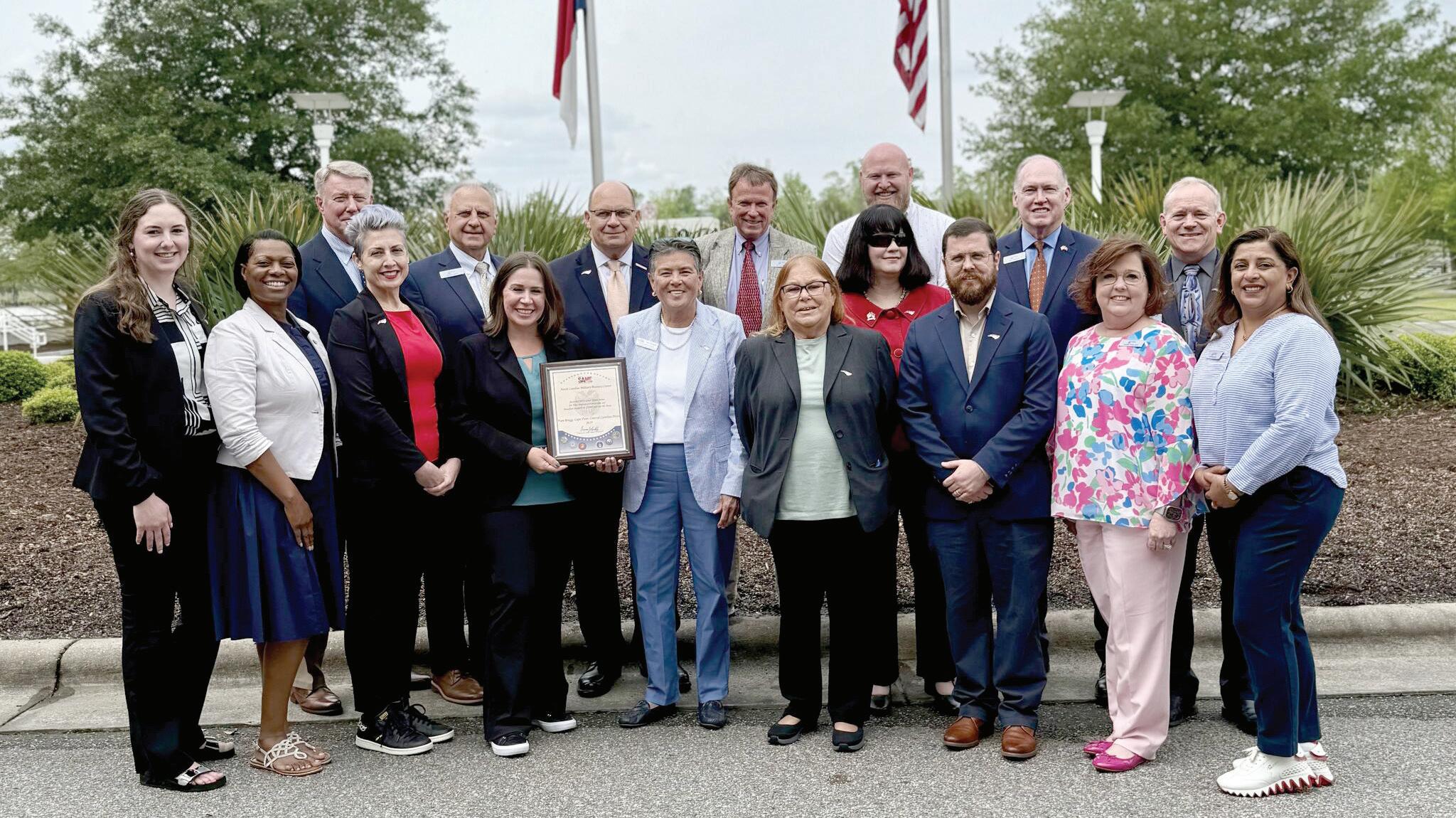
By Jaycie Beam, North Carolina Military Business Center
The North Carolina Military Business Center (NCMBC) is a statewide business development and technology transition entity of the State of North Carolina, embedded in the North Carolina Community College System and headquartered at Fayetteville Technical Community College. Serving businesses statewide, the NCMBC hosts 19 offices statewide.
The mission of the NCMBC is to leverage military and other federal business opportunities to expand the economy, create jobs, and improve the quality of life in North Carolina. The primary objective is to increase federal revenues for businesses operating in the North Carolina.
To connect North Carolina firms with current government contracting opportunities, NCMBC employs a two-prong approach – with a team of business development professionals across the state and with www.MatchForce.org. The business development team, comprised of experienced professionals in business development, industry, and procurement, identify and analyze federal contract opportunities and assist firms to understand government solicitations, prepare competitive winning proposals, and execute federal contracts.
MatchForce.org is web-based portal for federal contracting. Upon registering, businesses receive automatic matches to current and future federal prime contracting opportunities and to subcontracting opportunities posted by other businesses. Businesses that identify contract opportunities within the MatchForce portal can connect with the NCMBC business development team for individualized assistance. As a component of the North Carolina Community College System, NCMBC provides these services to the public fee-free.
In addition to business development, the NCMBC executes several strategic initiatives including market intelligence and prepositioning, training and support resources, statewide events and networking. These initiatives prepare North Carolina businesses to compete effectively in the federal marketplace. A key component of these efforts includes hosting several high-impact events in partnership with the Offices of US Senators Thom Tillis and Ted Budd. These events provide the opportunity for businesses to engage directly with federal agencies, prime contractors, and industry leaders, fostering engagement, connections, and opportunities.

Federal Technology Symposium (FTS), September 9-10, 2025 in Fayetteville, NC. FTS highlights the advanced technology needs of major military commands in North Carolina, the Department of Defense (DoD), and the Department of Homeland Security (DHS). FTS aims to create dialogue between industries, academia, and government to address the technology needs of the warfighters and security agencies. For more information, visit: defense.ncmbc.us/.
Medical, Biomedical, and Biodefense (MBB): Support to the Warfighter Symposium, September 24-25, 2025 in Chapel Hill, NC. MBB connects businesses in North Carolina with military and other federal agencies that require or purchase medical supplies, equipment, devices, staffing, pharmaceuticals, and medical services. Representatives from the DoD, Veterans Affairs, and Health and Human Services highlight current technologies or resource gaps and needs to supply military and federal medical facilities, commands and agencies. For more information, visit: mbb.ncmbc.us/.
Defense Industrial Sustainment for Combat Systems (DISC) Summit, November 18-19, 2025 in Chapel Hill, NC. This event focuses on strengthening the defense industrial base by connecting prime contractors, suppliers, and service providers with DoD agencies, commands and contracting offices in the aerospace, ground vehicle, maritime, and armaments markets. Businesses learn about contracting opportunities with the DoD, original equipment manufacturers (OEM’s), and prime contractors. For more information, visit: industrial.ncmbc.us/.




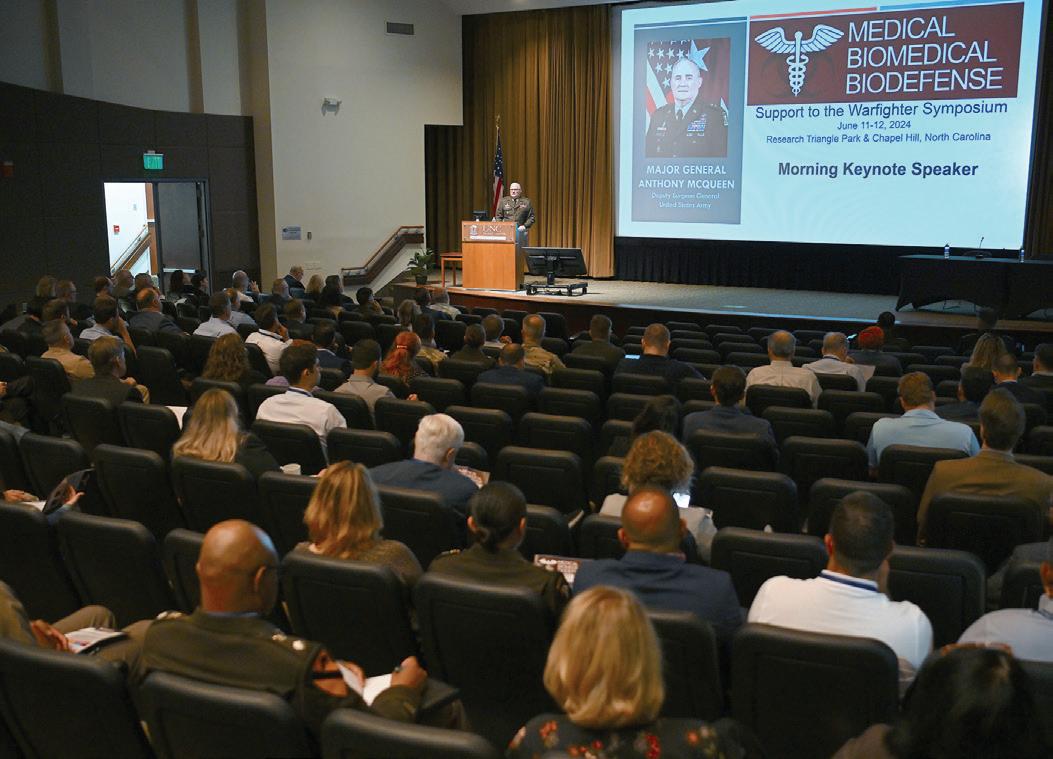
Southeast Region Federal Construction, Infrastructure and Environmental Summit (Summit), April 14-16, 2026 in Wilmington, NC. The Summit brings together over 800 representatives from the Corps of Engineers, Naval Facilities Engineering Systems Command, Fort Bragg, Marine Corps Installations East, Seymour Johnson Air Force Base, US Coast Guard, Department of Veterans Affairs, General Services Administration, other federal agencies, general contractors, and suppliers throughout the southeast. The Summit provides an opportunity for businesses to meet with these agencies and to market their services and products. For more information, visit: summit.ncmbc.us/.
Federal and Defense Textile and Tactical Equipment (FEDTEX) Summit, May 19-20, 2026 in Raleigh, NC. FEDTEX connects the DoD and federal agency clothing and individual buyers with US textile manufacturers, textile supply chain suppliers, research and development facilities, and academic resources. This event encourages networking with new and existing businesses in the clothing and textile marketplace, and aims to establish a direct dialogue between government, businesses, and academia around critical warfighter issues in the defense textile marketplace. For more information, visit: fedtex.ncmbc.us/.
Why attend? NCMBC provides businesses with a variety of programs, opportunities for networking, and direct access to key stakeholders in the federal workplace. If you are a business exploring government contracting for the first time or an established business seeking to expand, NCMBC offers the tools, expertise, and connections to help you succeed.
Scott Dorney, Executive Director scott@ncmbc.us
Courtney Smedick, Director of Operations courtney@ncmbc.us
Jaycie Beam, Program Support Specialist beamj@ncmbc.us

RTI International Brings Innovation and Revenue to NC.
“RTI’s foundation is strong; we are here to lend our research capabilities for the broad range of government and industry clients in our state and throughout the nation.”
Tim J. Gabel, RTI President and CEO
An anchor in Research Triangle Park, RTI International is the largest independent scientific research institute in the Southeast. Steeped in innovation, new ideas and big solutions, RTI is committed to delivering real-world results through its mission to improve the human condition—for approximately 1,000 clients across government and industry. Research is at the heart of its work and a critical part of the state’s economy.
Looking back at data from fiscal year 2024, RTI’s economic impact is clear: the institute generated more than $45 million in state and local tax revenue. This investment supports economic growth in both urban and rural areas including essential services such as education, health care and infrastructure, which are crucial for the well-being and development of communities in the state of North Carolina.
RTI employs a highly skilled workforce of 2,000 North Carolina-based staff members, providing $362 million in salaries and benefits in more than 50 local counties. These jobs attract talent to the region with accolades including Forbes’ 2025 designation as one of “America’s Dream Employers.”
RTI also invested $45 million, buying goods and services from 365 local businesses and provided approximately $836,000 to NCbased organizations through its Community Affairs program.
With innovation and efficiency top of mind, RTI researchers are fully embracing new technologies. They are leveraging AI to enhance public health communication for clients. While not a replacement for public health professionals, these tools assist with things like grouping and tagging answers from open-ended survey responses, spotting trends and key findings
“RTI is a digital-first, high-impact research institute that delivers innovation, efficiency and real-world results to support safer and healthier communities.”
Tim J. Gabel
in large datasets, and tracking social media conversations to better understand reactions to public health messaging.
RTI is also actively exploring how generative AI tools can support visual storytelling in health care. Teams are using these technologies to develop step-by-step training scenarios, taking advantage of their ability to convey detailed health stories and produce highly realistic images to enhance patient understanding.
A team of data scientists has developed a new synthetic population dataset that offers groundbreaking research opportunities using “digital twins,” which mirror the U.S. population while protecting individual privacy. This data can be used in simulation models to study infectious diseases as well as chronic illnesses and is publicly available for research and collaboration. Using this new dataset, in tandem with AI and machine learning, reduces upfront cost and enables seamless scalability for future applications.
RTI is transforming its business for the future. The institute is expanding its energy lab, the RTI Pilot Xcelerator, beginning in the fall of 2025 to host additional scale-up projects for commercial and government clients. The expansion will lead to more than 25,000-square-foot of plug-and-play bay space, additional laboratories, and workspace to demonstrate the industrial applications of new energy technologies as they transition from bench to pilot scales towards commercialization. Some of the innovative energy solutions include carbon capture from the power sector, producing jet fuel from non-traditional sources such as CO2 and electricity, waste-to-energy/chemicals, iron and steel, and critical minerals, among others.
This spring, RTI researchers issued a first-of-its-kind study that found chemicals in beer known as per- and polyfluoroalkyl substances or PFAS. These synthetic “forever chemicals” don’t easily break down and are known to cause adverse health effects. RTI’s findings aim to keep Americans safer and healthier by encouraging consumers to check the water sources of their beverages. The research findings also highlight the need for water utilities to enhance their treatment processes and breweries to test and potentially filter their brewing water.

“RTI
is growing through new channels, accelerating progress in solving big problems in North Carolina and beyond.”
Tim J. Gabel
RTI’s in-house capabilities span PFAS research, including assessment, testing, remediation and identification of alternatives.
The institute is also exploring partnerships to increase storm resilience in Western North Carolina, borrowing from the hydrometeorology expertise of its Center for Water Resources staff, who specialize in river forecasting, flood analysis and water management. The aim is to help mitigate the devastating impacts of storms like Hurricane Helene in the future.
Research is a key element of North Carolina’s economic success and there will be a continued need for evidence-based solutions to address pressing challenges facing the state and the nation. RTI is built for the future with extensive research capabilities, advanced analytics, data science, AI and digital systems to solve real-world problems efficiently and at scale.
3040 East Cornwallis Road
Durham, NC 27713
919-541-6000 rti.org

Solve this riddle: Your innovation-based company is in the development phase of what could be a life-altering technology. You need funding to complete the prototype, but equity investors and banks aren’t interested in offering money to a company that hasn’t commercialized their product yet. You and your team know that the technology you’re developing could have a significant impact on your industry, but from an investor’s perspective, your company is high-risk. So how do you fund it?
Enter the Small Business Innovation Research (SBIR) program . Enacted in the early 1980s, the SBIR program requires that federal agencies with more than $100 million in extramural research and development funds set aside 3.2% of their budget to offer grants to early-stage innovationbased companies that are deemed too risky for traditional investors. “SBIR funding has transformative impacts on small businesses,” said Connor Steenbock, technology commercialization counselor with the Small Business and Technology Development Center (SBTDC). “Countless technology entrepreneurs have leveraged the SBIR program to launch their business, grow their R&D endeavors, and ultimately accelerate their journey to market.”
How do you know where to start? Set up an appointment with the SBTDC’s technology development and commercialization program, of course. This no-cost program helps eligible small businesses incorporate SBIR into their funding strategies by identifying appropriate agencies and topics on a case-by-case basis and offering extensive feedback on grant applications.
Sixty-one percent of North Carolina awardees in 2024 were SBTDC clients, with awards totaling $117 million. “The SBTDC is equipped to guide innovation-based small businesses through the funding journey as they continue their R&D efforts and ultimately transition to commercialization,” said John Ujvari, director of the SBTDC’s technology program, which also offers an array of also offers an array of organized training for innovation-based businesses, including SBIR proposal development, business development, and follow-on equity funding sessions. “Over seven-hundred innovators have attended our trainings and five-hundred clients have utilized one-on-one counseling services in the past year,” Ujvari said.

Two of those clients, ARtx in Cary and BMI OrganBank in Winston-Salem, shared how vital SBIR grants have been for the growth of their businesses.
ARtx, a pre-revenue startup developing AI-driven technology to support the growth of 3D concrete printing, needed funding to develop a computer vision technology to automate a portion of the 3D process. Since 2023, they have received $500,000 in SBIR grants and are currently writing a proposal to fund the development of the AI algorithm for their computer vision product. “SBTDC has been a go-to source for us on many aspects of our business,” said Ladson Brearley, co-founder of ARtx. “When we need guidance on something nontechnical, SBTDC has been able to answer our questions or point us in the right direction.” Their SBIR grant strategy is “smart, effective, and multi-pronged,” said SBTDC counselor Steenbock, who has worked directly with the company. He emphasized the huge growth potential in their niche and the importance of targeting grants from multiple agencies.
BMI OrganBank’s flagship medical device has the potential to eliminate the years-long waitlist for lifesaving kidney transplants by dramatically improving organ assessment and transport capabilities. That flagship product was developed through a $2 million SBIR grant awarded after extensive feedback and support from the SBTDC. The company was awarded an additional $2.7 million to advance their product toward readiness for a clinical study that will support FDA approval. “SBTDC was an important catalyst early in the company’s development,” said Bob Neusner, President and COO of BMI OrganBank. “And they are really nice people.”

Small businesses that receive Phase I awards can request up to $300,000 over six to twelve months to fund concept development and feasibility studies. Phase II awardees can request up to $2.1 million to work on prototype development of their technology over two years. Eleven federal agencies currently participate in the SBIR program; each agency has some variations in award size, duration, and requirements.
SBIR funding to North Carolina small businesses has increased 100% over the past ten years to $163 million. Between 2015 and 2024, North Carolina’s small businesses were awarded 1,228 Phase I and 703 Phase II awards, worth a total of $1.26 billion. In 2024, 151 unique companies received 119 Phase I and 120 Phase II awards. NIH accounted for 60% of funding, and DoD accounted for 32% in 2024.
The SBTDC is a business advisory service of the UNC System, administered by NC State University and operated in partnership with the U.S. Small Business Administration. Founded in 1984, the North Carolina SBTDC was the first Small Business Development Center in the nation to be recognized for providing specialized technology commercialization services.
If your innovation-based business is ready to learn more about the SBIR program, reach out to your local SBTDC office today.
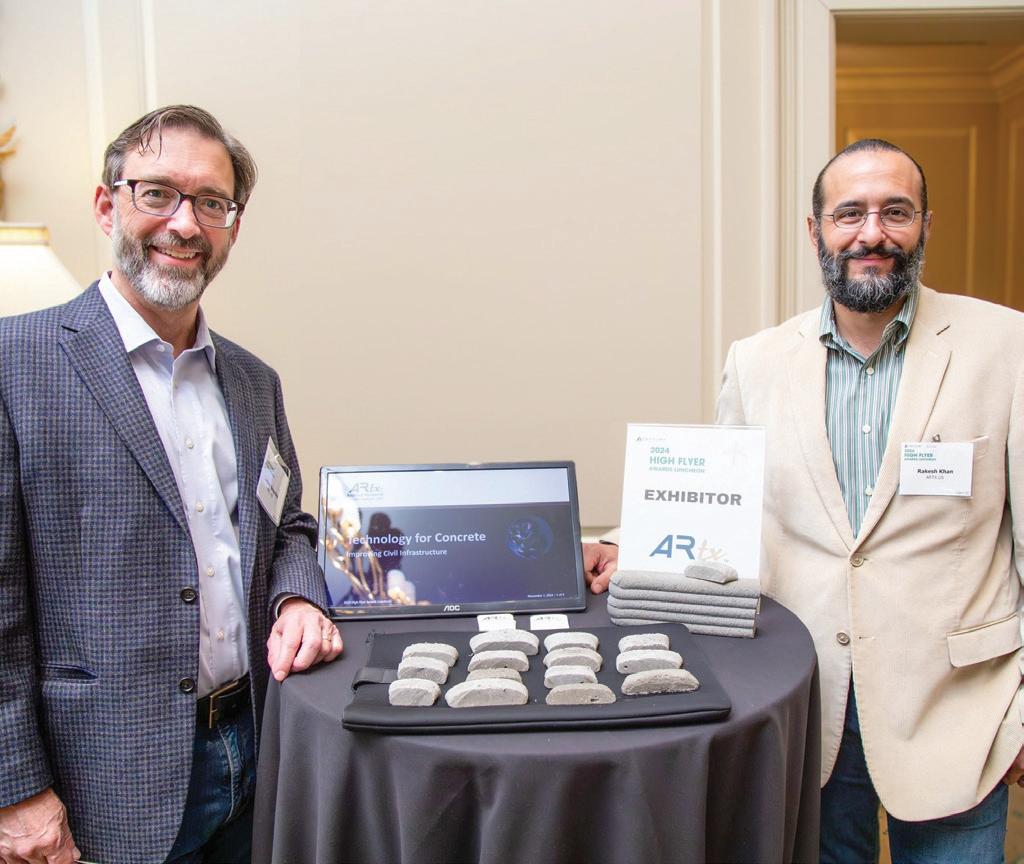
5 West Hargett Street, Suite 600 Raleigh, NC 27601
919-715-7272
info@sbtdc.org

UNC Charlotte Makes a Difference for North Carolina
With a designation of Carnegie R1 status — indicating “very high research activity”— UNC Charlotte continues on a path to becoming one of the country’s preeminent public research universities. Chancellor Sharon Gaber defines this achievement as “a win not only for the university but for the region.”
R1 institutions offer extensive doctoral programs, attract and retain leading faculty, and draw significant public and private funding. They fuel economic growth and strengthen the regional workforce — with every invested research dollar generating four times its impact, and drawing skilled professionals four times more effectively than degree output.
Through ten internally funded research centers and 11 UNC System centers and institutes, plus laboratory- and field-based research conducted by hundreds of faculty members, postdoctoral fellows, graduate and undergraduate researchers, and external partners, UNC Charlotte is making a difference in health care and life sciences, advanced manufacturing, energy, innovative technology, business leadership, arts and culture — and more.
UNC CHARLOTTE’S RESEARCH TRAJECTORY:
• Carnegie R1 designation, Feb. 2025
• Among the country’s fastest-growing research universities, climbing 46 spots in 2023 to the top 20% (NSF HERD)
• Top 20% for computer and information sciences
• Top 30% for social sciences, physics, engineering, chemistry
• Third-largest public research university in North Carolina, and the only one in the state to rank among the nation’s most innovative schools (2025 U.S. News & World Report)
• $92 million in research and development expenditures, 2023
• 146 new inventions, 239 patents filed, 18 spin-out companies created, 2020-24: top five nationally per research dollar spent for patents filed and new startups
LEADING THE WAY IN SCIENCE DISCOVERY
• Chemistry and biological sciences researchers are using artificial intelligence to revolutionize gene therapy, matching medical treatments to patients’ biology.
• Bioinformatics researchers and their external partners discovered that tailoring the timing of COVID-19 boosters – depending on one’s past infections and geographic location –leads to better outcomes.
• Nanoscale chemistry students developed a compound that reveals the presence of common illicit drugs. The awardwinning invention can test for fentanyl, heroin and cocaine on the spot, allowing law enforcement and health care providers to test for substances quickly.
DRIVING INNOVATION IN ADVANCED MANUFACTURING
• The Center for Precision Metrology influences manufacturing products and processes from microchips to airplanes, employing hair-splitting accuracy to air travel safety, vehicle fuel efficiency and cell phone operability.
• The Center for Additive Manufacturing of Advanced Ceramics convenes UNC System researchers and industry and government laboratories to drive innovations such as 3-D bioprinting for creating customized parts for tailored prosthetics and regenerated joints and ligaments.
MEETING ENERGY’S ECONOMY-DRIVING DEMANDS
• The Energy Production and Infrastructure Center (EPIC) is tackling large, multidisciplinary research projects like electric charging of rolling stock, energy data analytics and smart grids.
• Researchers from the North Carolina Battery Complexity, Autonomous Vehicle and Electrification (BATT CAVE) Research Center are driving solutions for next-gen batteries for vehicles, smart cities and intelligent systems — and building batteries for maximum efficiency, effectiveness and optimization in autonomous vehicles and remote-controlled devices.
DEVELOPING NEW TECHNOLOGIES FOR AI, DATA SCIENCE AND CYBERSECURITY
CYBERSECURITY
• Designated a National Center of Academic Excellence in Cybersecurity for Cyber Research through 2030 (since 2008) and a Center of Academic Excellence for Cyber Defense Education through 2028 (since 2001) by the National Security Agency
• Federal CyberCorps Scholarship for Service site: 144 graduates since 2002; 15 students currently in undergraduate and graduate programs
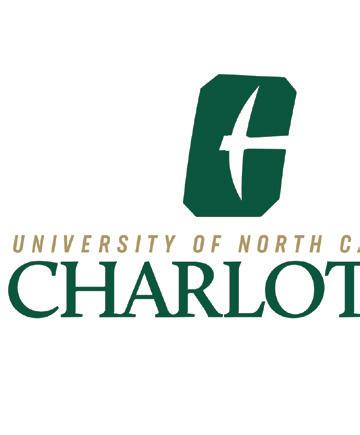


• First School of Data Science in the Carolinas
• Ph.D. in data science (fall 2025); bachelor’s degree in data science; NC’s only bachelor’s degree in sports analytics; M.S. and graduate certificate in health informatics and analytics; M.S. and graduate certificate in data science and business analytics
• Groundbreaking research: Predicting and mitigating spread of disease, reducing risk for financial institutions, using big data to determine flooding and landslide risks, training business leaders
• Bachelor’s and master’s degrees in AI (forthcoming); concentration in AI, robotics and gaming for computer science majors; minor in AI for non computer science majors; graduate certificate in applied AI
• CO-LAB, part of the city of Charlotte’s AI-cybersecurityenergy-focused North Tryon Tech Hub, provides entrepreneurs and innovators access to university expertise for tackling realworld challenges.
• The Center for Leadership Science uses AI and virtual reality tools to observe leader behaviors and determine improvements, potentially redefining the societal meaning of leadership, informing leadership training and improving organizational systems.
SOLUTIONS FOR A VIBRANT, WORLD-CLASS CITY
• The Cato College of Education applies research-based methods to teaching reading. Backed by the Mebane Foundation, the college offers opportunities to Charlotte Mecklenburg Schools to assure students are reading proficiently by the third grade.
• The Charlotte Regional Data Trust helps local government agencies and nonprofits analyze and interpret data that illuminates challenges faced by individuals and families.
9201 University City Blvd. Charlotte, NC 28223
704-687-8622
charlotte.edu

UNC Greensboro (UNCG) is emerging as a national leader in research that strengthens the protection, health, and career advancement of military service members, veterans, and their families. North Carolina is home to one of the nation’s largest active-duty and veteran populations, making UNCG’s commitment to addressing military challenges through research, innovation, and collaborations, mission critical.
At the forefront of this commitment is the launch of the Institute for the Convergence of Optimizing Methods for Military Advances for National Defense or iCOMMAND, at UNCG. iCOMMAND serves as a cutting-edge hub that unites researchers to develop advanced solutions that enhance military readiness, defense technologies, and veteran reintegration. The Institute bridges the gap between academic research, Department of Defense priorities, and military installations across the state.
The challenges facing the military are complex and evolving fast. Solutions to them require interdisciplinary approaches, which is where iCOMMAND’s ability to bring together researchers, front-line troops and military leaders creates new opportunities for a stronger military.
iCOMMAND’s initiatives include:
• Holistic health and fitness programs to prepare soldiers for combat and boost their performance.
• Applied science and technology to create functional and protective materials for the warfighter.
• Workforce development programs for military personnel transitioning to civilian life, military-affiliated students, and students interested in defenserelated careers.
The work undertaken by iCOMMAND is a result of several initiatives, collaborations, and partnerships with defense installations and labs.

Unlike athletes, soldiers do not have an off-season time, which means they must stay prepared year-round. Their physical demands include sustained aerobic activity during combat, followed by high-intensity anaerobic exertion as they advance mission-critical objectives. UNCG’s research strengths in health and wellness positions its faculty to redefine military fitness by developing research-driven training to better prepare soldiers for combat while protecting their long-term performance.
For example, through a multi-institutional collaboration, Dr. Erin Reifsteck, an associate professor of kinesiology, works with active-duty service members at Fort Bragg to maintain their physical readiness. The work involves equipping soldiers with the best resources to achieve peak physical and mental readiness, reduce injuries, and enhance performance. Reifsteck and her collaborators have developed and are testing a mobile app that uses place-based notifications to improve health behaviors.
Back on campus, Reifsteck, along with her kinesiology colleague Dr. Michael Hemphill, and UNCG’s Military-Affiliated Services Director Chris Gregory are working on ways to help veteran students find academic and social supports on campus, as well as maintain or improve their health and fitness.
Researchers like Dr. Sherine Obare, Dr. Tetyana Ignatova, and Dr. Yirong Mo are leading an initiative titled Next Generation Protective Materials for Soldier Empowerment (Next-Gen ProMiSE) that bridges collaborations in materials science, artificial intelligence, and sensors while building collaboration with faculty across the State in partnership with the DEVCOM Soldier Center. The work, supported by the UNC System Research Opportunities Initiative, is developing technologies, including wearables, sensors and protective measures. The research has led to innovations that are urgently needed by soldiers on the battlefield.
Furthermore, UNCG scientists are harnessing the power of artificial intelligence (AI) to accelerate the discovery and design of advanced materials that enhance soldier protection on the battlefield. By using machine learning algorithms to analyze vast datasets, researchers can quickly identify material combinations with optimal strength, flexibility, and durability.
In North Carolina, over 20,000 members of the military transition to civilian life each year. Many of them will need additional education and training to build careers. Understanding how universities like UNCG can best support those veteran students is critical to their success. iCOMMAND creates frameworks that help service members transition into high-value civilian roles by aligning their military skill sets with workforce demands in fields such as information systems, supply chain management, manufacturing, biotechnology, cybersecurity and AI.
In partnership with the DEVCOM Soldier Center, Dr. Chartanay Bonner, Director of Strategic Research Initiatives and Research Development, in collaboration with Dr. Charlene Mello, have launched the Defense Research Experience and Mentored Career Exploration, or DREaM Scholars Program. Funded by the Department of Defense, this program provides students with research experiences, professional development, and mentoring. It sets them on the path to civilian careers that support defense programs.
North Carolina’s military ecosystem generates approximately $80 billion in gross state product and supports 653,000 jobs. This network includes everything from high-tech startups to long-established defense contractors. UNCG’s iCOMMAND extends beyond research and workforce development to create potential defense technology breakthroughs that will spark new companies, generate spin-offs with civilian applications, create high-paying jobs and attract investment to the state.

For North Carolina’s business community, iCOMMAND offers a unique value proposition. Companies looking to engage with cutting-edge research, access skilled talent, or explore defenserelated opportunities now have a clear pathway through the institute.

Across campus and in our communities, University of North Carolina at Chapel Hill’s faculty, students and staff serve as global leaders in Artificial Intelligence (AI) research and innovation, translating groundbreaking discoveries into real-world solutions that address critical challenges in healthcare, the environment, and beyond.
This ambition is supported by over 150 AI faculty experts, like Dr. Jeffery Stringer, whose team developed a novel technology combining AI algorithms with a handheld ultrasound device,
significantly reducing the need for trained staff. This innovation, initially for developing nations, now offers a powerful solution for maternity care deserts in the US, including 19 counties in North Carolina where pregnant patients currently lack local ultrasound access.
Dr. Stringer’s work on the AI-guided ultrasound received pre-commercial grant support from the UNC Institute for Convergent Science, which brings together imaginative, crossdisciplinary teams to move ideas from basic research into
transformative real-world applications. These efforts to bolster teamwork among researchers and inventors with varied areas of expertise will continue to prove essential for solving complex, multi-pronged problems. In this vein, we see AI’s ability to link concepts and rapidly explore ideas across previously disconnected domains as a catalytic force for the scientific innovation needed to solve modern grand challenges.
While AI has only recently captured mainstream attention, it’s not new to researchers at UNC-Chapel Hill. Tar Heels have been innovating with AI for over a decade, producing more than 3,000 publications advancing the field. To seed future impact, in early 2025 Carolina launched its AI Acceleration Program, an initiative providing funding, mentorship and resources for groundbreaking AI projects.
We’re also investing in cutting-edge infrastructure to unlock the transformative potential of our data assets. This includes ensuring secure and ethical access to data, providing researchers with the tools and resources to analyze responsibly everything from de-identified health records to valuable datasets. Other efforts include expanding our advanced computing power and increasing our GPU capabilities to support the demanding computational needs of modern AI research.
To foster a vibrant AI ecosystem, we are optimizing AI expertise by supporting faculty AI research innovation, providing resources and mentorship to faculty pursuing groundbreaking research. We are also empowering education and training, equipping the next generation of AI leaders with the skills and knowledge they need to thrive in this rapidly evolving field.
Our strategy establishes a strong foundation for AI research and innovation by developing best-in-class data management practices. Our Research Data Management Core (RDMC) provides researchers with the tools and expertise to manage, share, and utilize data effectively and securely.
At Carolina, we also understand that harnessing the positive
potential of AI isn’t a go-it-alone endeavor. That’s why we formed the campuswide UNC AI community, founded by the Office of the Provost, which brings together nearly 600 students, faculty, researchers and industry partners who are actively working on AI projects or are interested in collaborating with other AI enthusiasts. This initiative is catalyzed by the University’s innovation hub called the Innovate Carolina Junction, which is located in downtown Chapel Hill.
Carolina’s innovation hub is also reaching beyond Chapel Hill to convene leaders from other universities to explore trends in how AI and other emerging technologies are rapidly transforming the professional world. After hosting an innovation summit that brought together the leaders of 50 innovation hubs from 22 states, we conducted in-depth interviews with hub leaders and published the 2025 best practices report “How Will University Innovation Hubs Shape the Future of Work?” Among other findings, the report sheds new light on how university hubs equip their constituents with skills in AI, robotics, cybersecurity, and other technologies that will redefine tomorrow’s workforce.
We are also fostering collaborations across disciplines and with external partners to accelerate AI research funding and translate research into real-world impact. For instance, in spring 2025, Launch Chapel Hill—a startup accelerator formed via a collaboration between the University and Town of Chapel Hill— forged a new partnership with KPMG to offer a novel AI-enabled accelerator program focused on innovation frontiers like AI, quantum computing, humanoid robotics, semiconductors and microchips, crypto and digital assets, automated manufacturing, and biotech and life sciences. Unlike traditional models, this new accelerator guides startups to rapidly refine their customer discovery efforts and uses AI capabilities to help the companies identify initial pilot projects, partners, or customer engagements.
By investing in our infrastructure, cultivating talent, and fostering a collaborative research environment, UNC-Chapel Hill is committed to pushing the boundaries of what’s possible with AI, creating a brighter future for all.



The intersection of healthcare and business is a rapidly evolving frontier, where collaboration is unlocking groundbreaking advancements that address complex challenges. At Wake Forest University, this intersection isn’t just theoretical – it’s a thriving reality. Through a growing partnership between the School of Business and the School of Medicine, business acumen meets clinical expertise to cultivate cutting-edge research and drive real impact in how healthcare is delivered to patients across the country.
These collaborative, life-changing healthcare solutions stem from a recently assembled, multidisciplinary collective of faculty members spanning a variety of disciplines across medicine and business. The group is spearheading projects that draw on fields as diverse as operations, organizational behavior, information systems, strategic management, and more — working across a broad spectrum of healthcare domains to address some of today’s most pressing challenges.
“Collaborations between the School of Business and the School of Medicine create opportunities to bring complementary perspectives to complex healthcare challenges,” said Dr. Jennifer Claggett, AT&T Faculty Fellow and Associate Professor at the School of Business. “For example, in my discipline of Information Systems, we use systems thinking to better understand how technologies can be designed and implemented to support both clinicians and patients. These kinds of interdisciplinary efforts –like those fostered through this new initiative – are essential for driving meaningful healthcare innovation.”
Claggett is also an associate at the Wake Forest School of Medicine’s Center for Artificial Intelligence Research (CAIR) and the Center for Healthcare Innovation (CHI), where she collaborates on interdisciplinary projects at the intersection of technology, data analytics, and healthcare.

Another member of the collective is Dr. Amol Joshi, who serves as Thomas H. Davis Professor in Business and an Associate Professor of Strategic Management. He is also an Affiliate Faculty Member of the School of Medicine in the Centers for Healthcare Innovation, Artificial Intelligence, and Precision Medicine.
“One of the unique things about Wake Forest is that though we are perhaps a smaller institution, we have a lot under one roof,” he says. “I have a joint appointment on the faculty in the School of Medicine, and just yesterday I was on a call with folks from the School of Law and Engineering Department. We’re all working on the regulation of software as a medical device, which intersects all our areas of expertise.”
One example of this synergy is LAUNCH, hosted by the Center for Healthcare Innovation (CHI). LAUNCH is an annual incubator, competition, and accelerator program that brings together experts from across the Atrium Health enterprise. Created in 2022, this weekend-long event provides a platform for trailblazers in medicine, business, and technology to showcase innovative ideas while competing for crucial funding and resources to bring their projects to life.
“While LAUNCH is structured as a competition, its real value lies in the collaboration it fosters,” said Dr. Claggett. “Many of us from the School of Business serve as mentors and consultants during the event, helping clinical teams shape their proposals, tell their stories more effectively, and present a compelling business case for their ideas.”
Through the impactful research these joint efforts are producing, faculty and students are not just observing healthcare challenges; they’re solving them. Notably, there are several standout projects currently shaping the future of healthcare innovation at Wake Forest University.
Case in point, a collaborative study led by researchers from the Wake Forest School of Business (Dr. Claggett, Dr. Joshi and Dr. Stacie Petter, the Associate Provost for Faculty Affairs) and School of Medicine (Dr. Eric Kirkendall) and the University of Tennessee’s Research Foundation (Dr. Todd Ponzio) proposes a comprehensive framework to strengthen the design and delivery of remote patient monitoring (RPM) programs – from secure data collection to producing actionable insights for clinicians.
While RPM is often seen as a key part of healthcare’s future, implementing it effectively remains complex. By addressing barriers to scale and sustainability, the project offers a path forward for expanding access and promoting equity in healthcare delivery.
In another new study, Dr. Claggett and Dr. Elena Karahanna (University of Georgia) identify specific ways hospital technologies can better support timely, effective teamwork, especially in fast-paced environments like emergency rooms. Electronic health records (EHRs) were created to store patient data, but how and when they’re accessed by healthcare professionals make them well-positioned to impact coordination.
By analyzing real-world episodes of clinical coordination, the researchers surfaced key features that may help teams share information when it matters most. They also discovered that the right combination of features depends on the type of task.
Catalyzed by a shared spirit of collaboration and striving to create a better world, these and other ongoing studies are offering a framework to address pressing issues impacting healthcare systems that will ultimately help enable safer, more efficient care today and in the future.

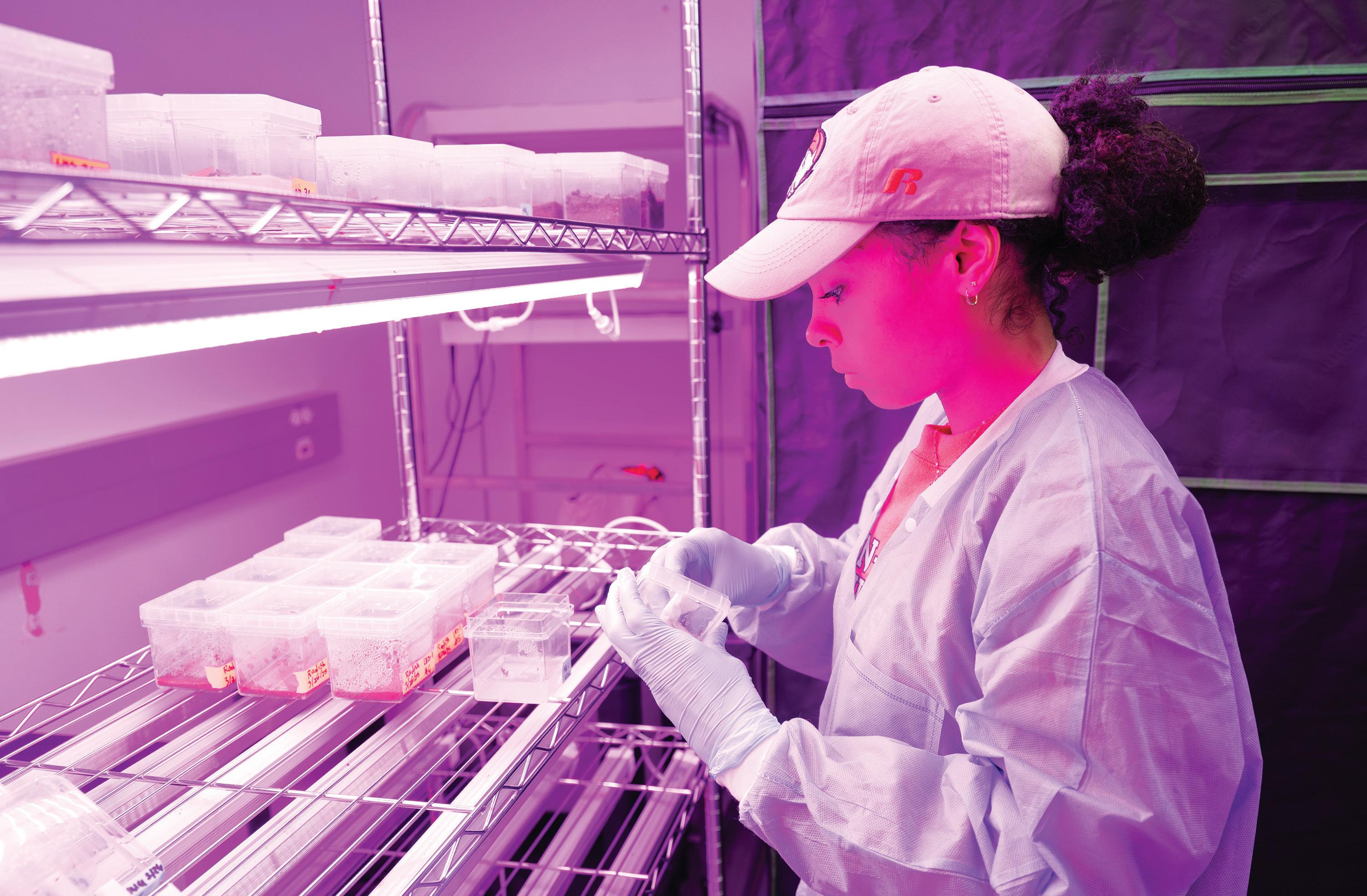
How Winston-Salem State University’s Astrobotany Lab is growing the future of space agriculture
When WinstonSalem State University’s (WSSU) Astrobotany Lab was established in 2018, few could have predicted its rapid ascent to national prominence. Founded by Dr. Rafael Loureiro, associate professor of botany and plant physiology, the lab holds the distinction of being both the only space plant biology lab at a Historically Black College and University (HBCU) and the sole HBCU with a Space Act Agreement with NASA’s Kennedy Space Center Crop Production Team.
Loureiro launched the lab with support from a new investigator award through an NC Space Grant in 2018, enabling pilot research projects, crucial partnerships and foundational infrastructure. The grant included funds for student scholarships, research stipends and lab equipment, laying the groundwork for an initiative that would grow into a national model for undergraduate space research.
Their research mission: to explore how plants adapt, survive and thrive beyond Earth.
Astrobotany is an emerging field that refers to the study of plant life and plant interactions in space environments. This includes understanding how plants respond to spaceflight and whether they can grow sustainably on other planets.
WSSU’s research includes experiments with a variety of crops with future aspirations to explore staple grains like wheat.
While traditional crop science focuses on growth under Earth’s gravity, astrobotany asks a more radical question: Can we grow food off-planet? WSSU is working to answer that question.
In the lab, the students focus their research efforts on advancing regolith-based agriculture by evaluating plant physiological and developmental responses to high-fidelity lunar and Martian soil simulants such as LHS-1, LMS-2 and MGS-1 (soil-like materials that mimic what’s found on the moon and Mars).
Their studies investigate how these substrates affect germination, root architecture, and overall crop viability under extreme abiotic stressors including elevated calcium, iron, aluminum and radiation. Central to the lab’s approach is the integration of tailored microbial consortia to enhance plant resilience and nutrient acquisition in nutrient-poor regolith environments. By coupling these strategies with gene expression analysis and morphological assessments, the astrobotany lab work supports the development of sustainable agricultural systems for long-duration space missions and off-world habitats.
WSSU’s partnership with NASA began with internships, lab visits, and shadowing NASA crop production scientists at Kennedy Space Center. It culminated in a Space Act Agreement, a rare and prestigious collaboration, further elevating WSSU’s scientific reach, championed by Dr. Gioia Massa, senior scientist at Kennedy Space Center space crop production.
Biology majors who apply and join the astrobotany lab juggle rigorous coursework alongside 10-plus hours per week in handson research often exceeding that time to support multi-phase experiments. Their efforts have been funded and supported consistently by NC Space Grant, and NASA, enabling onsite NASA collaboration and Capitol Hill visits.
Until spring 2025, the students’ research was conducted in simulated conditions. On April 14, 2025, WSSU took a quantum leap. Three students watched from ground control as their plant samples soared aboard Blue Origin’s all-female flight NS-31, which included former NASA rocket scientist Aisha Bowe, who personally carried the samples, alongside journalist Gayle King and pop artist Katy Perry.
This milestone marked the first time WSSU’s experiments left Earth’s atmosphere – and the first HBCU-led plant research conducted in suborbital space.
Students tracked six specific genes involved in nutrient transport, cellular metabolism and molecular stress signaling. Samples sent aboard Blue Origin were compared to identical Earth-based controls, with a focus on analyzing gene expression changes triggered by microgravity.
“By participating in this suborbital flight experiment, our



students gain hands-on experience that will help shape the future of astrobotany, space exploration and sustainable food production beyond Earth,” Loureiro said.
The mission transcends campus pride. As WSSU Chancellor Bonita J. Brown noted, the collaboration gives HBCU students real leadership in space science and highlights the crucial role these institutions play in shaping humanity’s future beyond Earth.
While the project offers exciting implications for space travel, its applications on Earth are just as significant. Understanding how plants adapt to harsh environments informs indoor vertical farming, hydroponic systems and climate-resilient agriculture. These advances have the potential to address global food insecurity and environmental change.
The lab continues to engage in partnerships, funding students and bridging the gap between academic ideas and orbital platforms.
Loureiro’s vision is to build a pipeline of HBCU students trained in space biology who can lead future missions in agriculture, biotechnology and planetary science.
As Black Engineer magazine noted, “What began in a small lab at Winston-Salem State University is now reaching the edge of Earth’s atmosphere.
In the words of Chancellor Brown, WSSU isn’t just participating in space science – it’s leading it. This mission is a testament to the critical role that HBCUs play in advancing space research and preparing our students to lead the future of exploration.”




































Hurricane Helene hit western North Carolina hard, causing more than $50 billion in damage. But the region is rebounding, welcoming visitors and new businesses thanks to equal parts resilience, generosity and community spirit.
It has been 10 months since Hurricane Helene roared north from the Gulf, dropping upward of 31 inches of rain on western North Carolina. That pounding washed away mountain slopes, roads, businesses and homes, causing more than $50 billion in damage. And while a haze of uncertainty remains over the 18-county region, whose natural beauty is internationally known, it’s clear that its residents’ resiliency will see it to better times.
Recovery efforts began as soon as the clouds parted, and they continue as a collaborative process. “While our region has much healing to do, the experience has only strengthened our spirit and generosity,” says Clark Duncan, Asheville Area Chamber of Commerce senior vice president of economic development. “I’ve been especially moved by the leadership of our business community,
the quiet philanthropy, and extraordinary investments made in caring for employees and our most impacted neighbors. Whether you are a resident, a visitor or a business investing in the region, the comeback is tangible, and the future is bright.”
Federal Emergency Management Agency, American Red Cross, Samaritan’s Purse and local groups, combined with convoys carrying supplies from churches and disaster outreach efforts elsewhere in the state, have brought relief to the region’s residents. Local efforts are rebuilding the economy. Asheville Area Chamber of Commerce organized a business scavenger hunt, and more than 50 businesses participated in Restaurant Week during January. The #WNCOpenForBusiness campaign highlights businesses, destinations, festivals and events that are ready for tourists,

which fuel a large portion of the region’s economy. “We live here, we have families here, and the hospitality has been woven into the fabric” says Vic Isley, Explore Asheville president and CEO. “Much of western North Carolina is open and ready and eager to welcome everyone. So, don’t feel worried. Feel hopeful and be a part of our collective comeback.”
Tourism isn’t the only industry mounting a comeback in western North Carolina. There have been announcements of jobs, commitments at industrial parks and plenty of reopenings. “The resilience of our business community is one of the most amazing things I’ve ever seen,” says Tommy Dennison, Asheville Area Chamber of Commerce director of member development. “We’re seeing businesses that sustained physical damage reopen in recent months and expect more to open through the summer.”









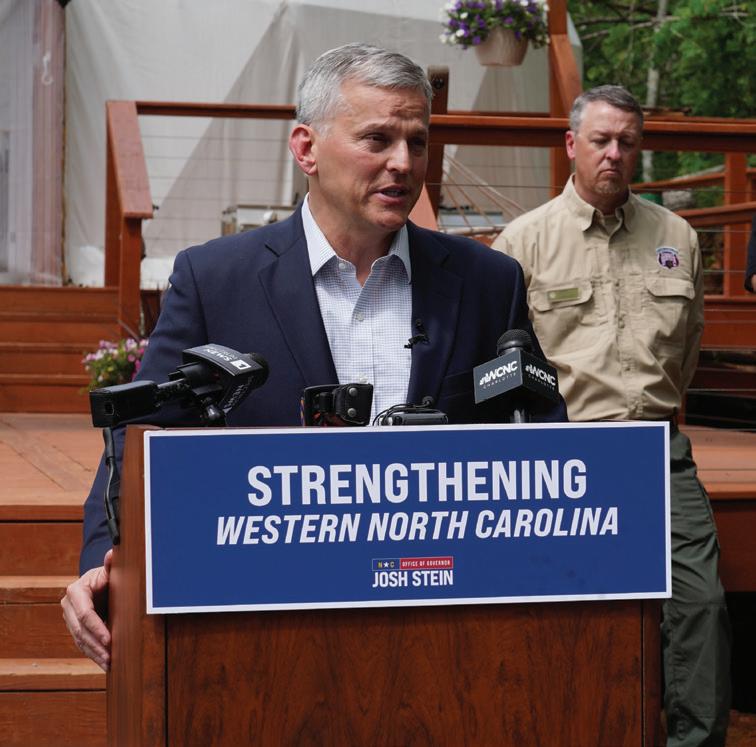





Gov. Josh Stein and state leaders have worked to provide funding to rebuild western N.C. As of late May, state lawmakers had approved $1.6 billion on various response programs. Several hundred million dollars more is likely to be approved, officials say.

















New Belgium Brew House. In May of 2025, New Belgium
the
































Swannanoa Grassroots Alliance was formed in its namesake Buncombe County community. It’s a network of residents, neighborhood groups, nonprofits, churches and businesses helping to rebuild. “This group grew out of existing neighborhood organizations as well as the organic gathering of volunteers immediately after the storm,” says Erin Leonard, Asheville Area Chamber of Commerce vice president of communications.
Asheville Area Chamber of Commerce launched Mountain Strong Fund for Business Recovery after Helene. It collected more than $1.1 million in donations. The money was distributed through grants to more than 55 impacted small businesses and 16 regional chambers of commerce last winter.
And community development financial institution Mountain BizWorks organized Asheville-Buncombe Rebuilding Together Grant Fund, which has distributed more than $4.4 million in grants to almost 400 small businesses through an effort that includes Buncombe County, city of Asheville and Asheville Area Chamber





























“Our 15,000-square-foot facility was flooded in Hurricane Helene,” says Bill Trometer, owner and founder. “We had over 40 inches deep of flood water and mud throughout the facility. All our office furniture and computers were ruined. All the drywall walls had to be ripped out and replaced. We had significant damage to our equipment and machinery. We lost almost the entire fourth quarter of revenue.”














of Commerce. “We definitely saw an outpouring of generosity post-storm and new collaborations emerge,” Leonard says. “Collaboration is part of the fabric of our community. Those connections and relationships were crucial post-storm and allowed the community to leverage those relationships to make things happen quickly.”
As of late May, LoveHendo Business Recovery Fund had awarded $272,000 to 90 Henderson County businesses affected by Helene. “We had never been here before in the mountains after a hurricane, so we did not know our next step,” says Brittany Brady, Henderson County Economic Development president. “Providing businesses with resources post-Helene is going to be instrumental in not only good business practices but also reminding companies how resilient we are and how far we can grow into the future. The plan for industry will be a checklist and for our office a vision for the next few years.”
Grants from LoveHendo and Mountain BizWorks are a lifeline for family-owned businesses such as Fletcherbased Asheville Thermoform Plastics.
Trometer’s business sits on 5 acres inside Cane Creek Industrial Park. It’s not considered a flood zone, so he didn’t have flood insurance. “We were on our own,” he says. “We applied for and received grants from LoveHendo and a recovery loan from Mountain BizWorks, and they have been extremely helpful toward our recovery. We are more than 90% back to manufacturing and about 75% complete on our facility repairs. Our recovery is a tribute to our dedicated employees and family who have and continue to work tirelessly to make it happen.”
Trometer started his company almost 30 years ago, and the family’s next generation is helping guide it into the future. “We got knocked down but not out,” he says. “And we are back, and we will be better and stronger than ever.”




Optimism is bubbling up across western North Carolina, and there’s plenty in the region’s tourism industry, especially in Asheville and Buncombe County. Visitors directly spent almost $3 billion there in 2023, when one in seven jobs — about 29,000 — were tourismrelated, according to a Tourism Economics study. “There is a sense of revival and renewal here,” Isley says. “The sense of belonging and place is stronger than ever. And while it’s sad to see some of our beloved businesses close their doors, it also is heartening to see others open and re-open, and that’s happening every day.”
Buncombe County Tourism Development Authority created a graphic illustrating the recovery journey from a natural disaster. It starts with predisaster — the warning, threat, impact and evaluating of planning and preparation efforts — and continues to the current disillusionment era and ends with the next chapter of reconstruction and re-emergence of a new normal routine.
The graphic’s accompanying Travel & Hospitality Community Update states: “Despite the remarkable progress we’ve made, this visual reminder confirms what many are feeling — we have a considerable journey ahead before reaching the reconstruction/new beginning phase. The graphic reveals we’ve entered that critical valley where processing grief and acceptance are essential before rebuilding can fully take hold. Yet, standing here in western North Carolina after experiencing Helene’s impact firsthand, we are more convinced than ever of our region’s resilience.
“This place, ancient in its natural beauty and rich cultural heritage, continues to evolve as it has for generations. And the people who are drawn to and bound by this place continue to be creative, steadfast and full of gumption. Within this evolution and dedication lies tremendous opportunity for thoughtful and intentional redevelopment.”
— Kathy Blake is a writer from eastern North Carolina.



Western North Carolina is open to tourists. The best way to give back is to come back — the most impactful thing to support western NC is to spend tourism dollars here.
Summer and fall events calendars across western North Carolina are offering visitors and residents plenty to do, from symphony performances to wilderness hikes. Each entry takes advantage of the region’s unique resources. In its westernmost corner — Cherokee, Clay, Graham, Macon, Jackson and Haywood counties — there’s Great Smoky Mountains National Park, Cherokee National Forest and Tail of the Dragon, an 11-mile stretch of road with 318 curves, every motorcyclist’s or sportscar enthusiast’s dream.
Grandfather Mountain, Tweetsie Railroad, Linville Falls, and hiking and camping are in the region’s High Country — Ashe, Watauga, Avery, Mitchell, Yancey, Alleghany and Wilkes counties. And the Foothills — Buncombe, Haywood, Jackson, Transylvania, Polk, Rutherford, Mitchell, McDowell, Madison and Caldwell — is home to Biltmore Estates, Blue Ridge Parkway, Chimney Rock State Park, Lake Lure, camping, ziplining and waterfalls.
Explore Asheville President and CEO Vic Isley says the region is ready to host visitors.
“I think the message is come out and have a great time,” she says. “When Gov. (Josh) Stein was here having lunch with some of the small-business owners, his message to the rest of the state was that the most fun public service you’ll ever do is to come to western North Carolina and support its small businesses.”
That’s good news. Buncombe County Tourism Development says more than 90% of businesses are locally owned and more than $541 million was spent on retail, $366 million on recreation and entertainment, and $787 million on food and beverage in 2023.

Long-range planning, along with recent business expansions and job announcements in western North Carolina, offer encouragement. Economic Development Coalition for AshevilleBuncombe County helped attract three relocations and nine expansions during the first three months of the year. They’re adding 1,540 jobs to the region. “[They’re a] much-needed boost of confidence for the region,” says Clark Duncan, Asheville Area Chamber of Commerce senior vice president of economic development.
“Buncombe County was fortunate to have navigated the obvious challenges of the past five years with a string of economic wins for our residents that total a record-setting $1.5 billion in new investment in our tax base. These include significant advanced-manufacturing investments from Pratt & Whitney, GE Aerospace, Borg Warner and System Logistics, locally headquartered expansions from Industry Nine, East Fork
and Poppy Handcrafted Popcorn as well as relocated [consumer packaged goods] headquarters for Legally Addictive Foods and Life’s Abundance.”
Aerospace company Pratt & Whitney, a world leader in the design, manufacture and service of aircraft engines and auxiliary power units, has more than 17,000 customers in more than 200 countries. It announced an expansion at its Asheville turbine airfoil factory in January. The $285 million investment will create 325 jobs. Their average annual salary will be $62,413, more than Buncombe County’s $54,416 average.
“[The expansion] is a testament to the region’s deep talent pool and industry leading partnership with AshevilleBuncombe Technical Community College,” says Sabrina Rockoff, Asheville EDC board chair.
Enka Commerce Park, west of Asheville in Candler, is home to 15 businesses, including Freudenberg Group, Haakon Industries, Magnera, New Belgium
Brewing, Southeastern Container, TSA Choice and Wicked Weed Brewing. In February, Asheville EDC announced the opening of a bridge and access roads, capping a decade of strategic infrastructure investment in the park. Buncombe County investments of more than $10 million supported the bridge overpass and completion of the Enka Heritage Parkway and Bob Lewis Sports Park. “These vital investments in modern infrastructure and state-of-the-art buildings will support continued economic growth in alignment with the AVL 5x5 Strategic Plan,” Rockoff says.
Asheville EDC launched its first five-year AVL 5x5 in 2010, uniting the city, county, business leaders, educational institutions and the community toward a common goal of growing employment, wages, target industries and economic vitality. Its latest installment runs through 2030. Its Signature Recovery Projects include the establishment of WNC Futures Factory. Six of the region’s community colleges and five














universities are designing the innovation hub to support local industries, helping them compete in the global economy and providing workforce training.
An annual site selection familiarization tour will be hosted to reinforce that Asheville and Buncombe County are open for business. EDC plans to show about 10 site consultants representing target industries, in conjunction “with state partners and other influencers who need to know the region’s comeback story,” during the multiday event.
EDC’s prognostication for 2040 includes adding $3 billion more to the economy than the current trajectory, increasing the average annual wage to $116,000 and having 4,600 additional jobs in target industries. “The ongoing work and value of economic development is highlighted especially during times like these,” Duncan says. “Events like the recession, pandemic or natural disasters rarely come with warning. It’s especially important as a state, and as individual regions and communities, that we are thinking strategically about how to prepare for and mitigate the impacts of these economic blows, through consistent and strategic economic growth.”
Henderson County unveiled a Recovery Action Plan in April. “[It includes] clear direction on disaster response for industry, the community and the organization,” says Henderson County Partnership for Economic Development President and CEO Brittany Brady. “We also ran a marketing campaign post storm called ‘Swift Recovery’ to highlight the resiliency of the county and being back open for business.”
Food-and-beverage manufacturer Lassonde has already acted on Henderson County’s message. It announced a $53 million expansion at its Hendersonville factory in January. The new single-serve production line will create 30 jobs. The company will spend an additional $20 million on innovation and efficiency at the plant, underscoring its commitment to a future in the region.











There’s no place like home—the food, the stories and, of course, the people. If your heart belongs to the Land of the Longleaf Pine, the North Carolina Channel is for you. Explore content that celebrates NC’s best destinations, history and culture, programs that spotlight local communities and stories that say, “Welcome home.”

pbsnc.org/ncchannel











